Byzantium I - II. (diptichon)
- 100 x 220 + 100 x 120 cm
- Oil-gold-canvas
- Painting by Tamás Náray
- The artwork is part of the 'Byzantium, the Cradle of Immortality' series
- SOLD
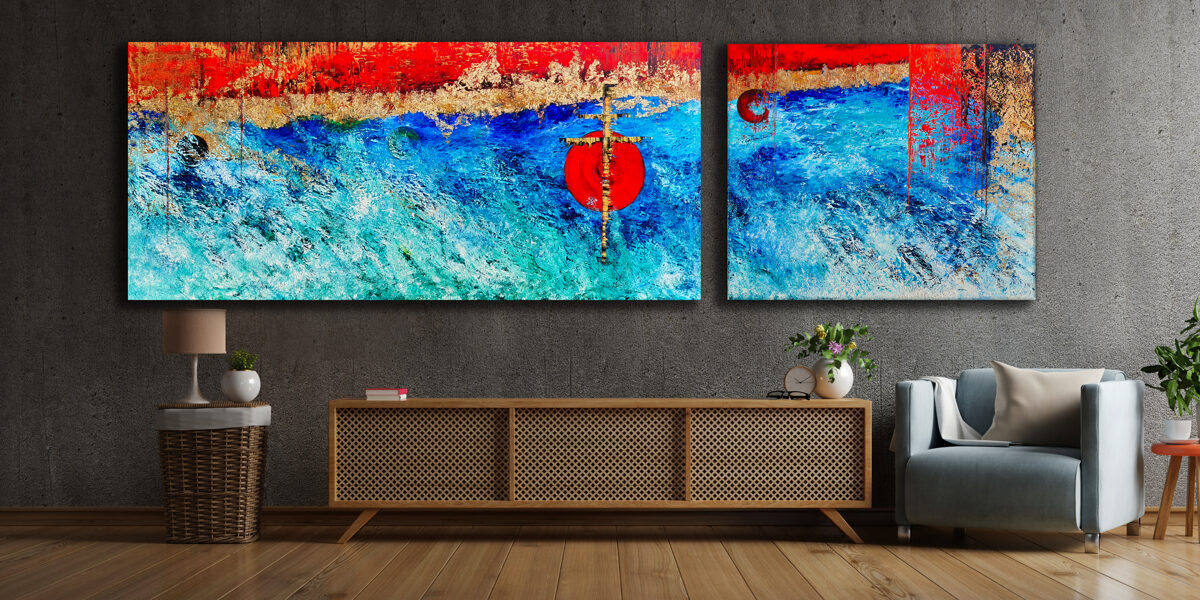

On July 16, 1054, the delegation of Pope Leo IX outcast Cerularius, the Patriarch of Constantinople, the highest ecclesiastical authority in the Byzantine Empire as a result of him refusing to acknowledge papal supremacy and the decisions of Western councils. Since Cerularius had the support of Byzantium, on the same day, he reciprocally excommunicated (exiled) the papal envoys and expelled them, leading to the split of christianity into Western Catholic and Eastern Orthodox factions.
Photos of the artwork:
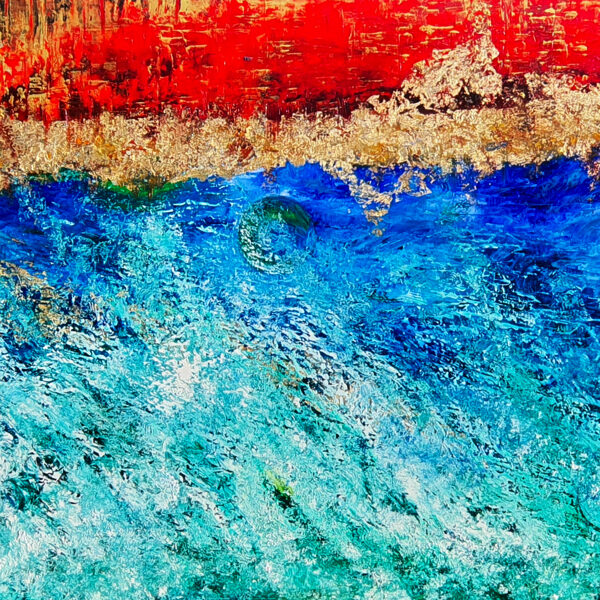
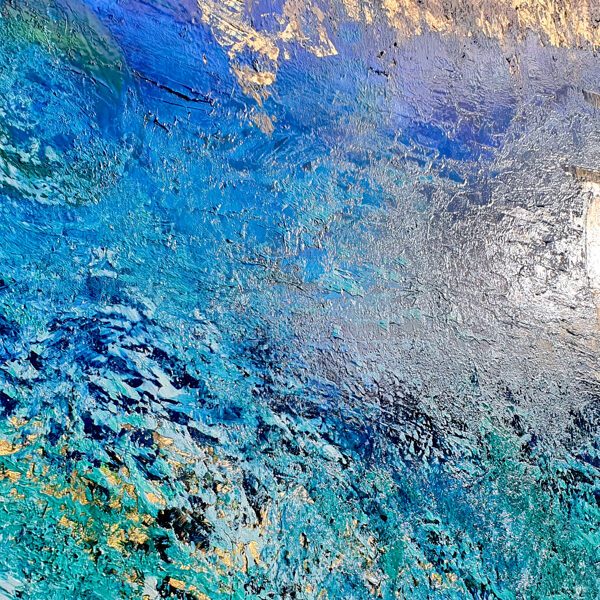
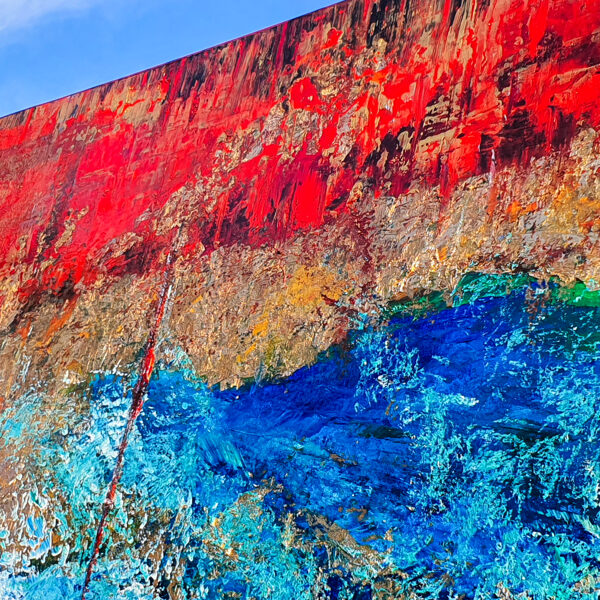
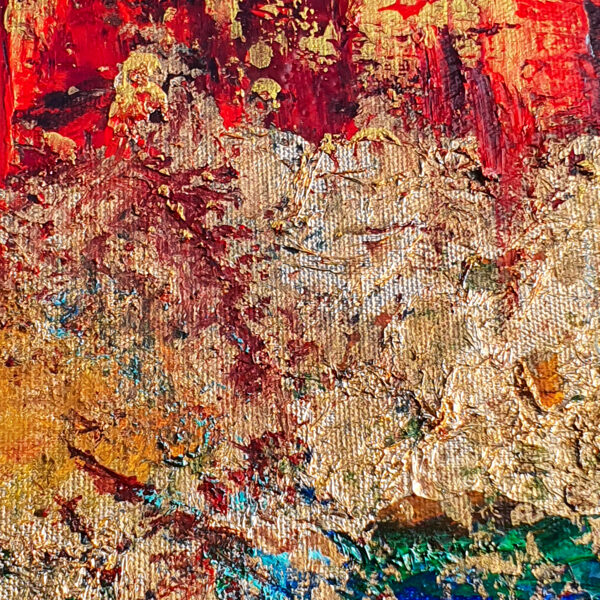
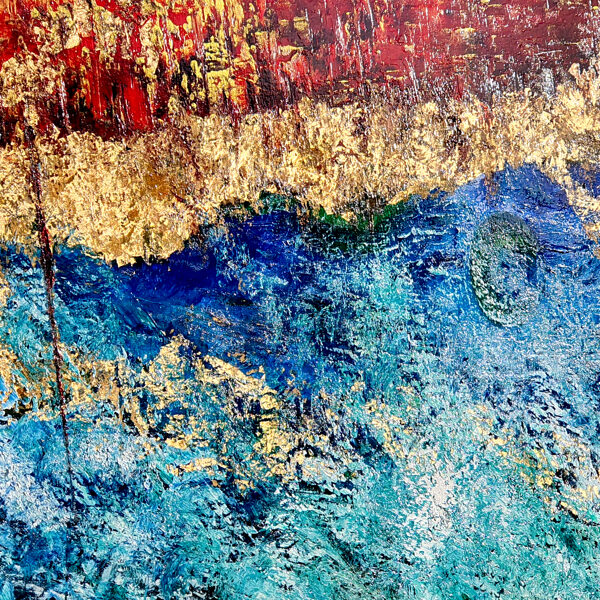
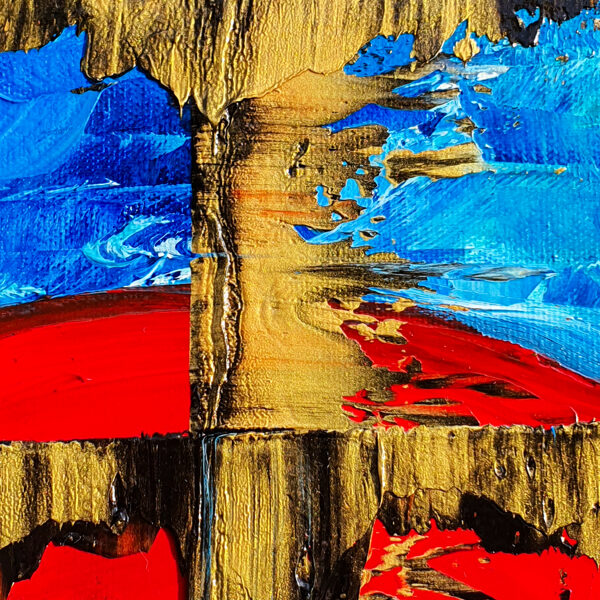
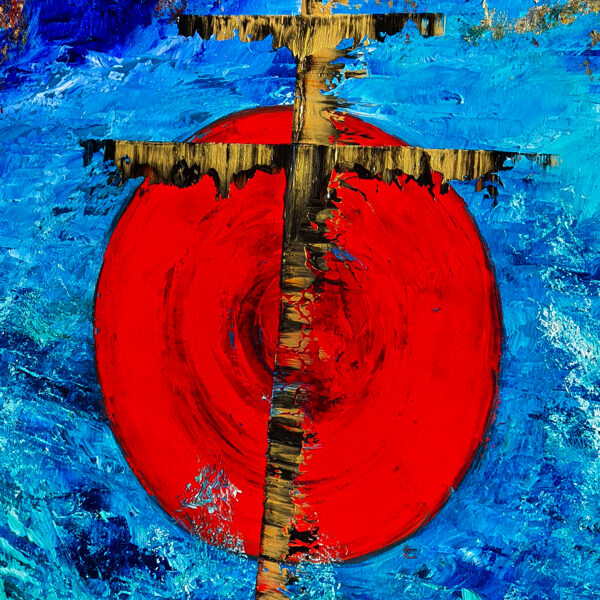
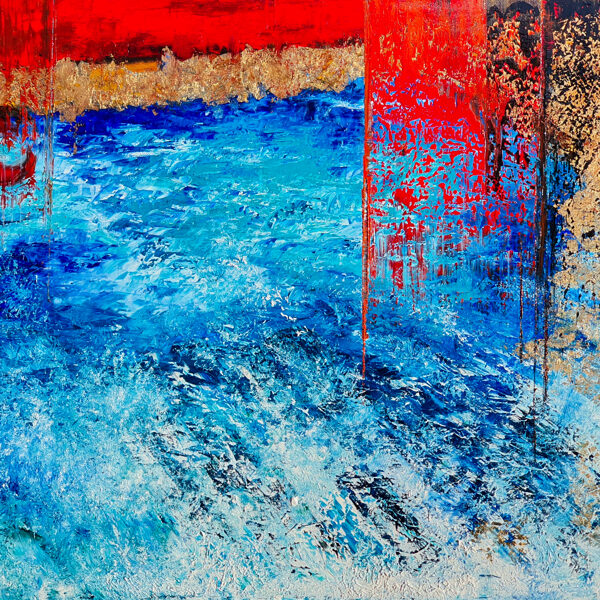
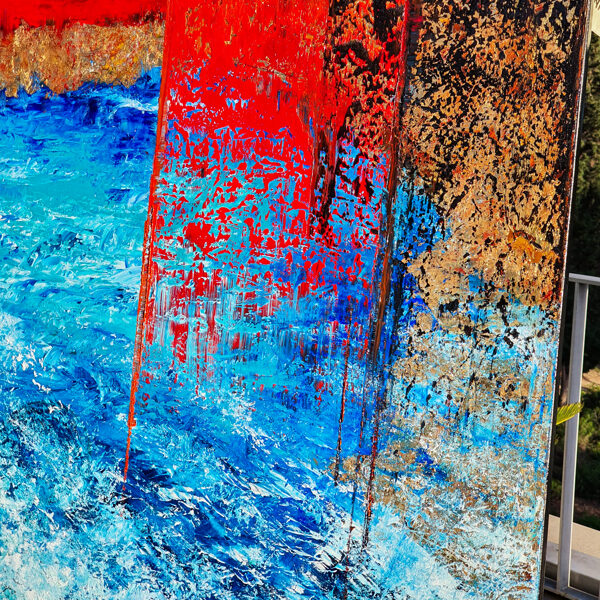
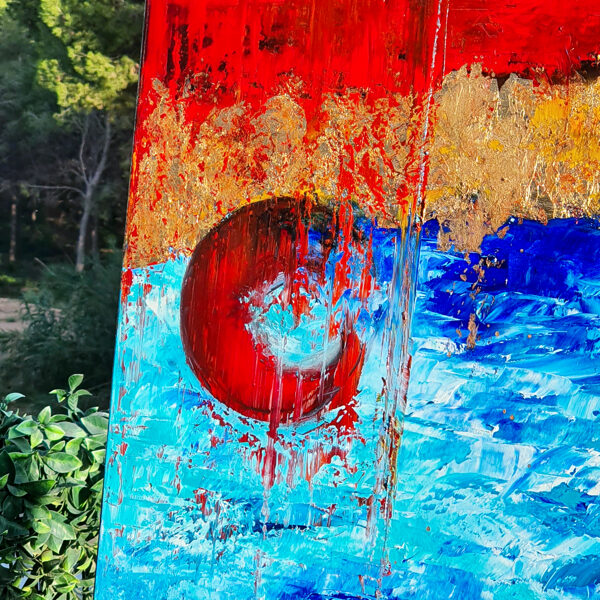
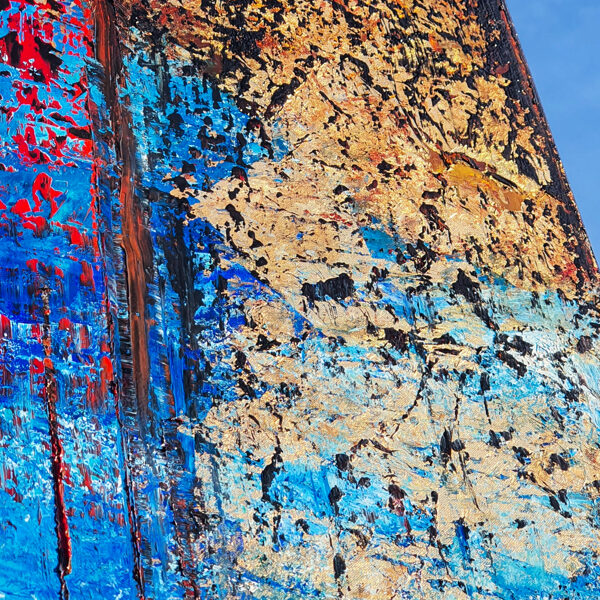
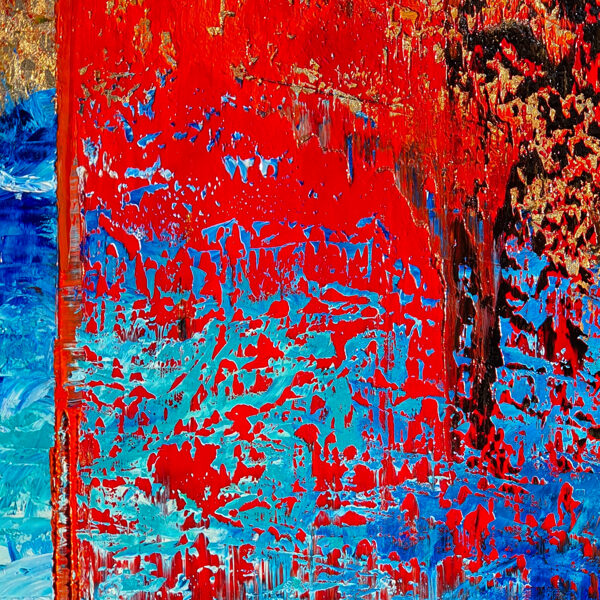
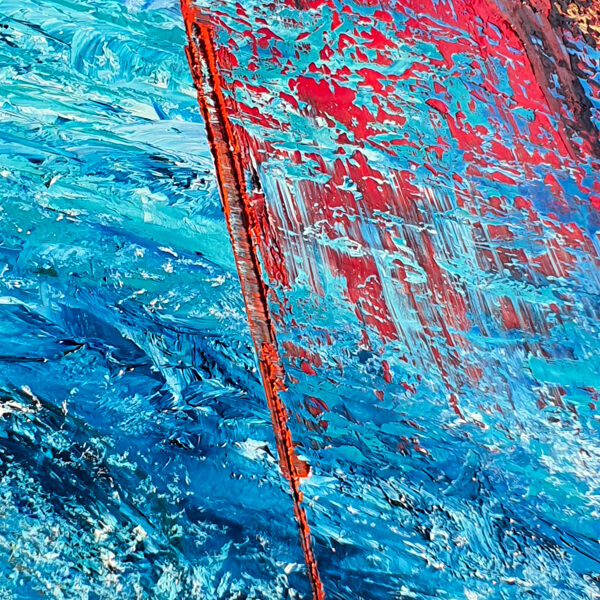
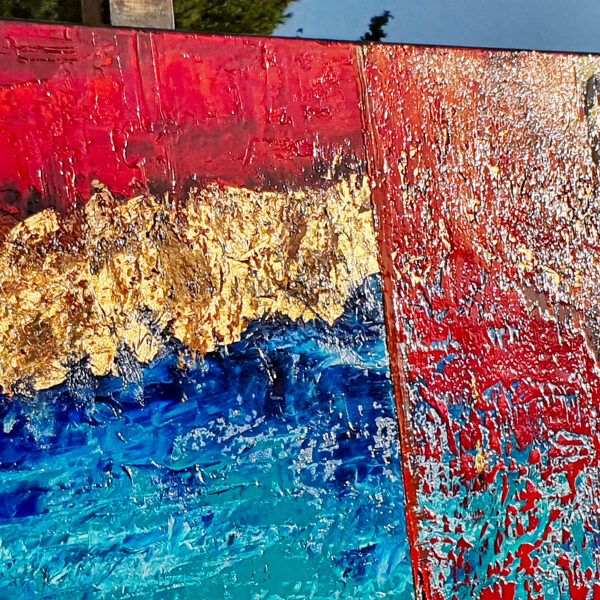

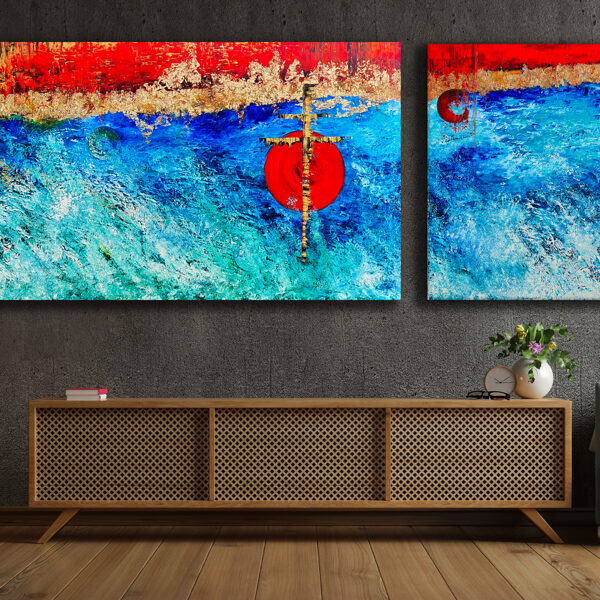
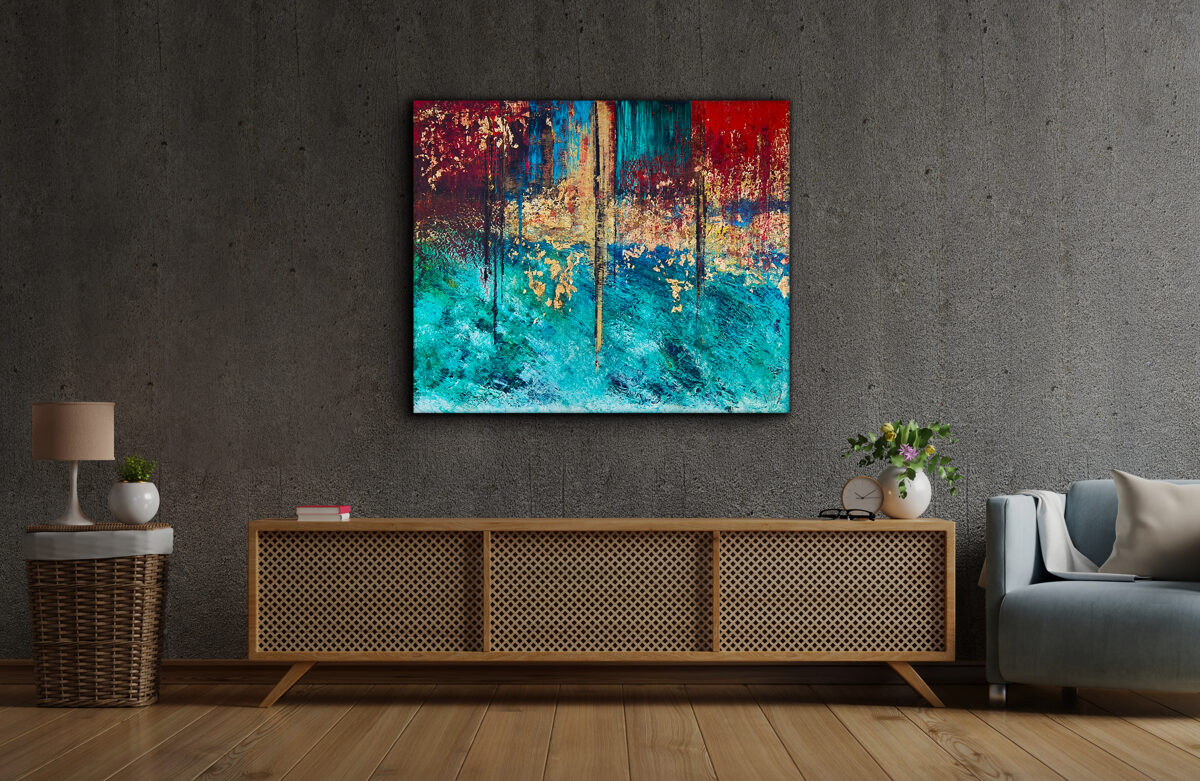
The first golden age of the Byzantine Empire, known as the early Byzantine period, lasted from the foundation of Constantinople until the 700s. Emperor Constantine the Great (r306–337) chose the city, named after the ancient Greek king Byzas, located on the shores of the Bosporus, as the new capital of the Roman Empire in 324. This is where the merging of Europe and Asia has come to be, and not just in a geographical sense.
Photos of the artwork:
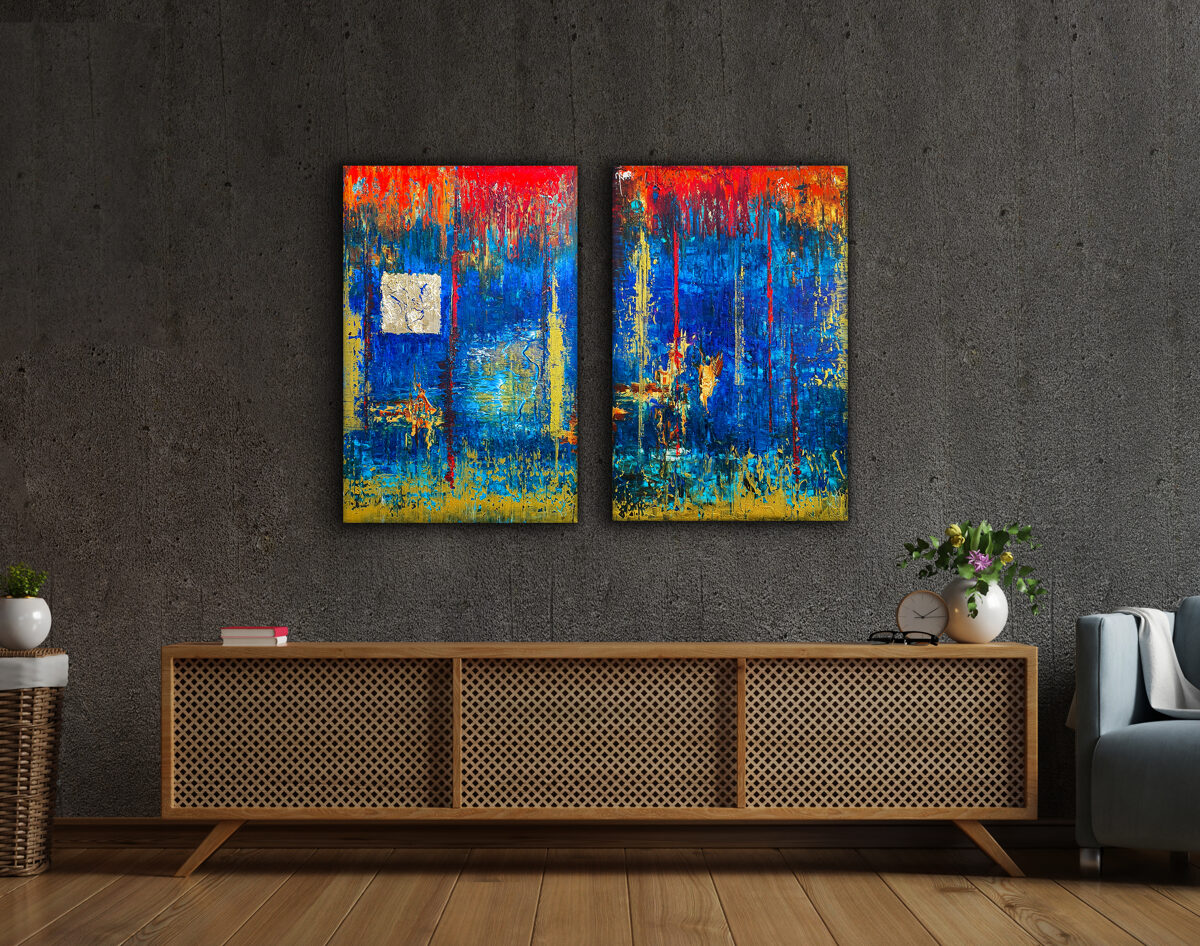
Mikhaél Choniatés in the above passages accumulates references from ancient Greek cultural heritage. He compares Chalkoutzés' struggle to recover the wealth demanded by the new Crusader rulers of Euripos to the suffering of the Danaids. The Danaids were condemned in the afterlife to fill an ever-leaking vessel with water as punishment for murdering their innocent husbands. This detail also illustrates the evolution of Greek-Roman mythology, as the precise nature of the Danaids' punishment became part of their myth only during the Roman imperial era.
Photos of the artwork:
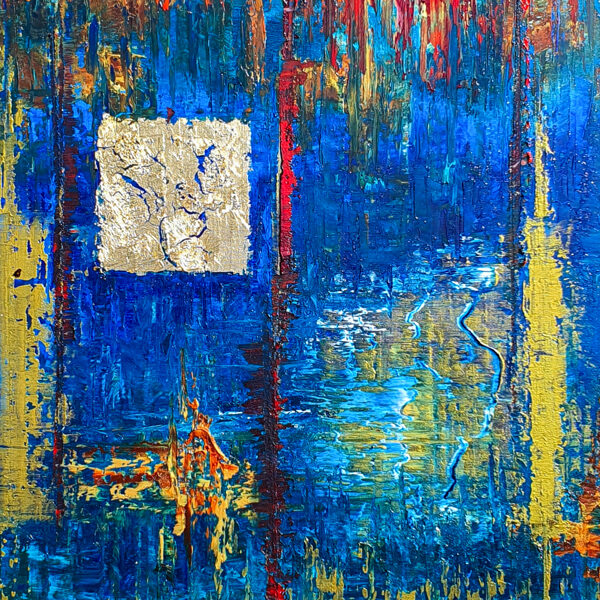
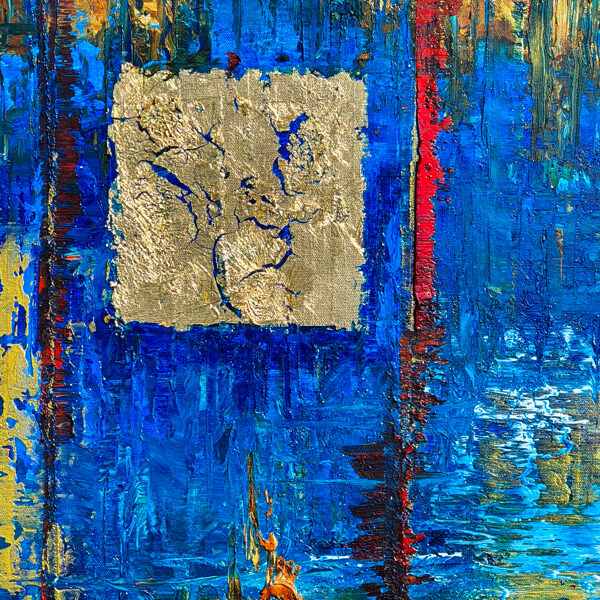
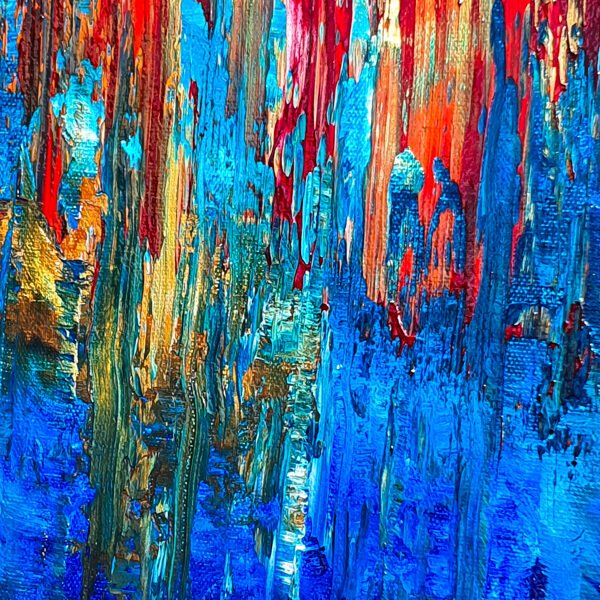
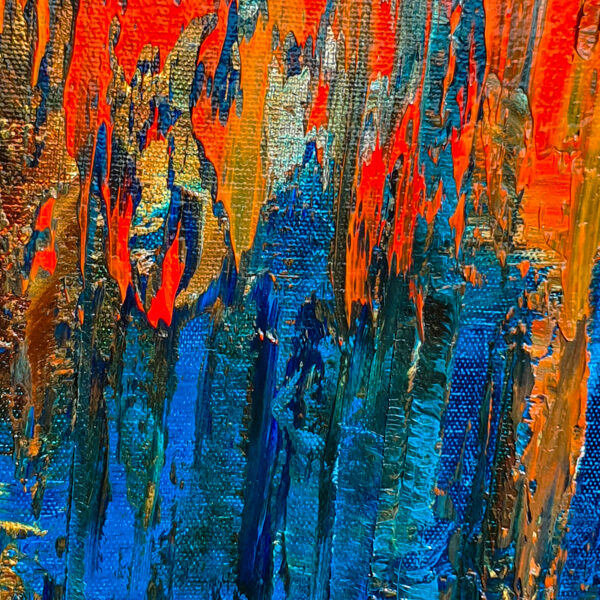
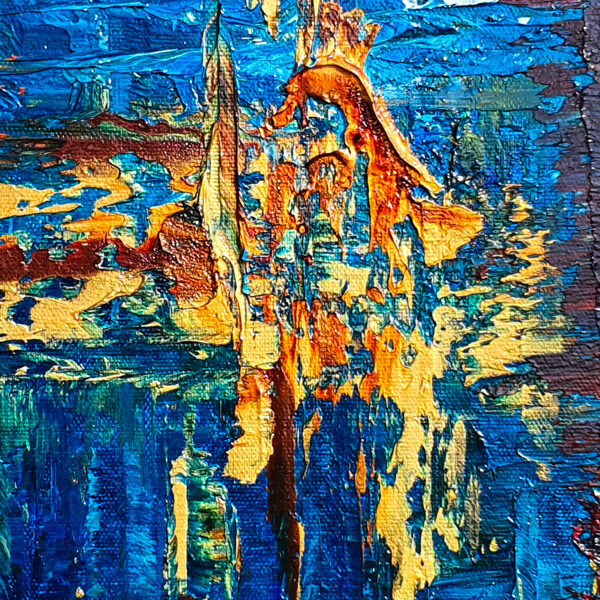
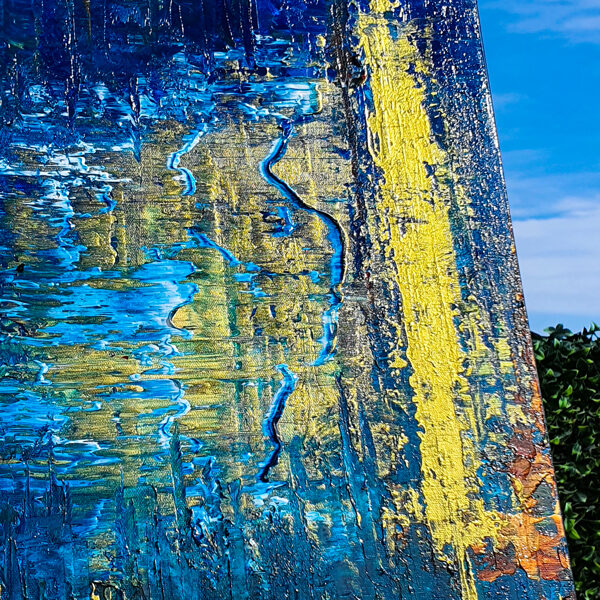
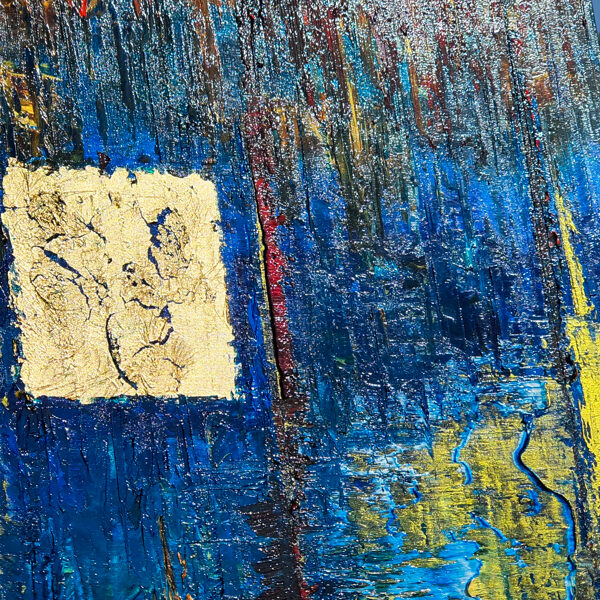
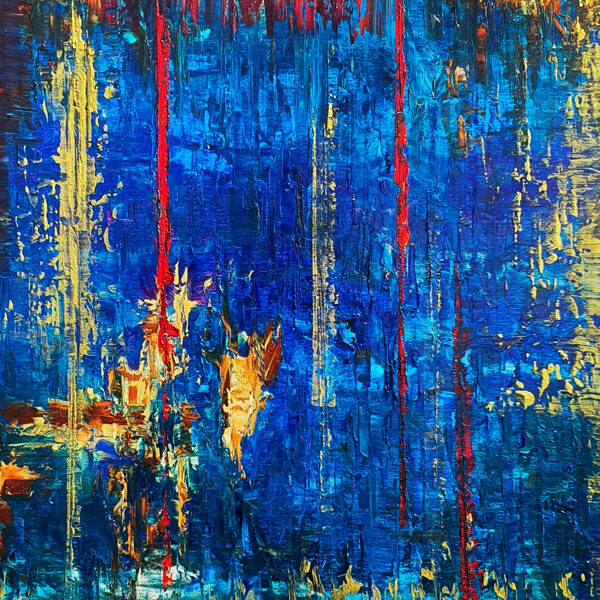
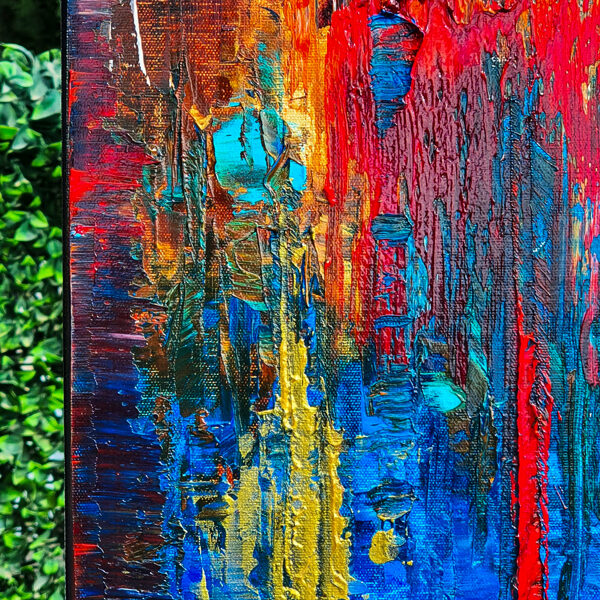
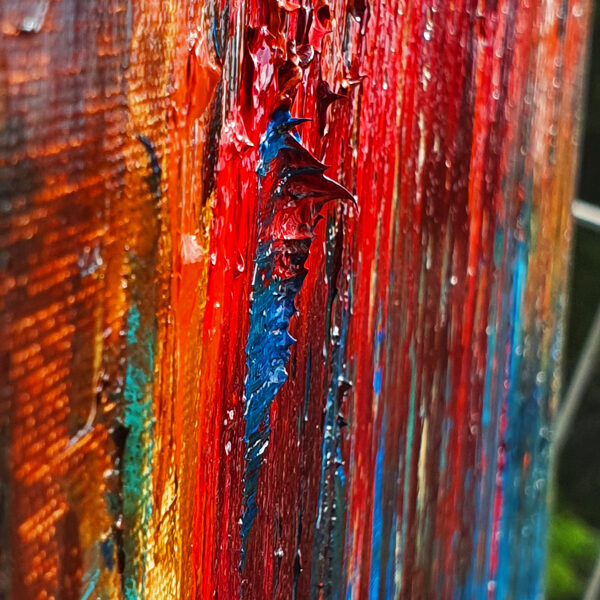
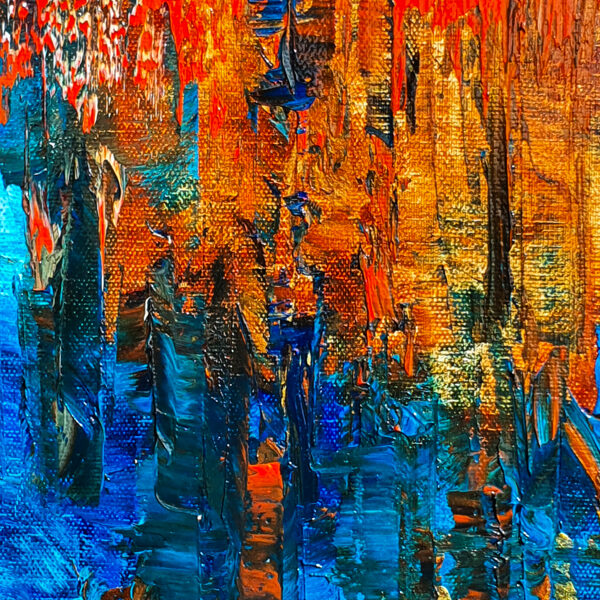
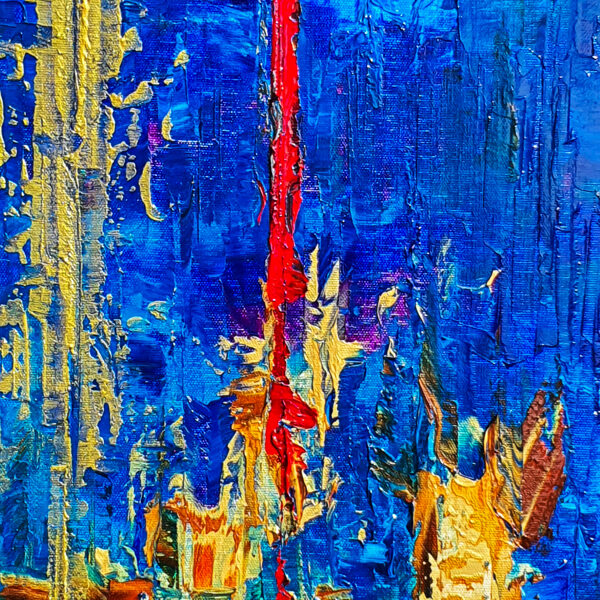
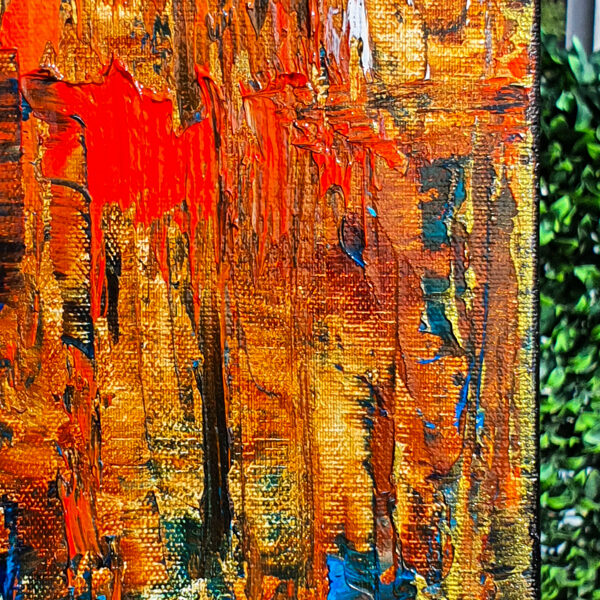
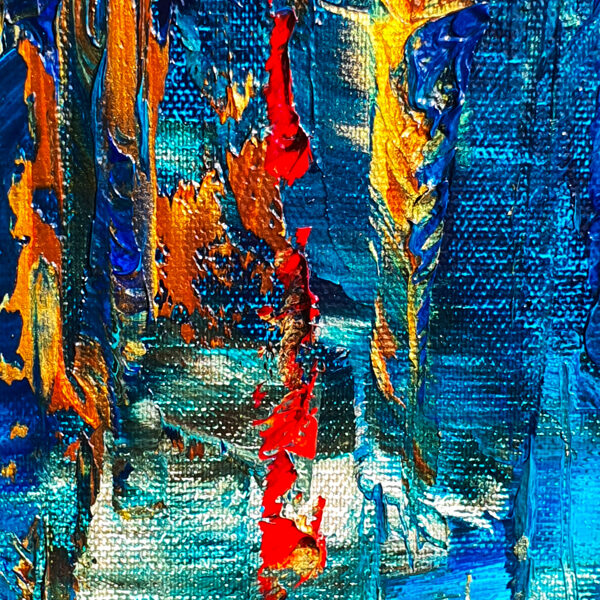
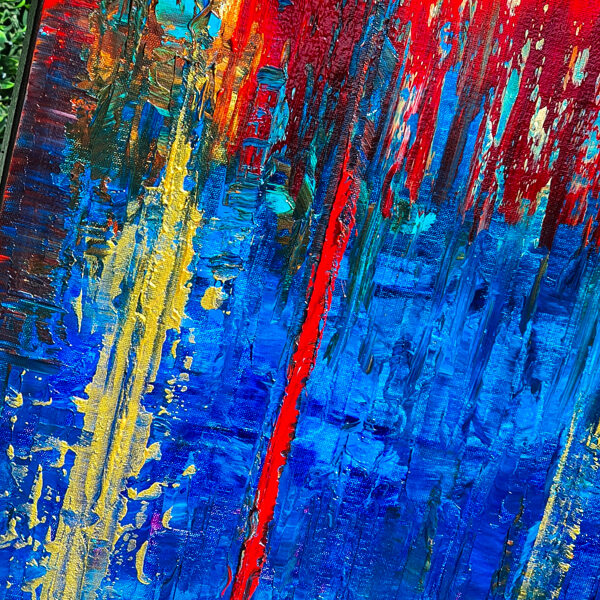
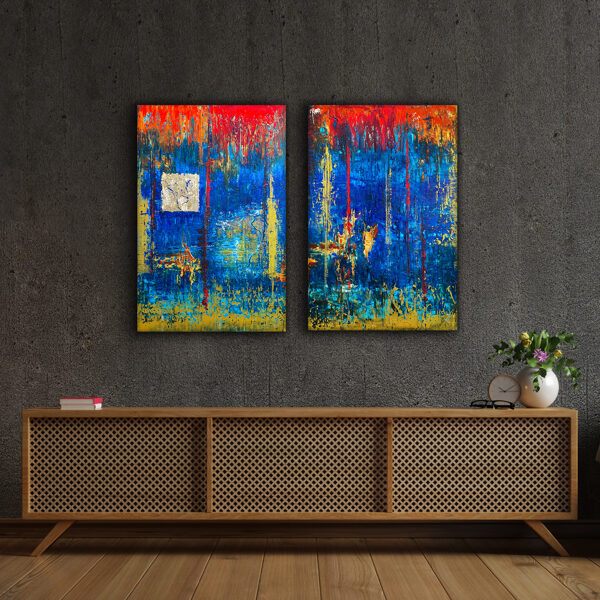
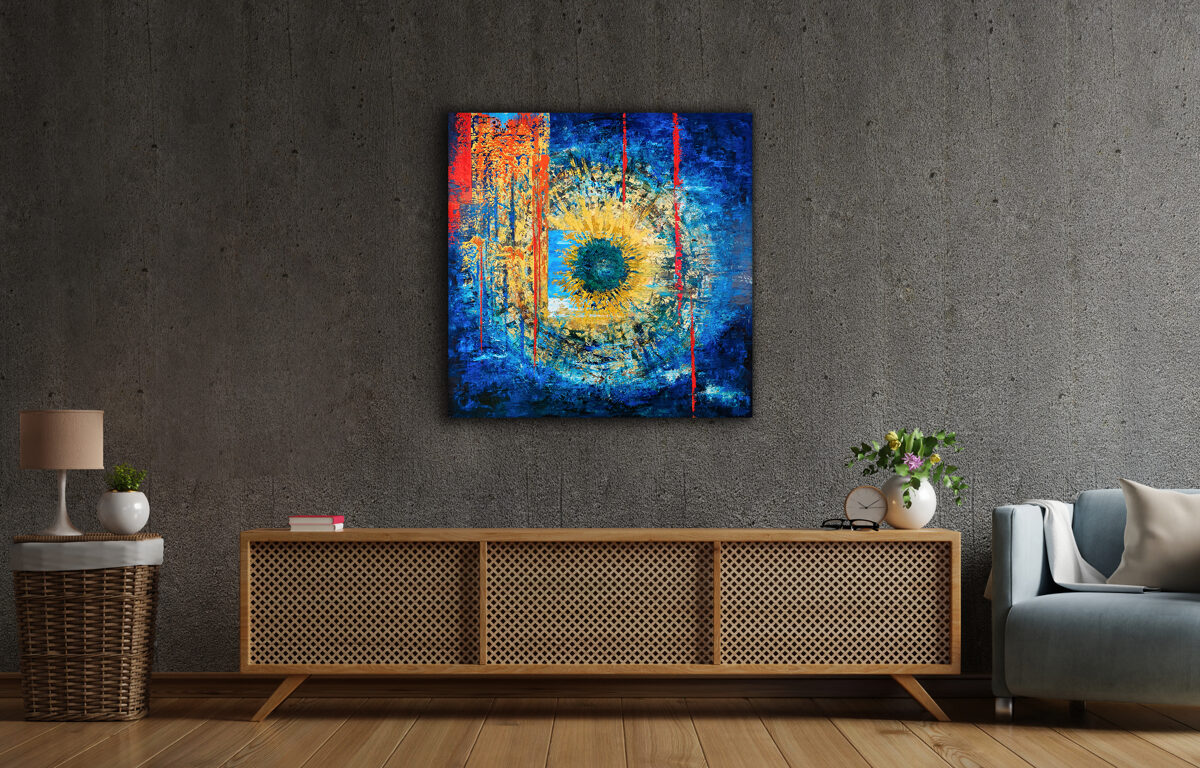
The painting presents the unique interplay of light and spatial composition of the church interior, unveiling in the abstraction the smooth, sea-influenced marble floor, the walls, adorned with golden glass mosaics and marble inlays, and the intricately carved marble columns. However, all of this is surpassed by the dazzling dome with a diameter of over 30 meters, which manifests in the artwork as an iris with special refraction, symbolizing God's eye over the world, with the infinite, blue sky behind it. Around the eye, 40 "window openings" are arranged like sparkling diamonds on the regal crown of the ruler of the second-largest empire after the Divine realm.
Photos of the artwork:
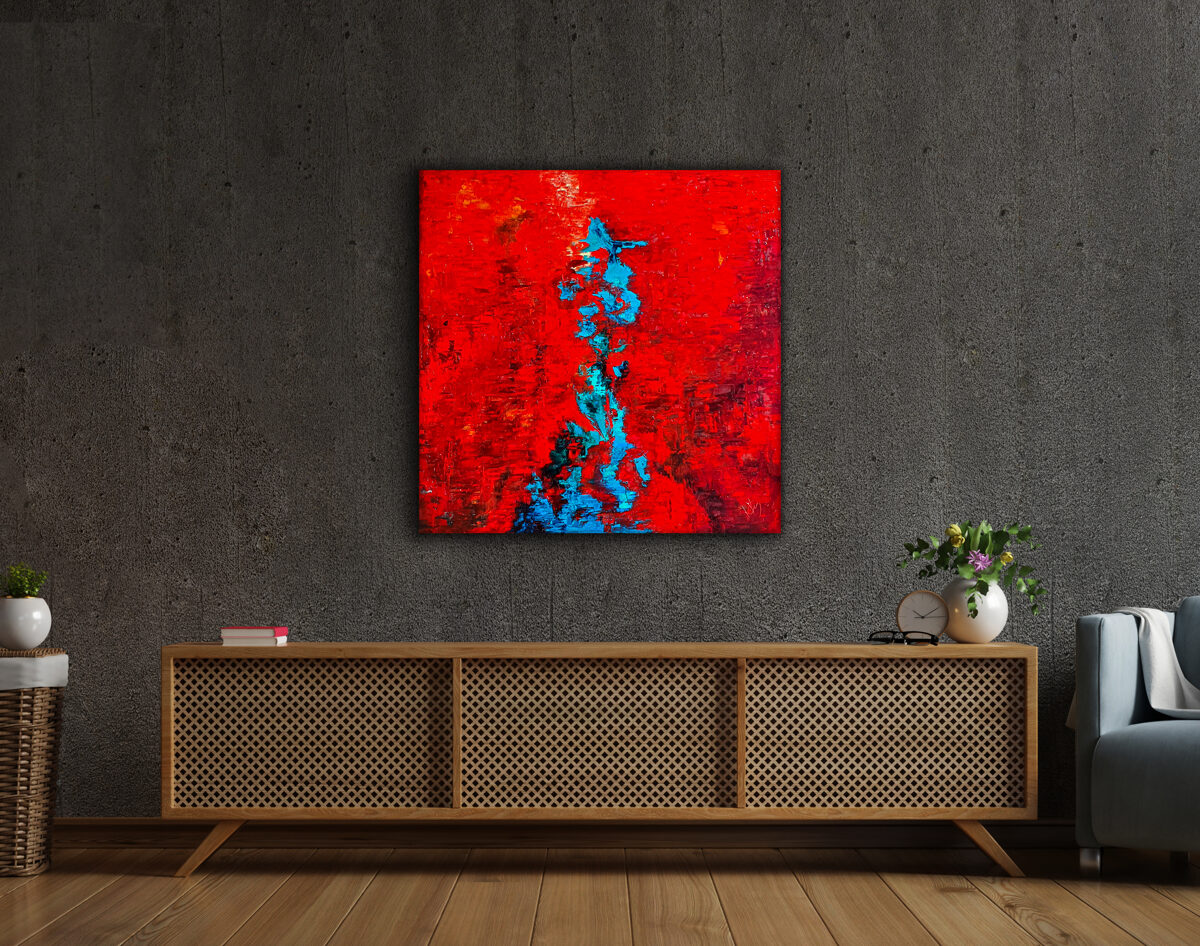
The painting, glowing in red, scarlet, and countless shades of burgundy blood hues, narrates the mourning of the Sun god, Apollo. The gentle and beloved Apollo had a beautiful young man, the sky-blue eyed Hyacinth, as his lover. However, at one time, Apollo accidentally wounded him with his discus, and the young man succumbed to the injury. Apollo buried Hyacinth with his own hands, soaking the earth with his tears. The next day, when he returned to the grave, a wondrous flower with azure petals unfolded, each petal holding a drop of the Sun god's tear. This flower, the Gladiolus Byzantinus, became the eternal symbol of undying love.
Photos of the artwork:
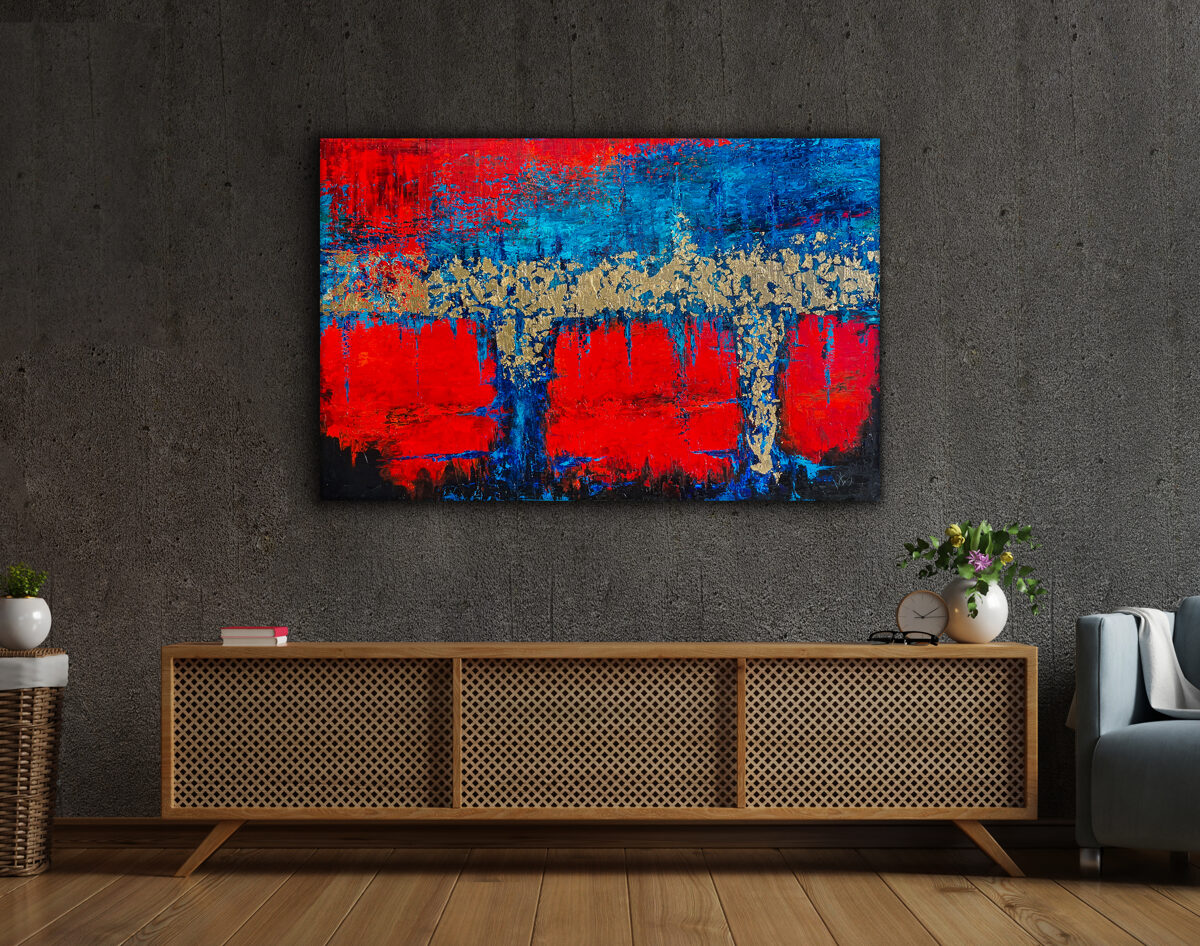
On May 24, a full moon illuminated the sea, coinciding with a lunar eclipse. The next day, the Byzantines held a procession carrying the image of the Virgin Mary. However, the holy icon fell from its stand and then such a powerful storm ensued, that it shrouded Constantinople in an impenetrable fog. Shortly after, a reddish light appeared around the dome of the Hagia Sophia. When the mist cleared, the Turkish fleet was staring back at the city's defenders, advancing from the Golden Horn all the way to the harbor.
Photos of the artwork:
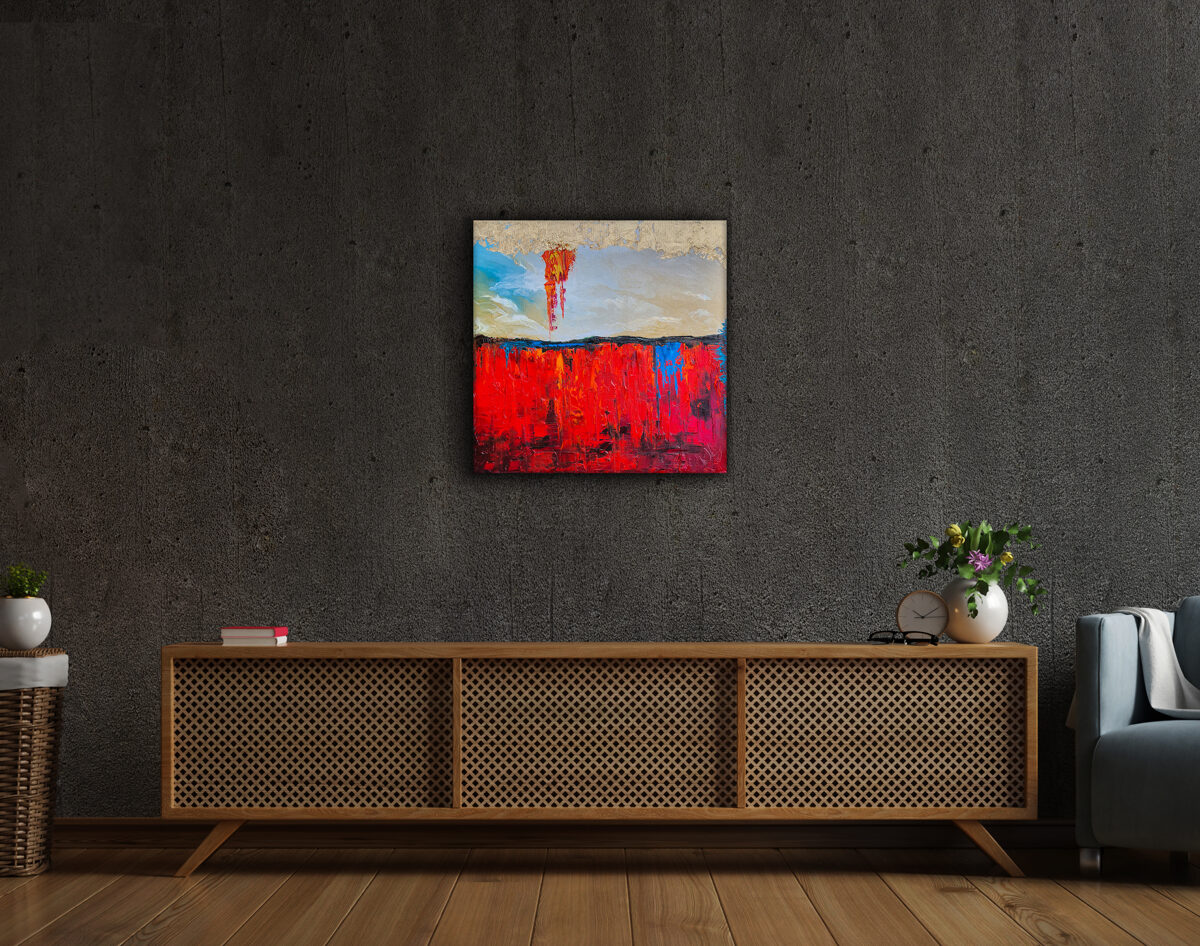
The lower part of the painting portrays a lush orgy of Roman red and imperial purple colors. The layering of the thick paint columns symbolize the weight of the Empire's centuries. In the legions, the crimson, full-body cloak served the purpose of concealing if a soldier was bleeding. The geometrically precise horizon of the artwork reveals the continuous ridges of Italy's sharp landscapes and plains, emphasising the final battle by the river. In the upper left field of the composition, deliberately offsetting its balance, the opalescent, unrealistically pale, almost infinitely transparent sky serves as the focal point, its lack of color essentially conveying the futility and senselessness of the carnage below. At the pinnacle of the composition, through the swirling golden mist of the divine soul, a vision transcends, clearing and coloring the sky: Constantine embraces Christianity.
Photos of the artwork:
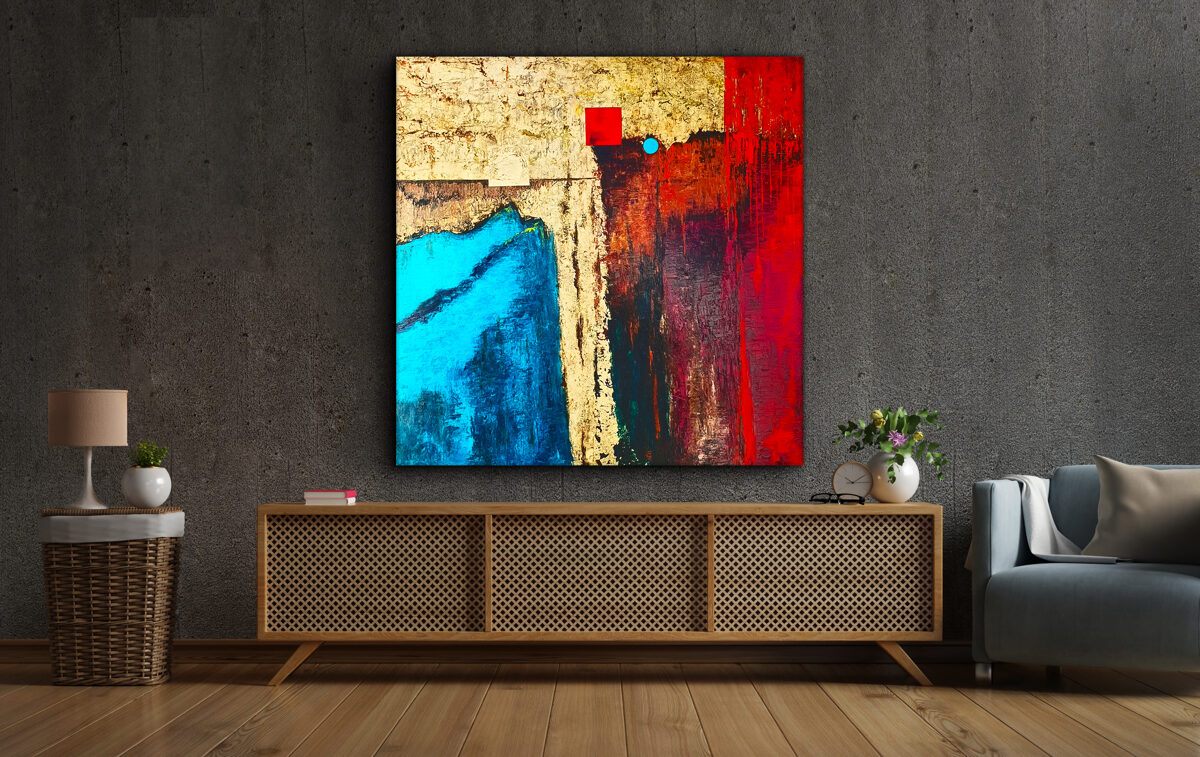
The upper third of this monumental artwork is dominated by the unalterable declaration of divine will, presented in the form of layered gold plates pierced with the colors of the universe, and in its center, a solidly contoured red square is wedged, a symbol often representing the altar or the sacrament in Tamás Náray's art. Into the field of profound divine revelation, capable of changing and rearranging everything, a separating - pagan or satanic - force penetrates like a spear, attempting to sever the golden column, descending from the sky, at its narrowing point.
Photos of the artwork:
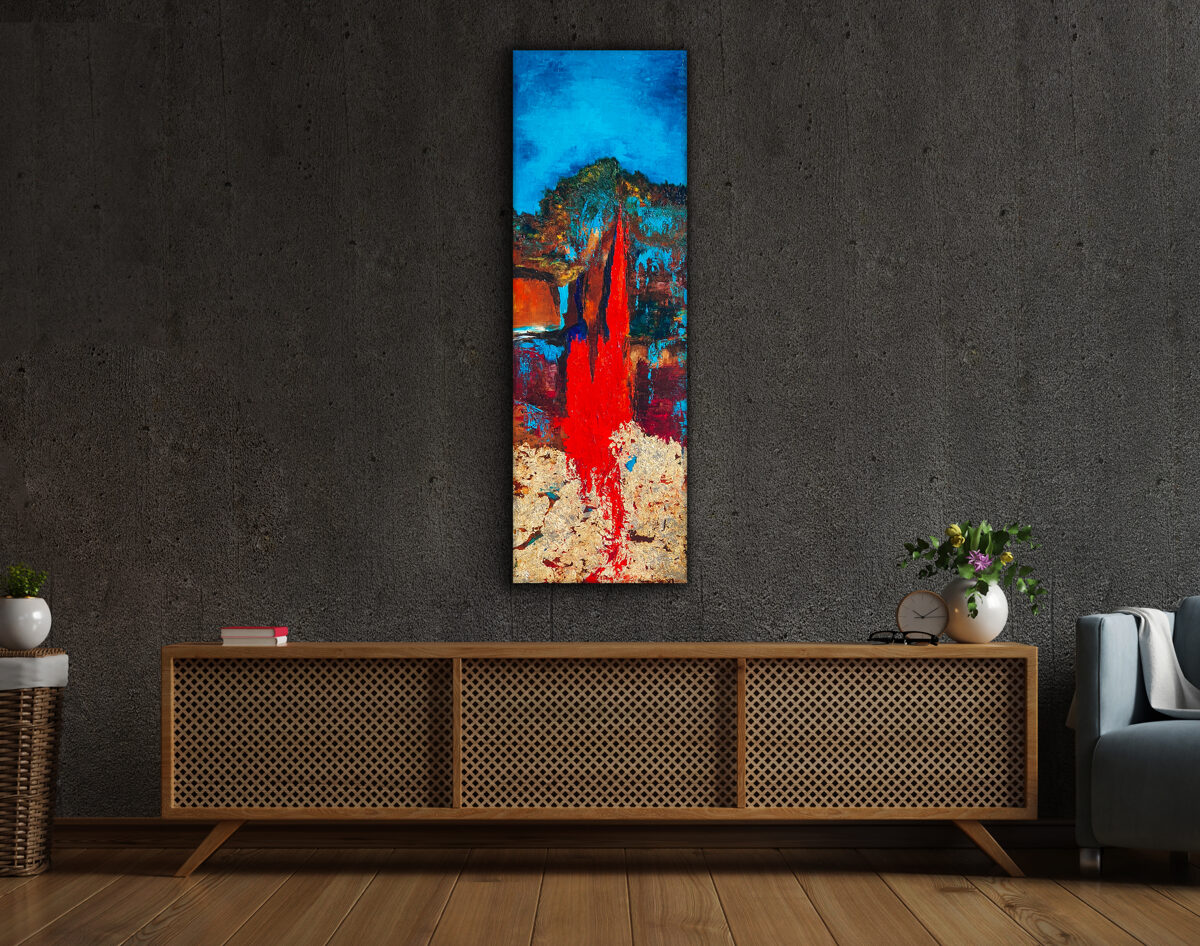
The artwork's exciting and unique form also expresses the desire to ascend, and its masterfully crafted composition is also vertically oriented, elongated. At the bottom of the image, swirling layers of gold draw attention to the value of ancient knowledge, while the emerging reddish forms juxtapose the symbolism of knowledge and fire: both capable of destruction, yet indispensable for earthly life. In the background of the image field, shapes gleaming in various shades of brown and ochre evoke a paradise, with the infinite, cosmic blue radiating as its crown.
Photos of the artwork:
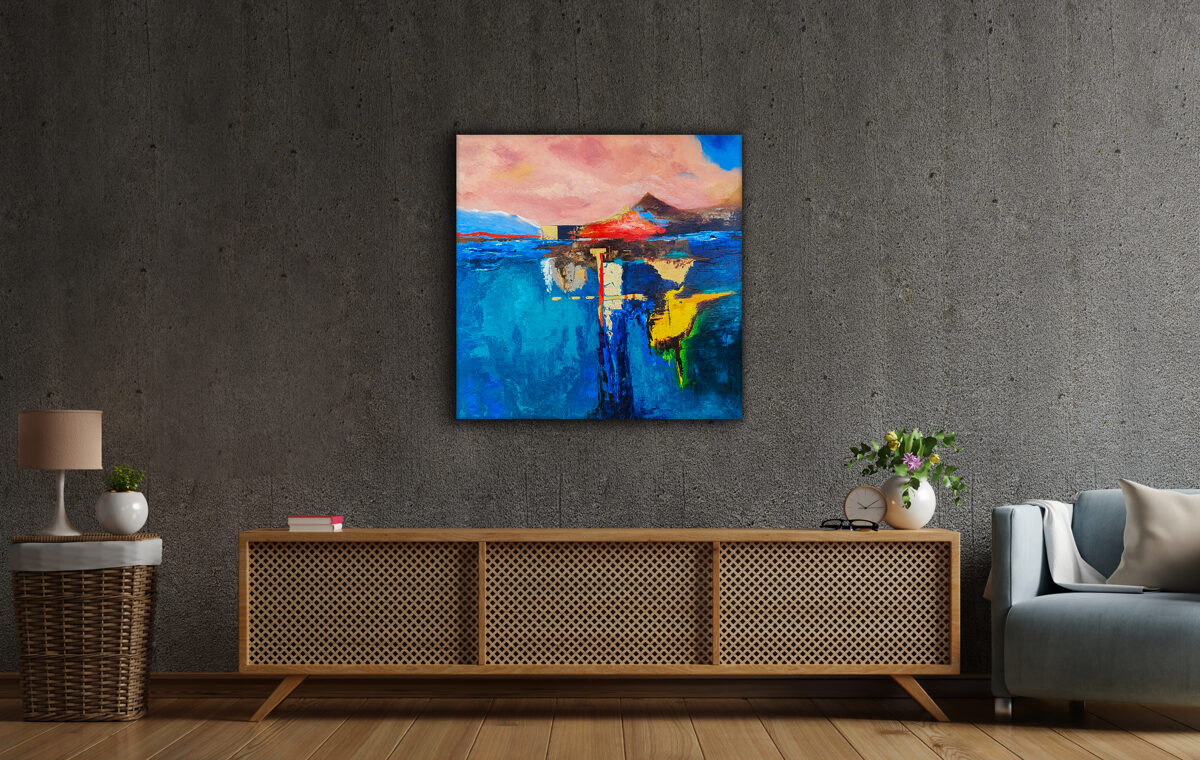
The painting titled "Nova Roma" could be described in one word as HOPE. It symbolizes the beginning of a new life on a new continent, after seas of suffering, battles, conflicts, and bloody civil wars. The sky, painted in shades of pink, radiates a peculiar light with the inherent blue peeking through, illuminating the landscape below. The painting is categorized as an abstract landscape. The hills, depicted in various tones: brown for the earth's treasures, blue for the purity of the soul, scarlet for the primacy of love, gold for eternal creative abundance, the black and gold variations of geometrically painted hills tell the story of Roman law and Byzantine laws. The mosaic-like patterns shimmering on the waters, painted with turquoise and lapis lazuli pigments, evoke not only the lush splendor of the Aegean islands but also the majestic gold-red masts of the fearsome Byzantine fleet. The composition takes on a cross shape, divided according to the Byzantine, equal-armed cross distribution.
Photos of the artwork:
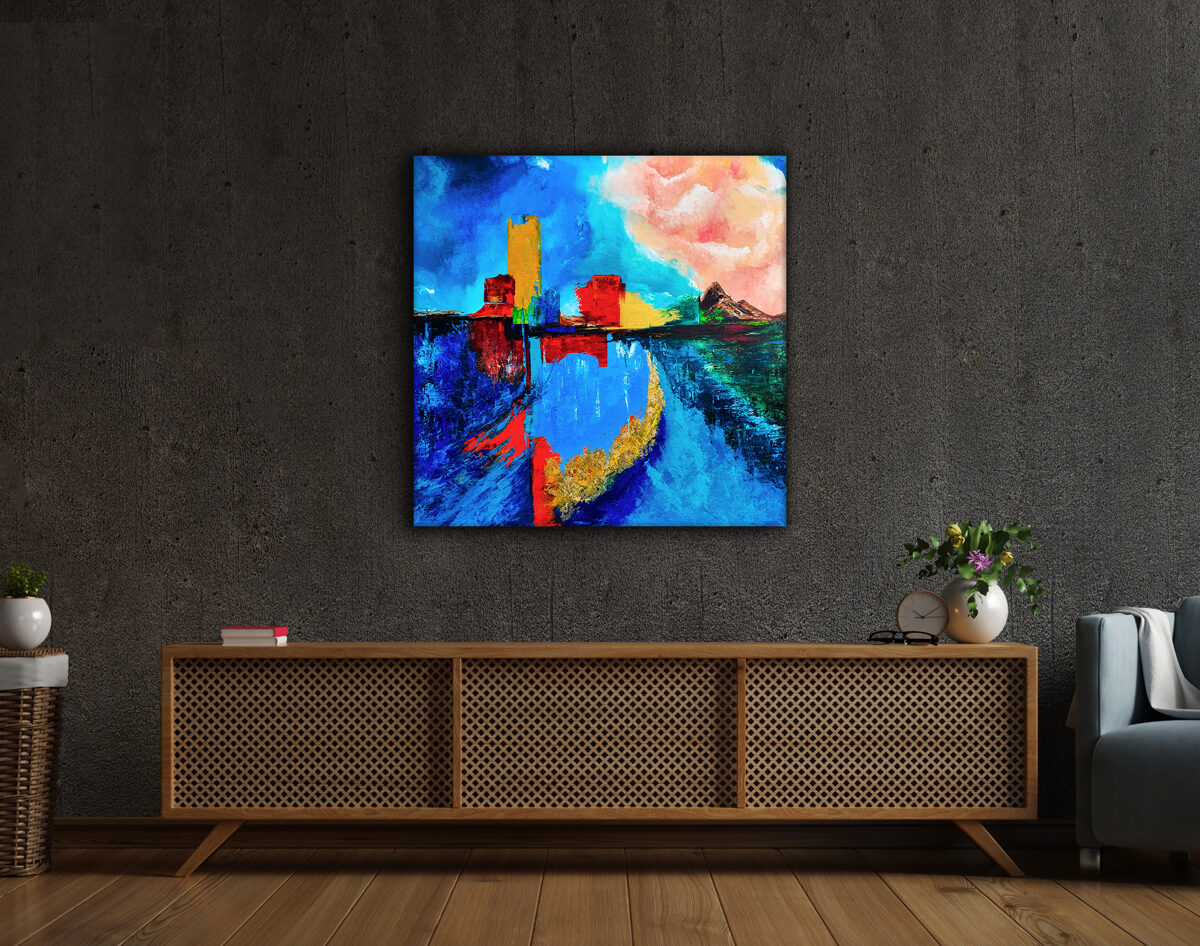
The painting, belonging to the genre of abstract landscape, dramatically depicts the rise and fall of the city. The horizontally and vertically segmented lower left part of the canvas represents the Mediterranean Sea, while the right side portrays the Black Sea, connected by the translucent waters of the Bosporus Strait. In mythology, the Bosporus is a symbol of daring journeys in mythology. The sweeping, richly gilded gesture spanning the central mass evokes the shape of the Golden Horn. On the horizon, we witness the changing colors of the seven hills, with massive complexes in the foreground, embraced by walls protecting the city's landward sides. Above the romantic, pink sky, an ominously darkening air current takes the field, hinting at the impending mortality of the city and, along with it, the futility of all efforts for material existence.
Photos of the artwork:
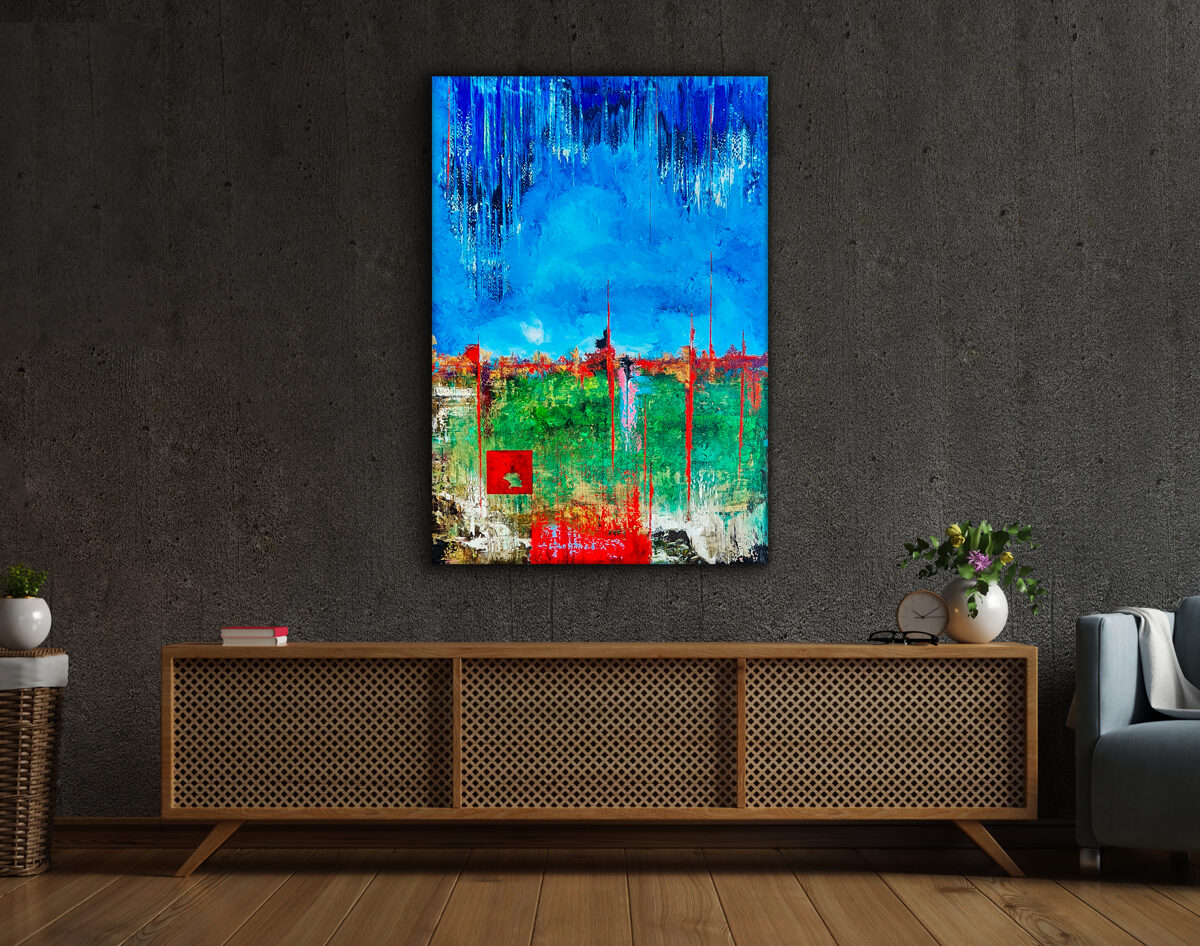
The artwork captures the moment when, instead of proclaiming the gospel, the discord among ecclesiastical dignitaries foreshadows the inevitable burning of the world. On the red square, - that is, on the altar's unified surface - "slipped" from the symmetric arrangement, a massive wound, a deep hole indicates the lack of consensus on monotheism. The upward surging burning red paint strokes and the crimson sweeps shooting from them, which also turn the horizon into red, dominate the earthly, Eden-like landscape, its green hills, mountains, and rocky waters all symbolize divine gifts for the happiness of life.
Photos of the artwork:
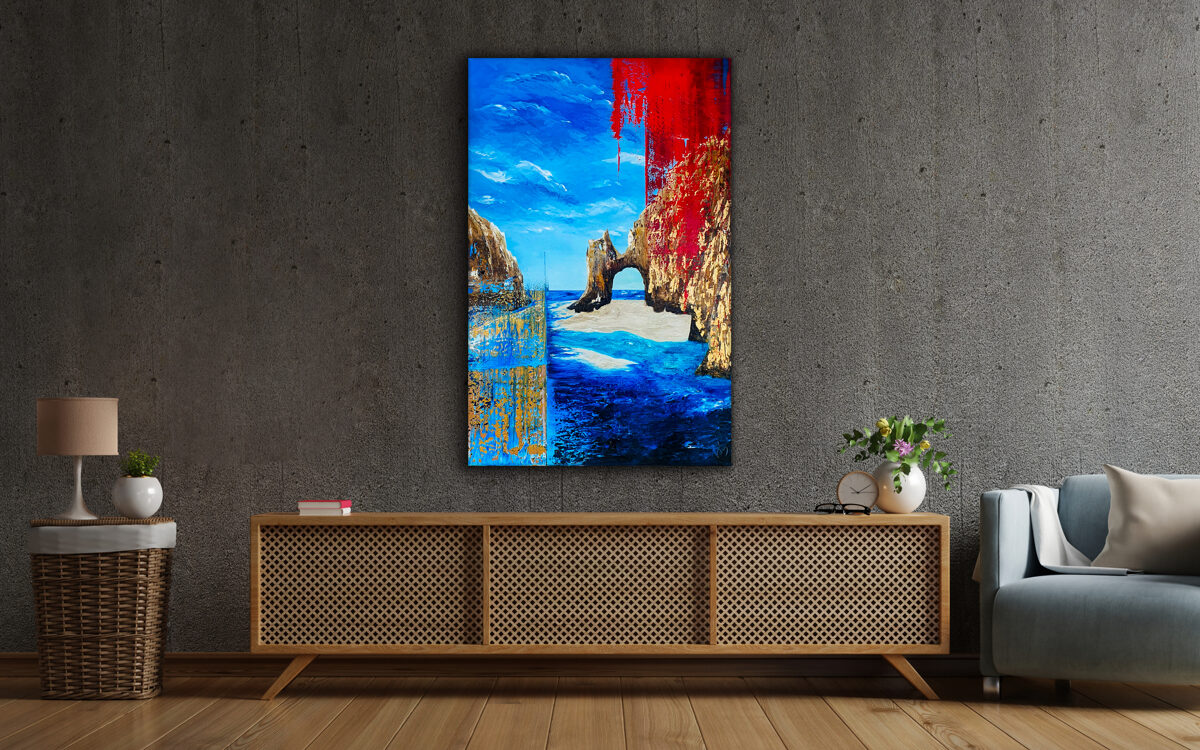
The Bosporus is a symbol of daring journeys. Not without reason, as it connects the Sea of Marmara to the Black Sea, serving as the boundary between Europe and Asia. In the Anatolian section of the strait, a massive rock emerges from the velvety blue water. However, what separates can also connect. Because the white sandy shores of the rock, plunging deep underwater, don't just separate but intricately link the two continents... But is this rock uplifted due to an earthquake? Or simply carried there by the tide?
Photos of the artwork:
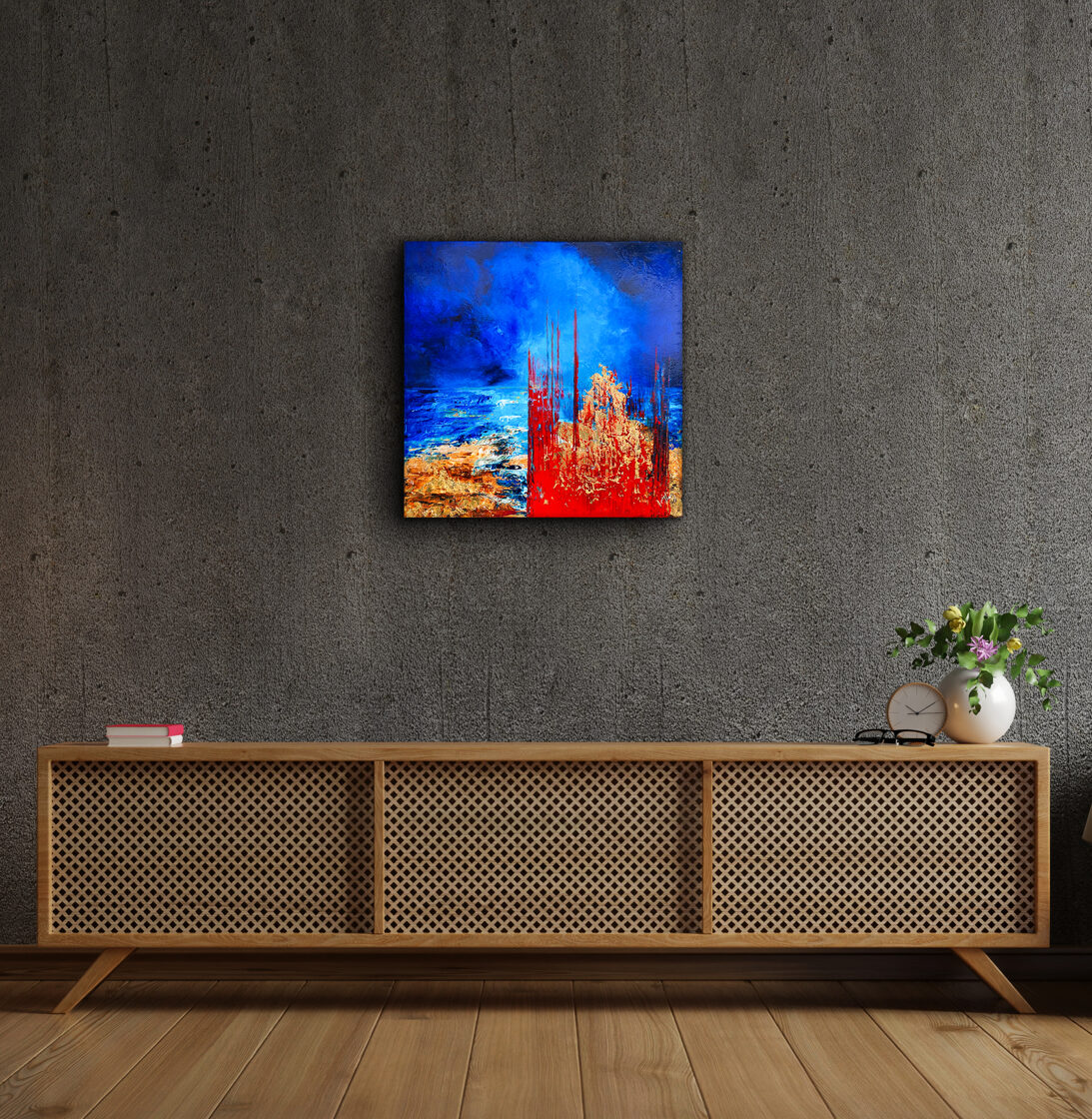
The Christian people of the first millennium regarded the mighty city as the sole metropolis of the Christian world, comparable to the great Eastern cities known only from legends, such as Cairo, Damascus, and Baghdad. Against Islamic civilization, Byzantium demonstrated that the Christian world is also capable of such achievements.
The painting depicts the moment of birth, as life emerges from the dark waters under the darkened sky and the golden rocks embracing the shore. Pain and pleasure, hope and doubt, birth and decay all appear simultaneously on the canvas: a new world order is irreversibly unfolding.
Photos of the artwork:
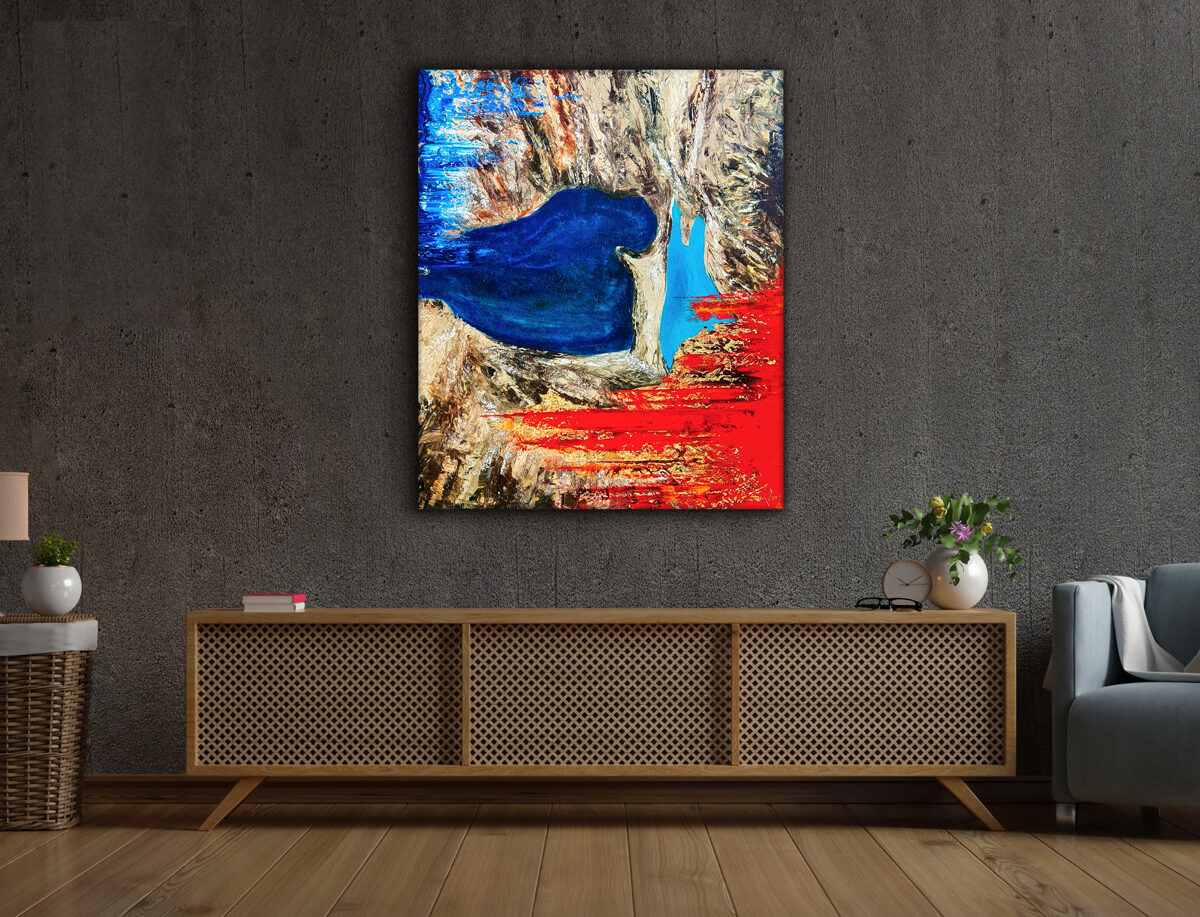
The painting combines elements of the abstract landscape genre and Tamás Náray's characteristic knife technique, creating an almost realistic portrayal of barren, tall, rocky mountains, interspersed with the deep almost black abysses and the turquoise lake surfaces. The rich, compartmentalized transitions in the upper and lower parts of the canvas narrate the discovery of life and the subsequent serious hardships.
Photos of the artwork:
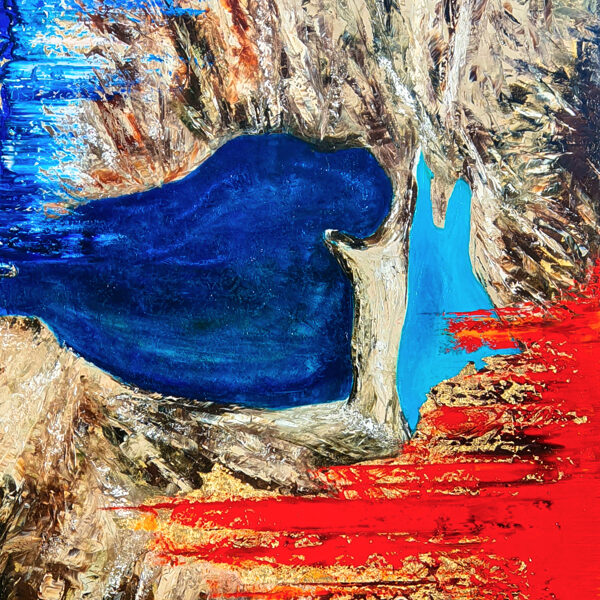
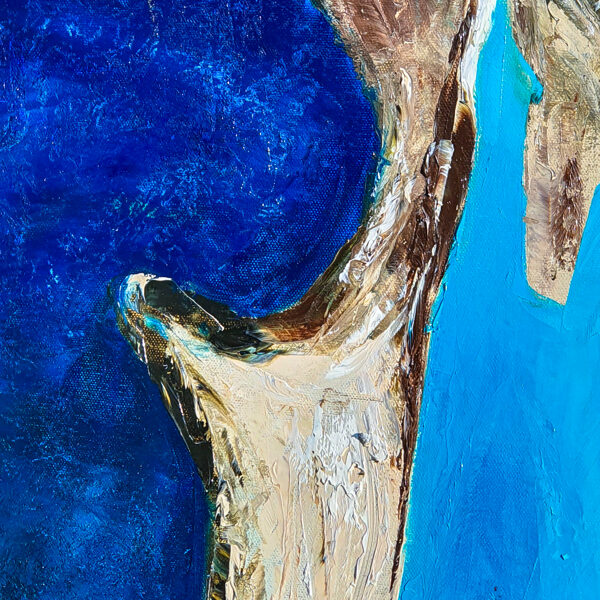
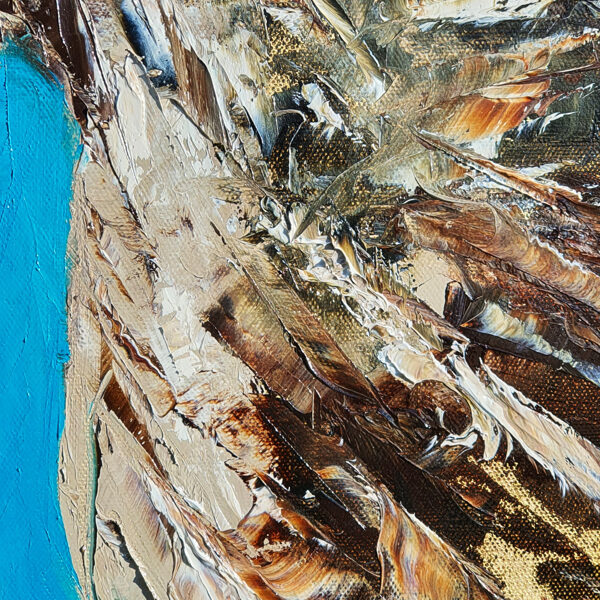
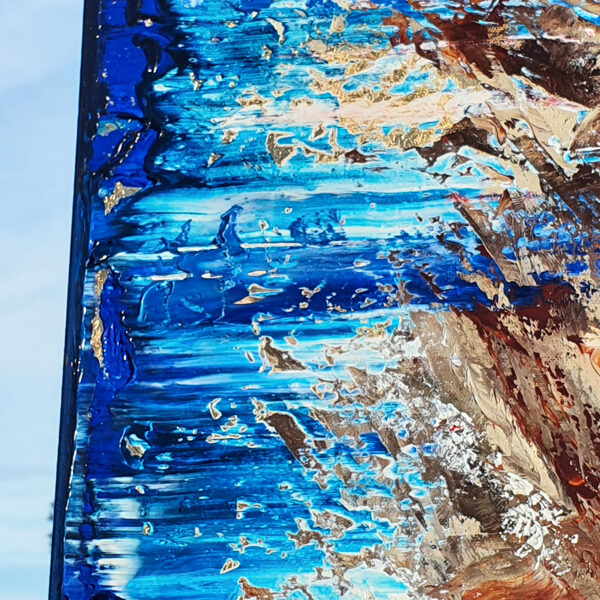
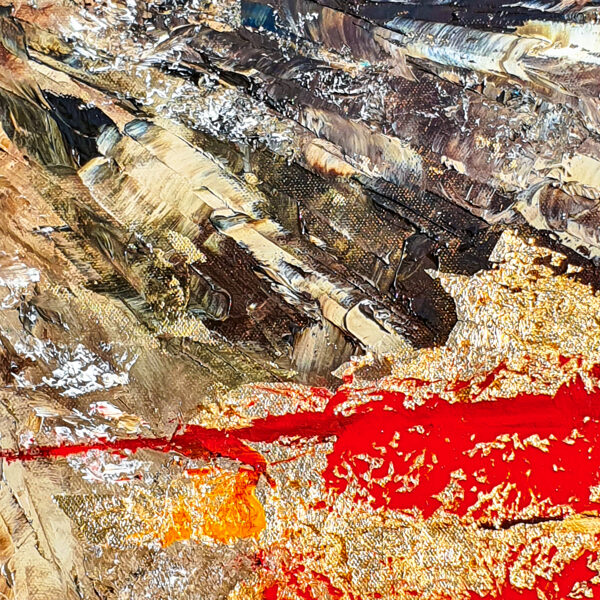

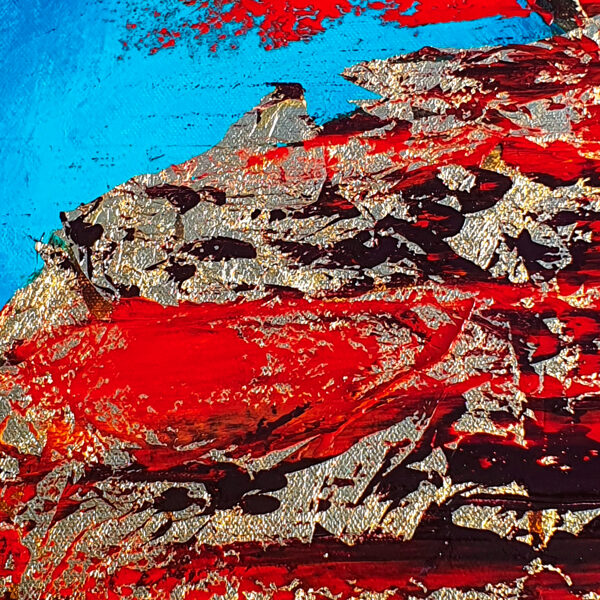
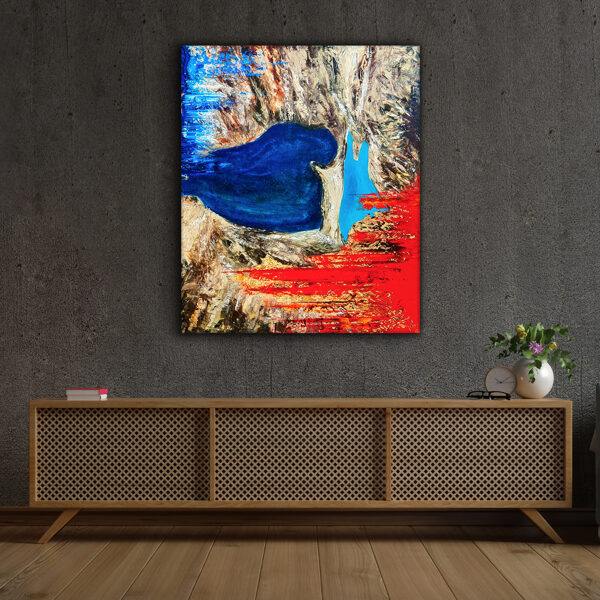
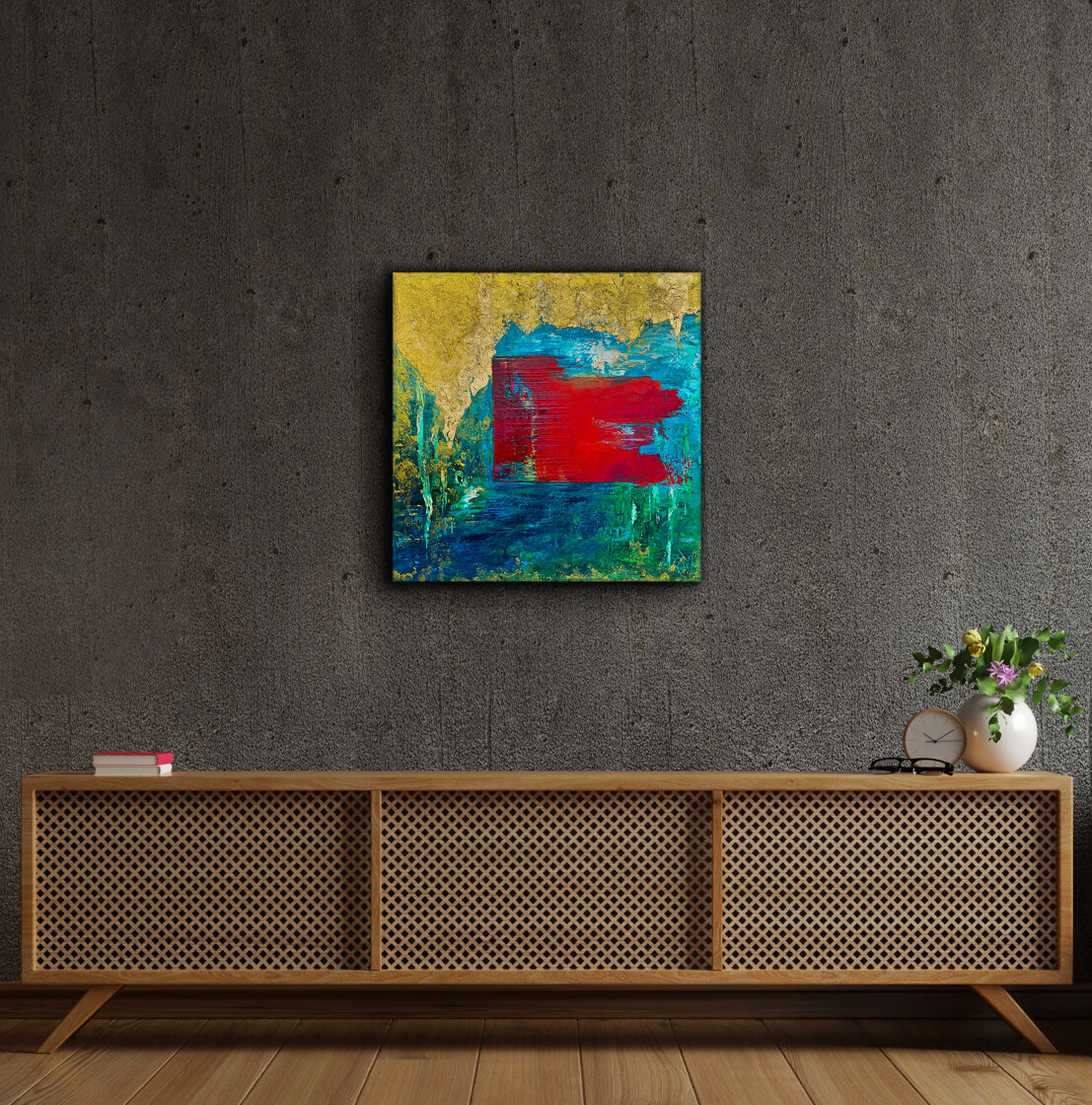
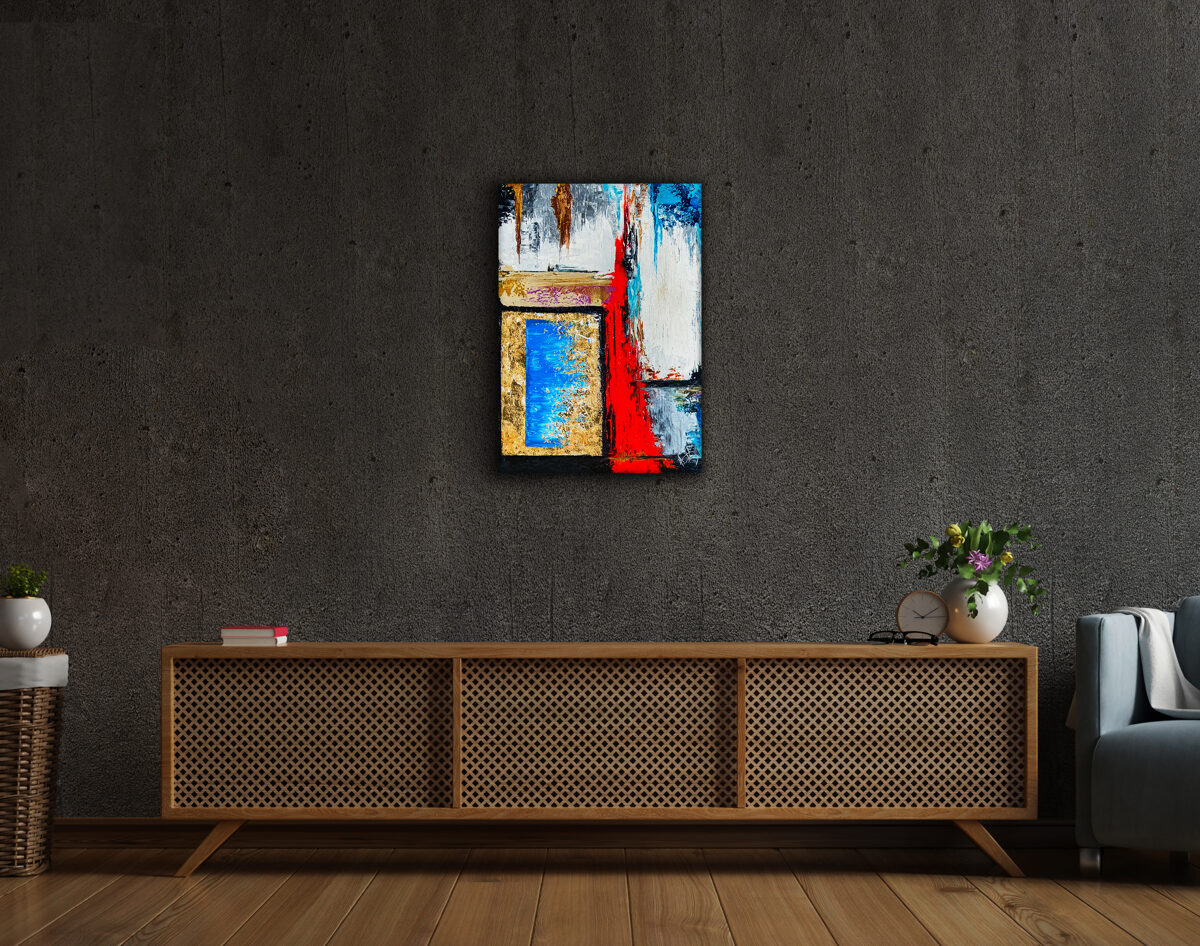
In the lower quarter of the canvas, a solid gold block emphasizes Byzantium's position in the world of that time. On the background fracture, on the horizon Rome appears in its last days. The gestures descending dynamically from above symbolize the necessary birth of something new from every demise, painted in the colors of mourning and hope. The solid, earth-colored line above the Byzantine gold block, with intermingling golden ribbons, illustrates the later weight of Justinian's rule. Yet, the spectacle is dominated by a pillar of flame gleaming in the red and burgundy hues, symbolizing how Theodora, through Emperor Justinian, controlled Byzantium. However, the glowing, sky-piercing stream, before reaching its destination, fades away: the pure and impeccable colors of eternity stand in the way of the conquest.
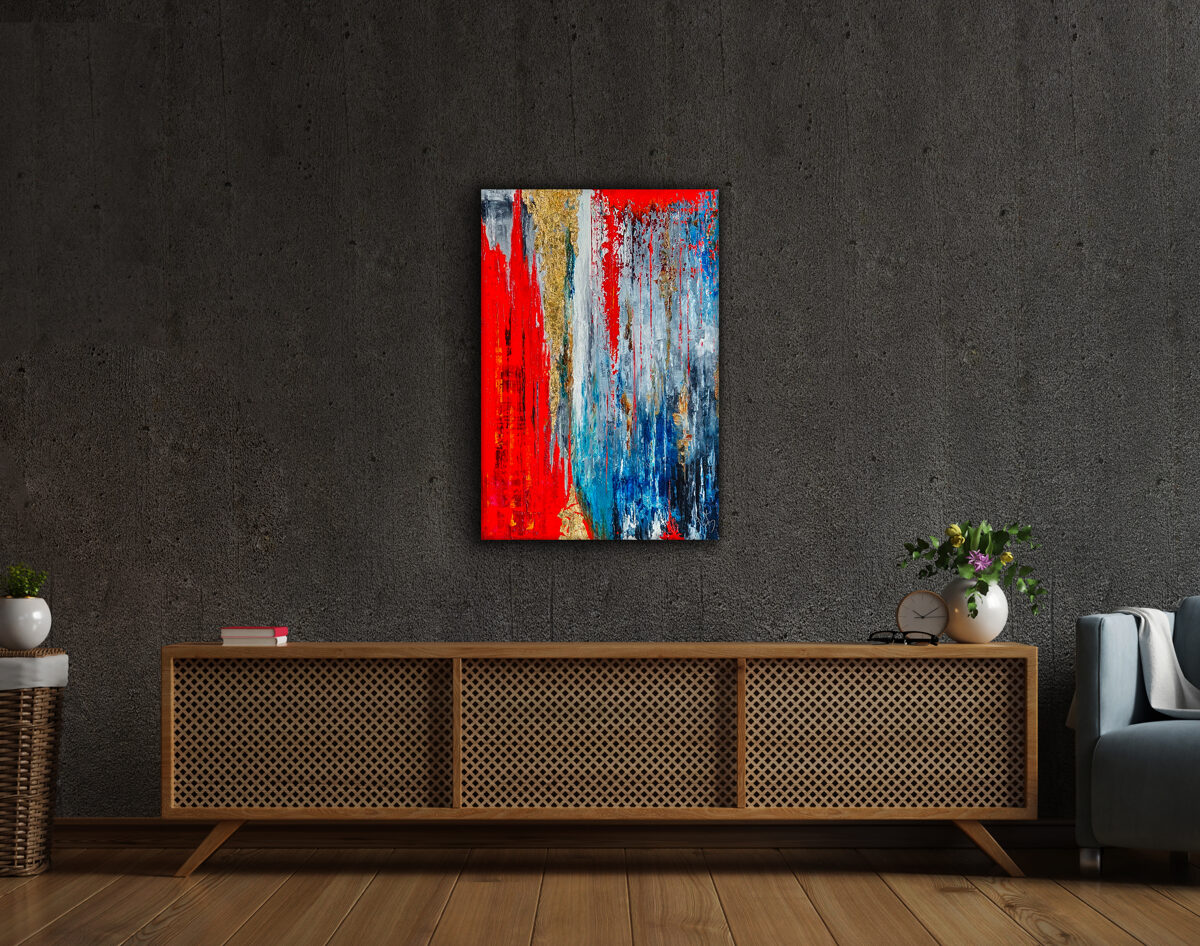
The painting addresses life’s ever-discussed contradiction, that despite every opportunity for happiness, it still remains elusive. The triple divisioned canvas, structured around a duality of symbols, captures this complexity. The opulently gilded surface running through the center, representing divine blessing, grace, grandeur, and wealth, is disrupted by shards reaching out from the reddened field, breaking its continuity. This composition delves into the intricacies of life's contradictions and the ruptures within perceived completeness.
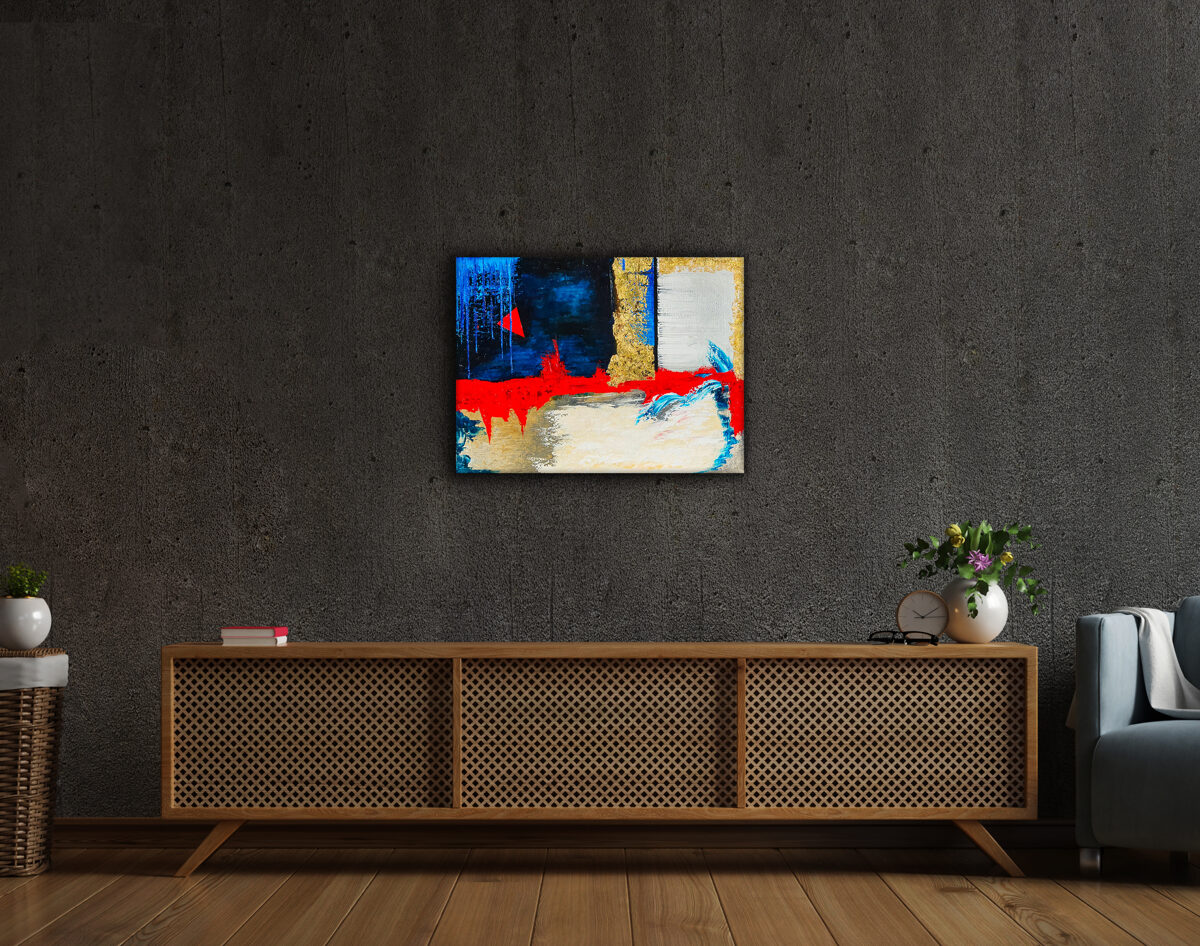
The artist captures on canvas the momentary feeling when all external circumstances seem to align for success and happiness in a person's life, however, the desired carefree life remains unattainable, specifically due to one's own persona. The order and harmony is disrupted by a darkening flood, in which a peculiar symbol, the red triangle appears. Power, deceit, will. Yet, the world's order remains unchanged, even when certain forces very much desire otherwise. Their path is blocked by the brilliance and purity of a massive golden block. Despite the composition's apparent solemnity, it reveals, through the surging water and the pristine untouched landscape, that good always prevails over the scheming of evil. Of course, sometimes one must wait for it...
Photos of the artwork:
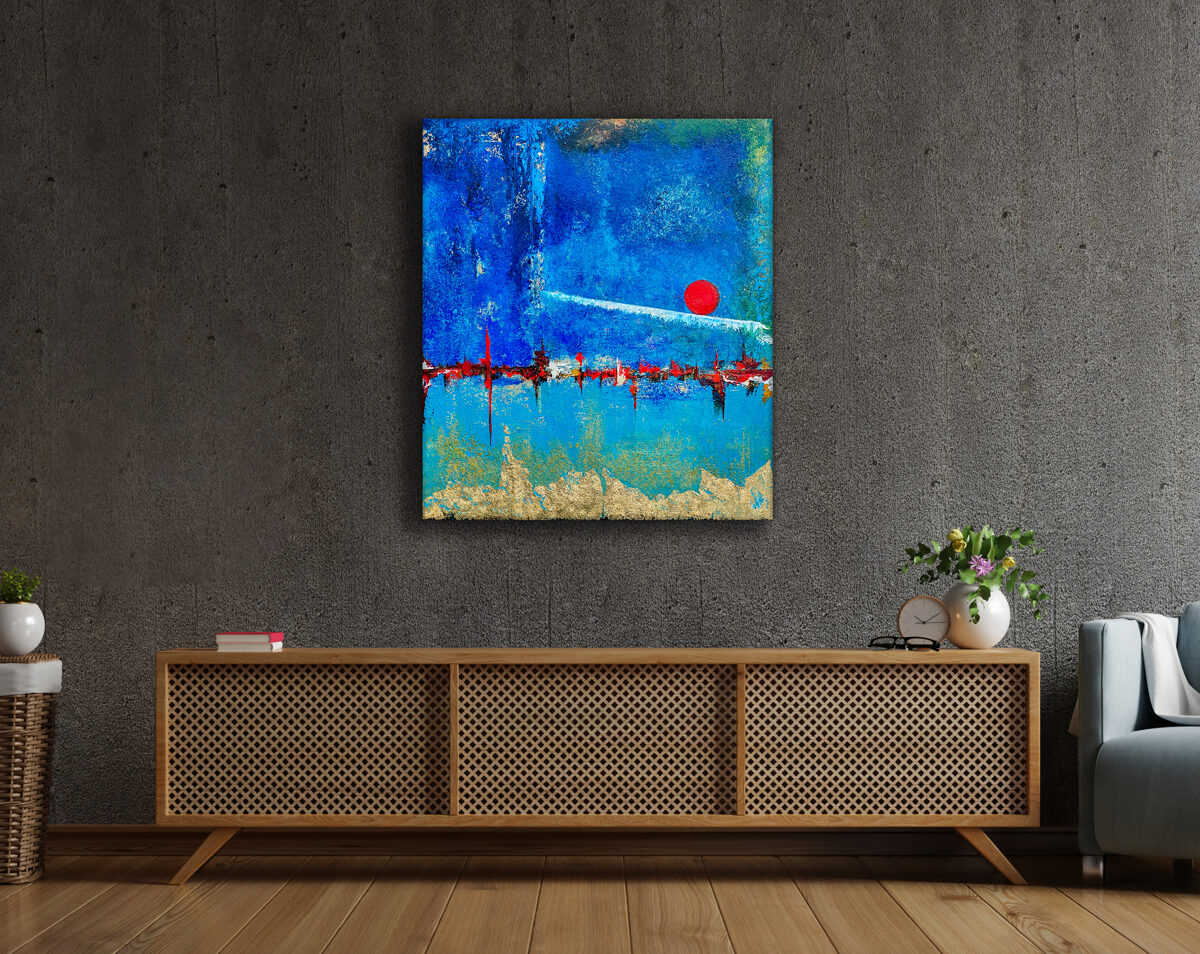
On the horizon of the abstract composition, the familiar silhouette of the sea emerges: Constantinople at night, illuminated by the stars. Beneath the dramatic sky, something is evidently unfolding. The turquoise and lagoon-green depths of the sea sparkle in mysterious light as, first, a red disc appears in the sky, followed by the unfolding of an opalescent cloud formation tilting beneath it. Destiny has arrived.
Photos of the artwork:
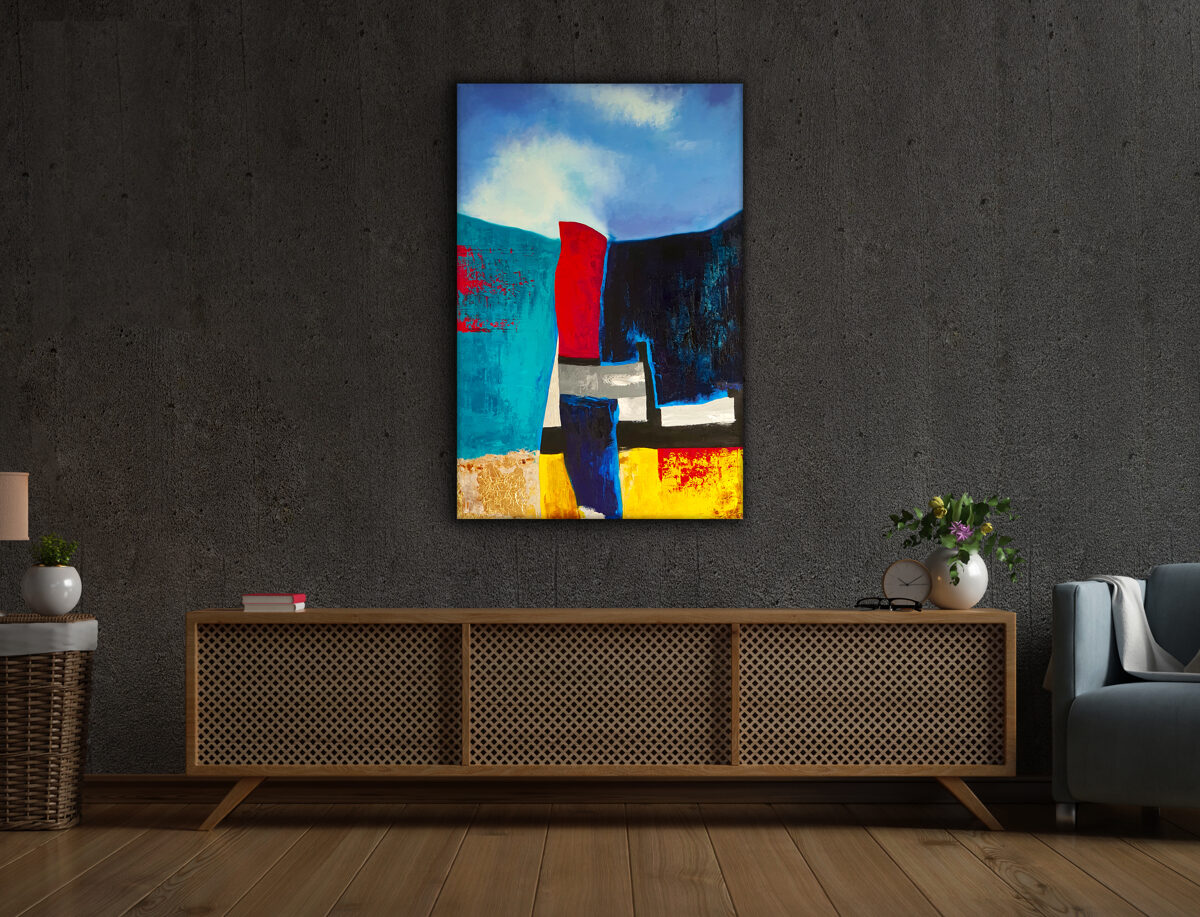
At the center of the painting stands a red column, shaped like a soaring axe, squeezed between the monolithic blocks of the two empires, almost like a sigh. We again perceive strong gestures in its symbolism: the turquoise surface connects the viewer to the artist's beloved theme, the creation, while the opposing black, dense formation reveals the unrestrained desire for conquest and subjugation, along with its consequences.
The base of the central element implies disorder, while the lower part of the composition displays the beauty and harmony of earthly life. The artwork can be interpreted as a kind of memento, as human ambition and greed make even the most ideal things unbearable. Nevertheless, towards the crystal-clear sky, despite all difficulties, a path is created in grace.
Photos of the artwork:
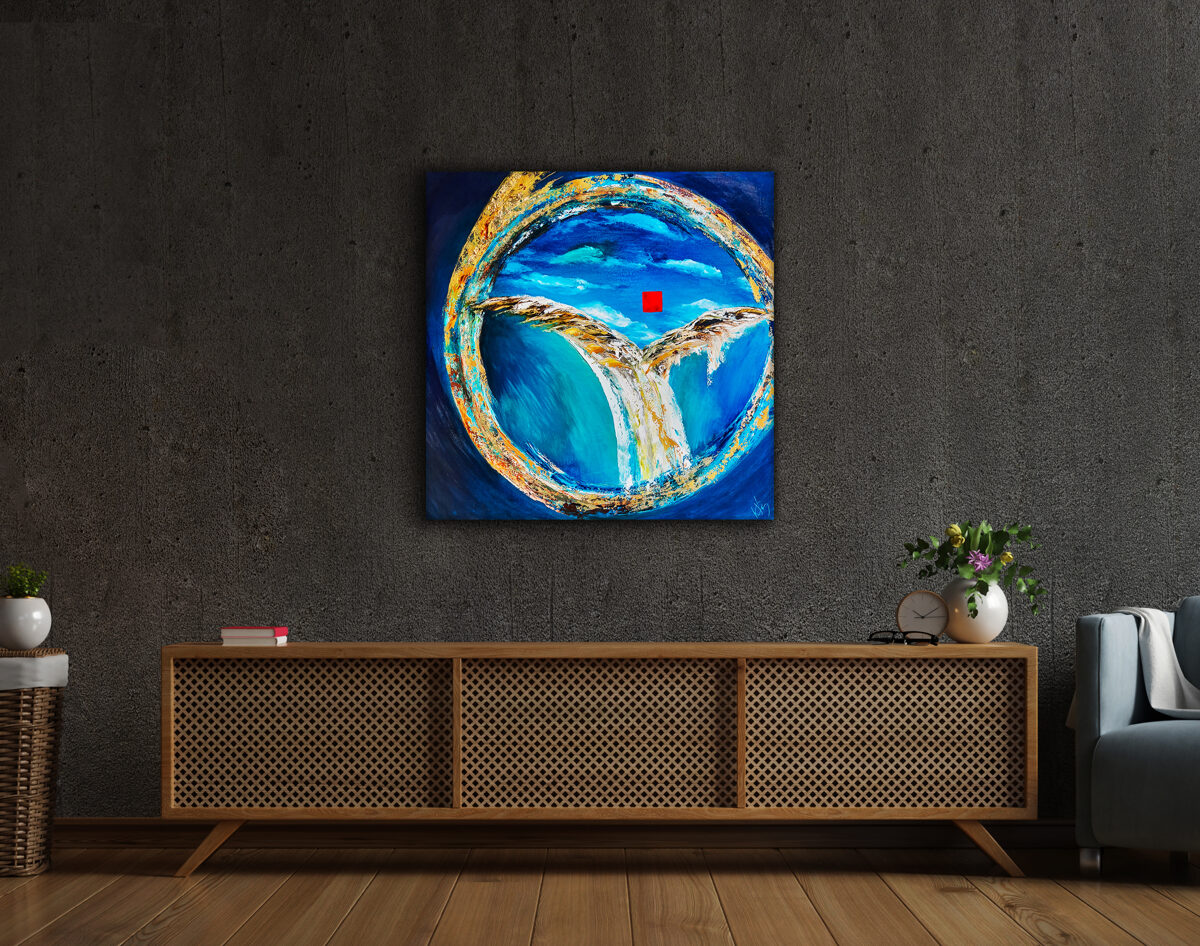
The artwork titled "Sol Invictus" was created using a brush technique, reviving the traditions of 14th-century Renaissance painting and ambient depiction. Applied in multiple layers on a chalk-based, smoothed surface, the oil glaze, cooked from natural pigments, shapes the perspectival depth through carefully nuanced shades, protruding from the canvas when viewed from a certain side angle.
In the ring of the Sun, the abstract representation of the Roman totemic animal, the extended-winged eagle, emerges, and above it, the altar dominates the dramatic horizon of the sky, occupying the center. As the ring of the Sun spins rapidly, the viewer can almost experience a sense of fall. The pagan cult gives way to Christianity.
Photos of the artwork:
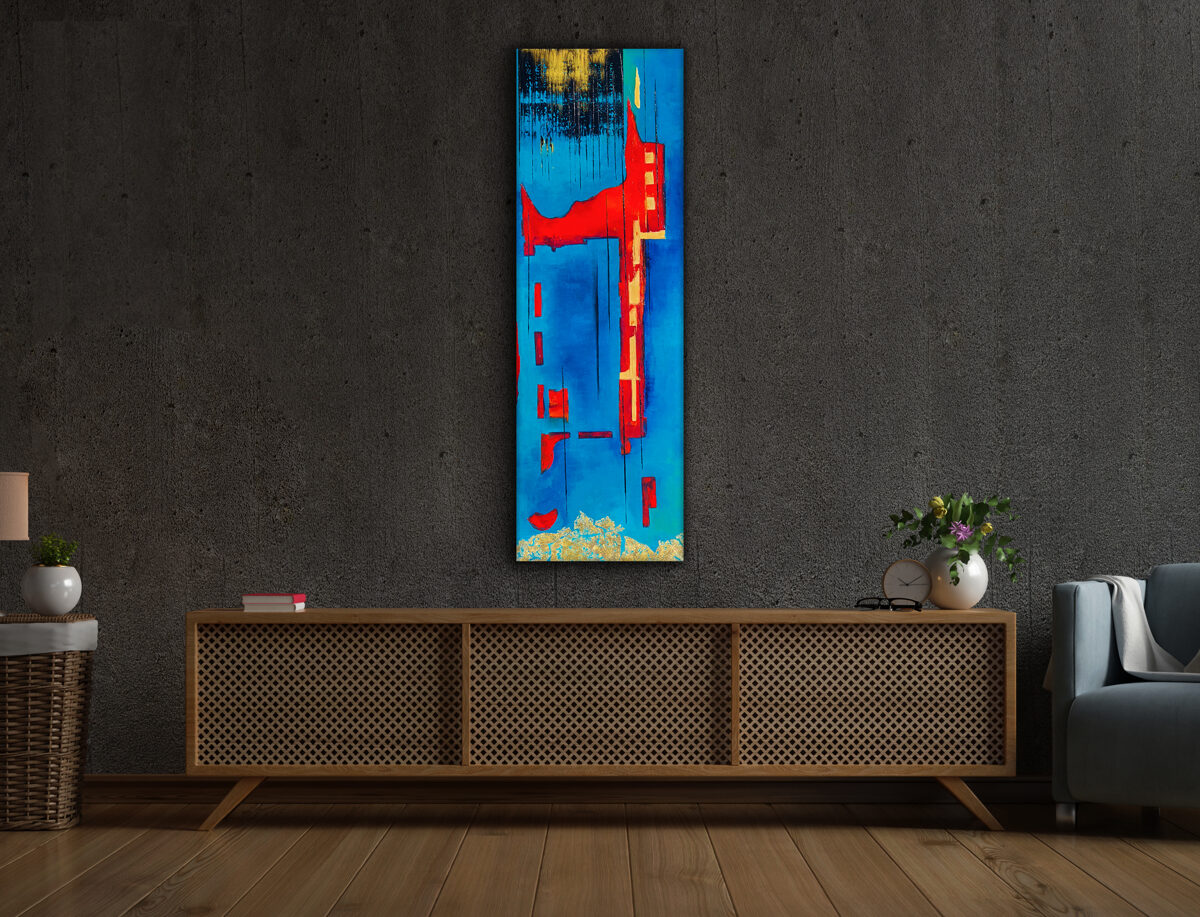
The abstraction places the outlines of the defensive lines into a crafted, spiritual space, where both the frontal and top-down views appear simultaneously. The black flow from above signifies the vulnerability of the city, that is, the desired position. Everyone envied Constantinople. (Just as people today envy everything that is ready and wealthy. The necessary work for its creation is not envied. The message of Byzantium remains relevant, remains valid even today.) The upward surging line of golden color not only indicates wealth but also reveals the blessing of creative work. The red glowing pieces cascading into infinity ultimately capture the moment when Byzantium's light fades in the destructive inferno of modern warfare after the discovery of gunpowder.
Photos of the artwork:
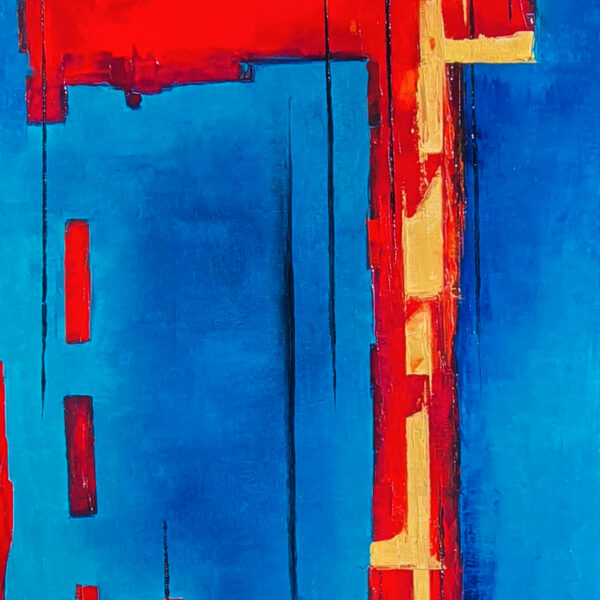
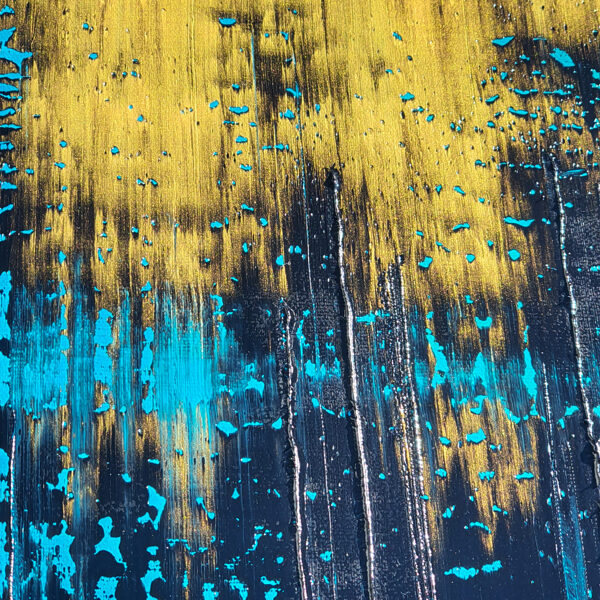
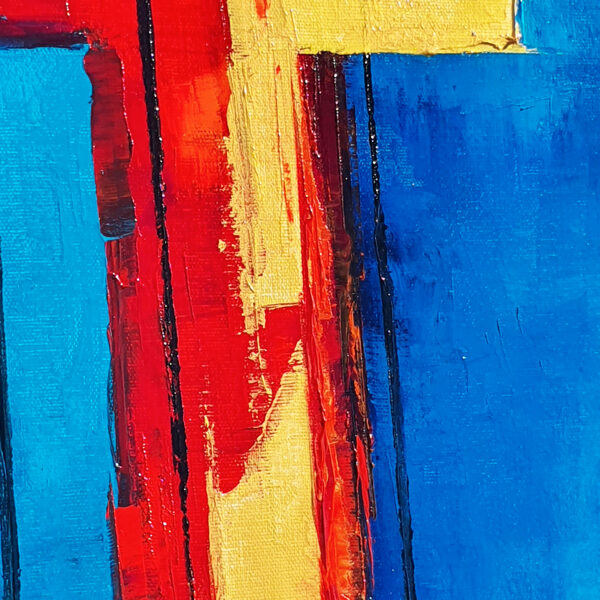
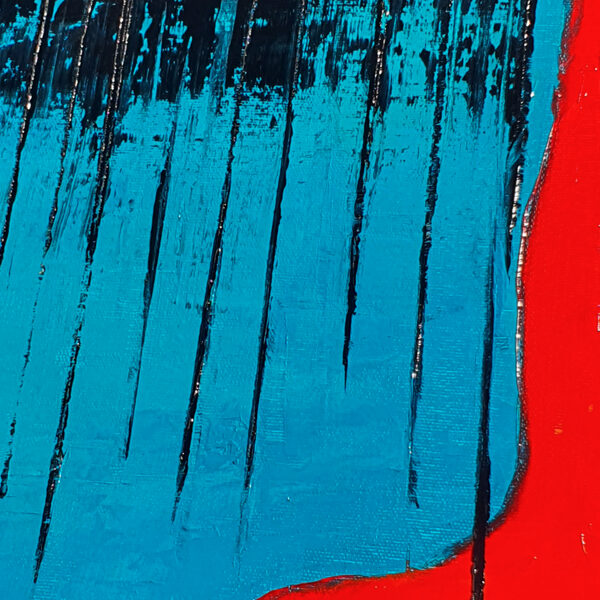

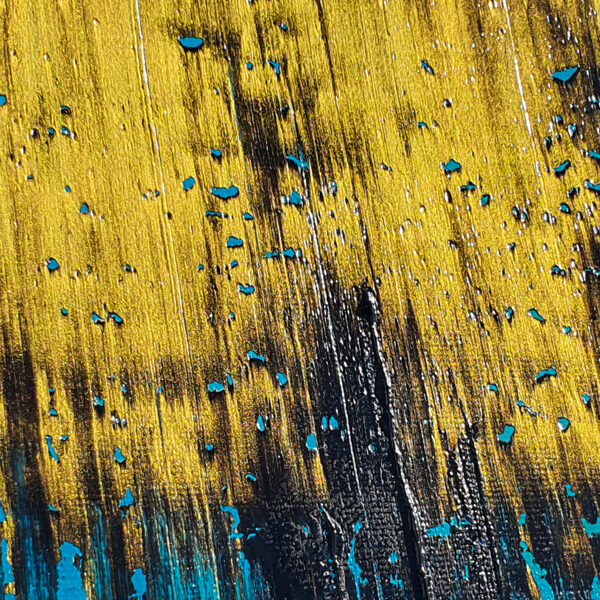
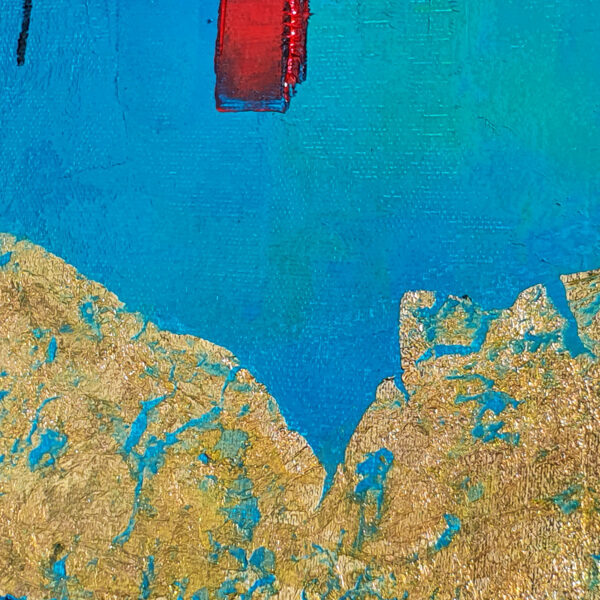
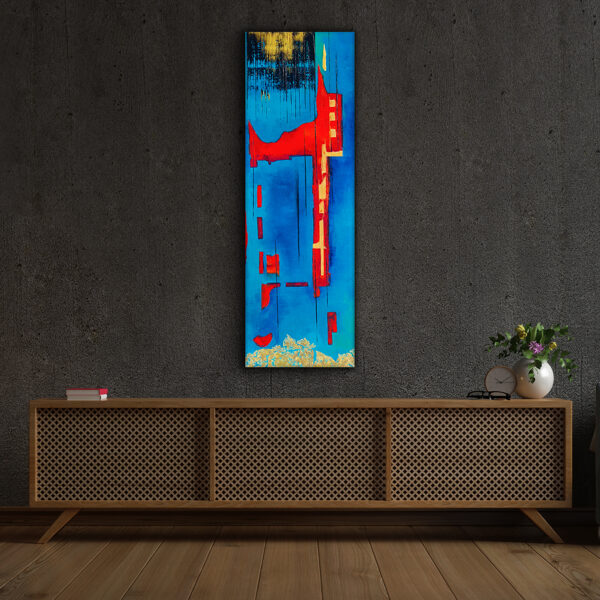
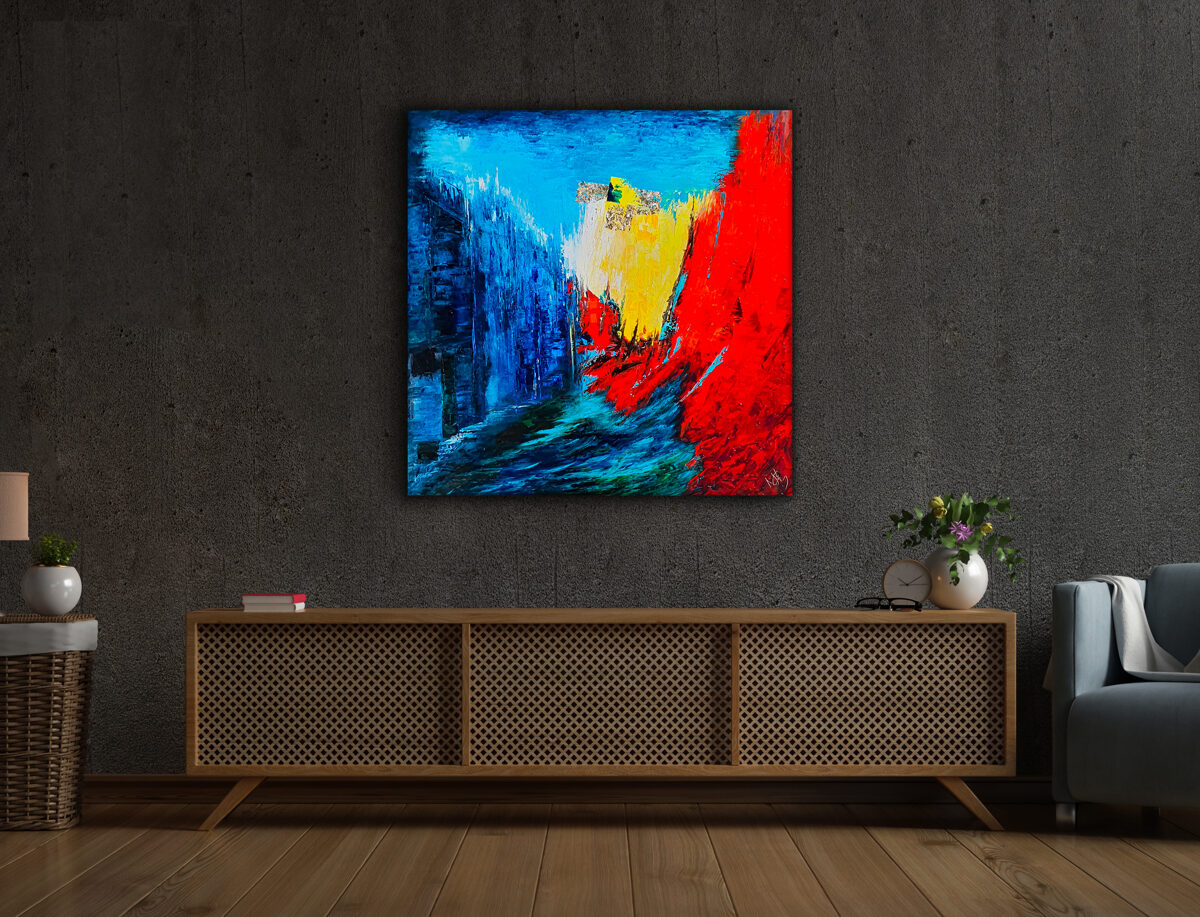
The Greek fire has now shrunk into a term associated with fireworks, although it stood for the most dangerous and devastating weapon of its time. It was a burning liquid-based flamethrower, which could be applied with the best efficiency as its fire couldn't be extinguished with water. Incendiary and flame-using weapons were already deployed in warfare in the 9th century BC, utilizing combustible materials such as sulfur, petroleum, and bitumen-based mixtures, however, the first mention of Greek fire comes from the chronicler Theophanes, who attributed the invention to the chemist Callinicus of Heliopolis. Its invention occurred during a critical period when the empire was weakened by wars against the Persians. Later, the Byzantines deployed Greek fire against Arab fleets and also in naval battles against the Saracens.
Photos of the artwork:
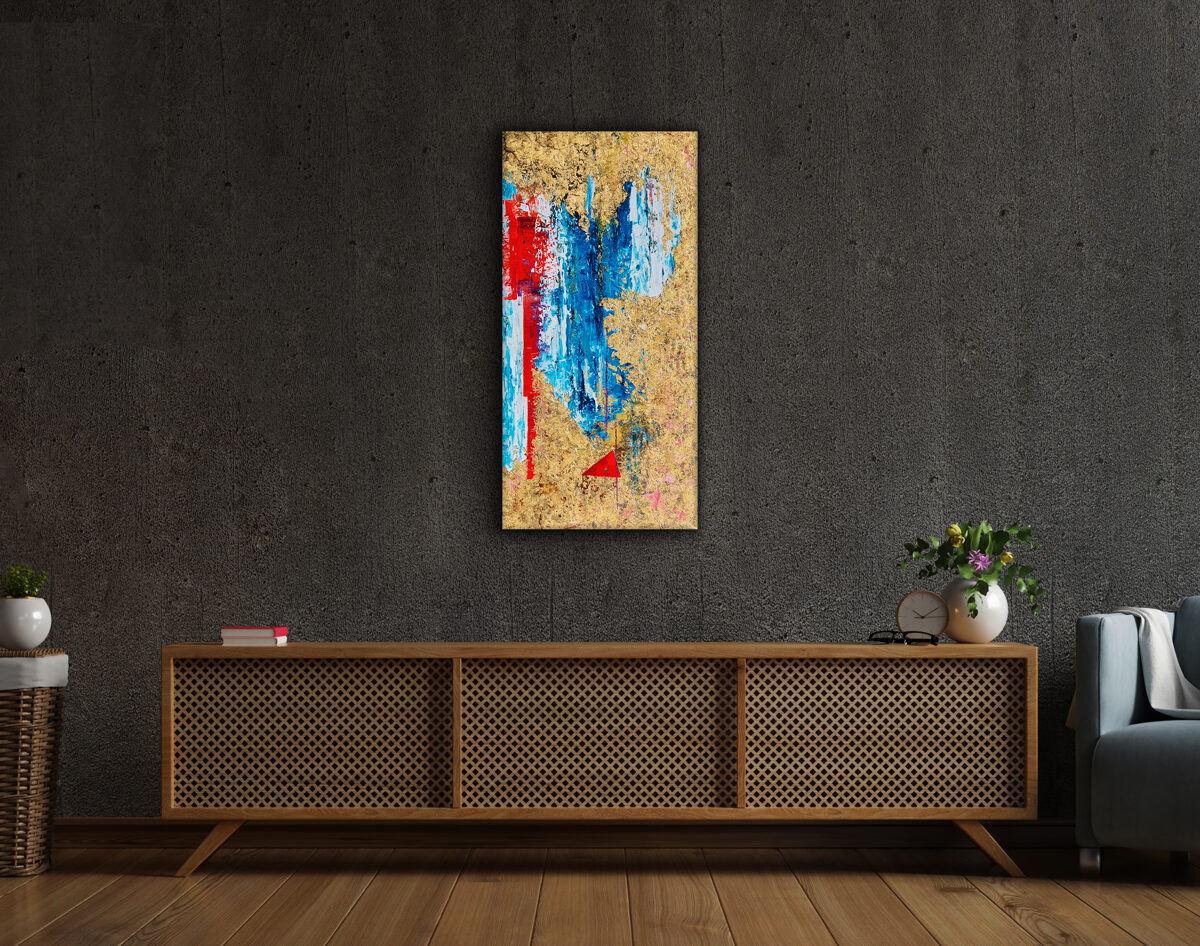
The painting depicts Thrace as a territory of wealth, its rich golden covering signals the most valuable possession of the region in abundance: plenty of sweet water in the mountain lakes and ponds. The canvas, with its petrol, turquoise, coral, and pastel pink hues, entices an idyllic state: whoever possesses the water also possesses life.
Photos of the artwork:
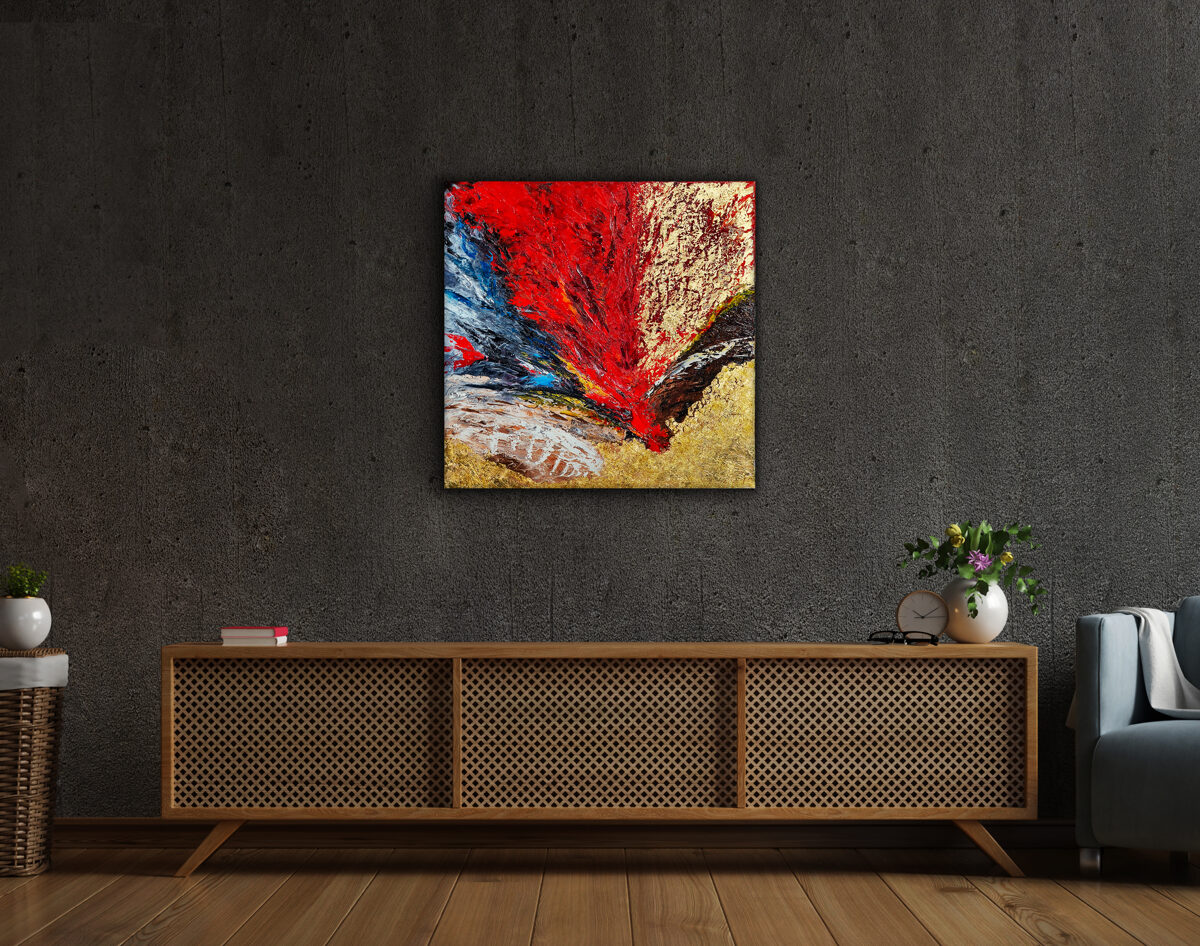
The artwork narrates the fateful moments of the encounter. The wealthy young man falls deeply in love with the courtesan and takes her into his embrace. The all-encompassing flames, however, scorch the man's independence. Fortunately, Theodora retains her wits and uses her influence for good, avoiding any misuse of power.
Photos of the artwork:

The painting is a type of macro-abstraction, starting from the structure of the Byzantine wall: limestone mortar surrounds the carved stone and the fired bricks enclosing it. Within these, the series and the outcome of the struggles of the Byzantine Empire unfold. On the right side, the city's astonishing wealth is depicted, in the turquoise bands the preordained destiny is revealed, and in the miniatures, the empire's burning is recognizable. The Ottoman Empire strives to destroy the cultural heritage of Byzantium.
Photos of the artwork:
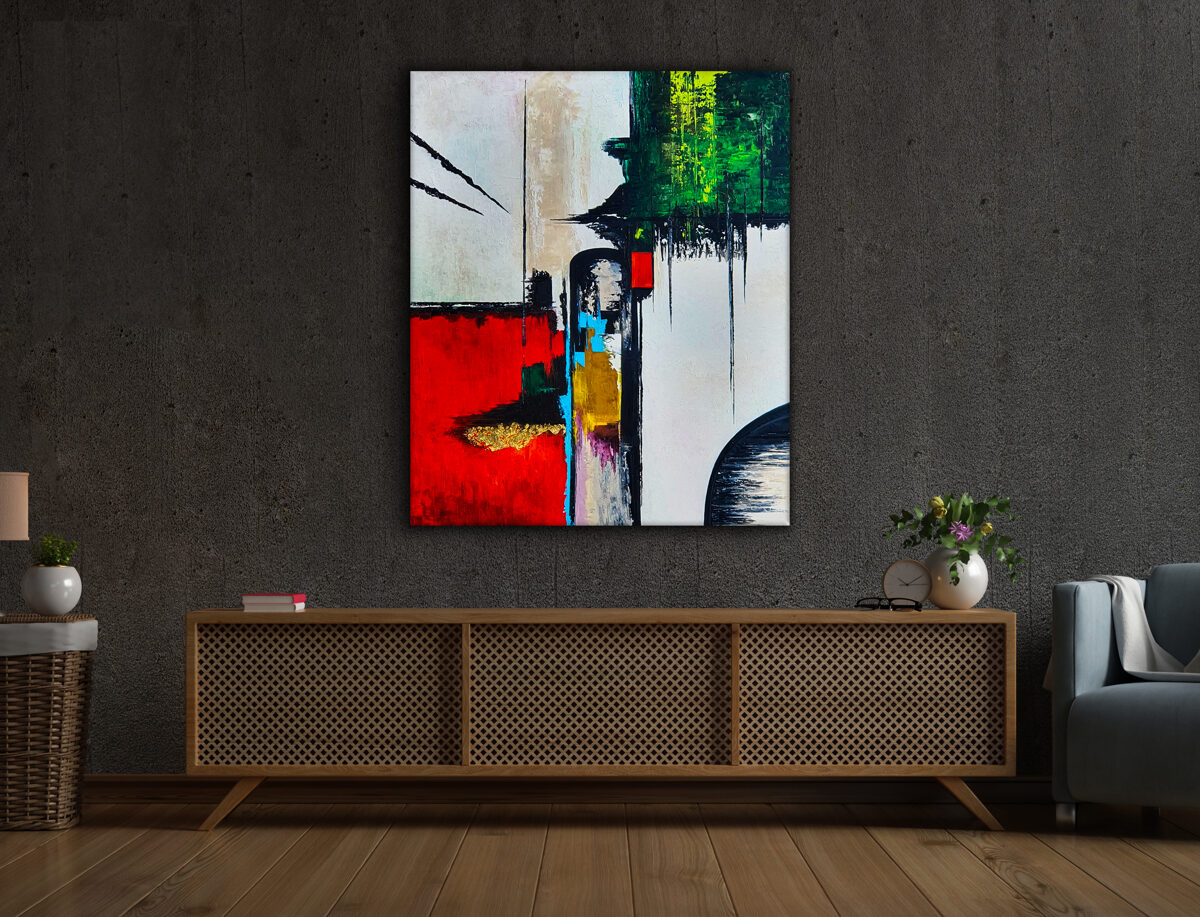
In the central part of the artwork, acting as an axis that divides the canvas, we discover the distinctive shape of the Hippodrome, inside it, the imperial tribune sparkles like jewelry with a covering of gold and turquoise, and an amethyst-colored granite obelisk also appears. In the diagonal of the four-part surface the balanced fracture composed of quartz, crystal, and sand tones is disrupted by sharp, geometric, dark lines. The black, needle-pointed spears flowing out of the angry green field may suggest growing discontent as they tint the surface. Because the greens provide the final push for the uprising. Yet, the tyrannical cruelty of Justinian could not be swept away. The reddish field commemorates the series of events where the emperor quells the rebellion in blood, thereby stabilizing his throne. The increasingly spreading golden fields symbolize the reasserting imperial power.
Photos of the artwork:
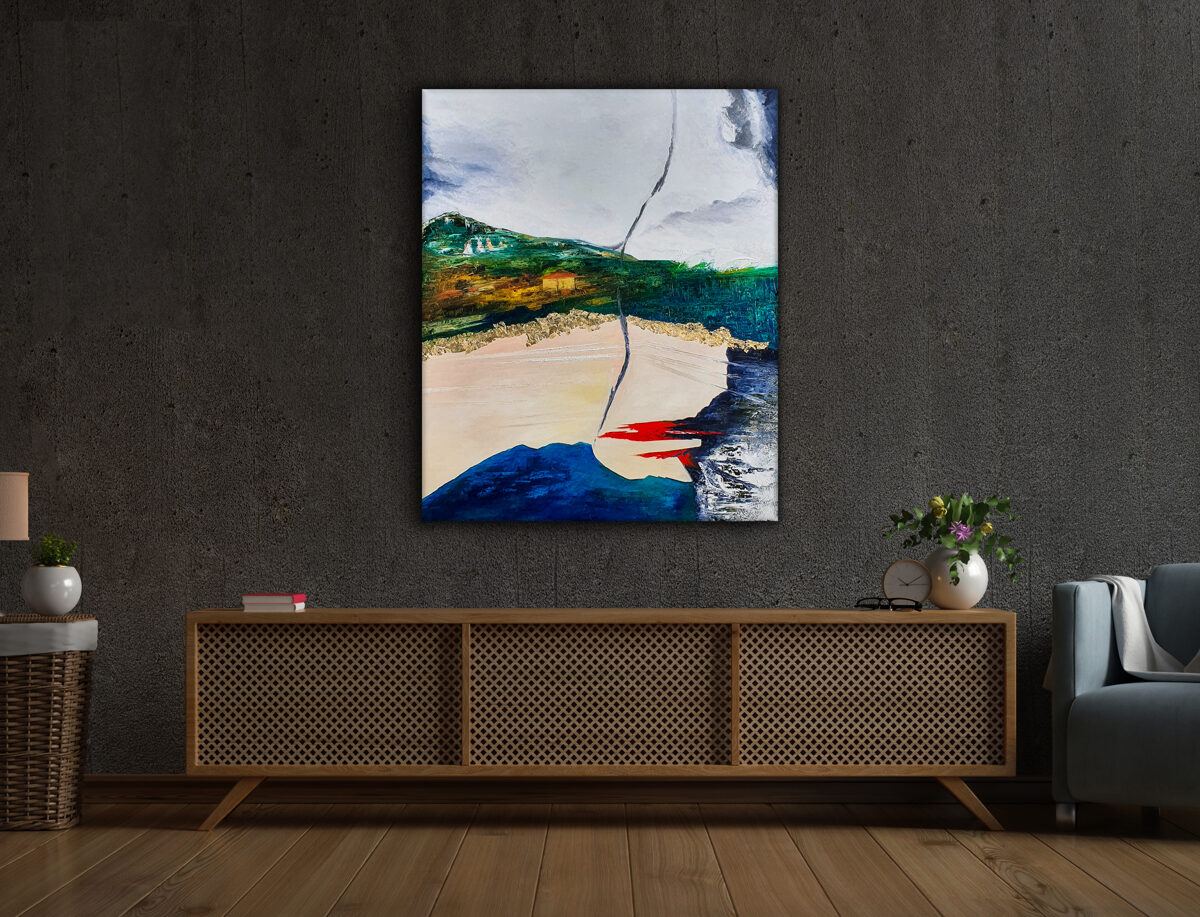
Photos of the artwork:
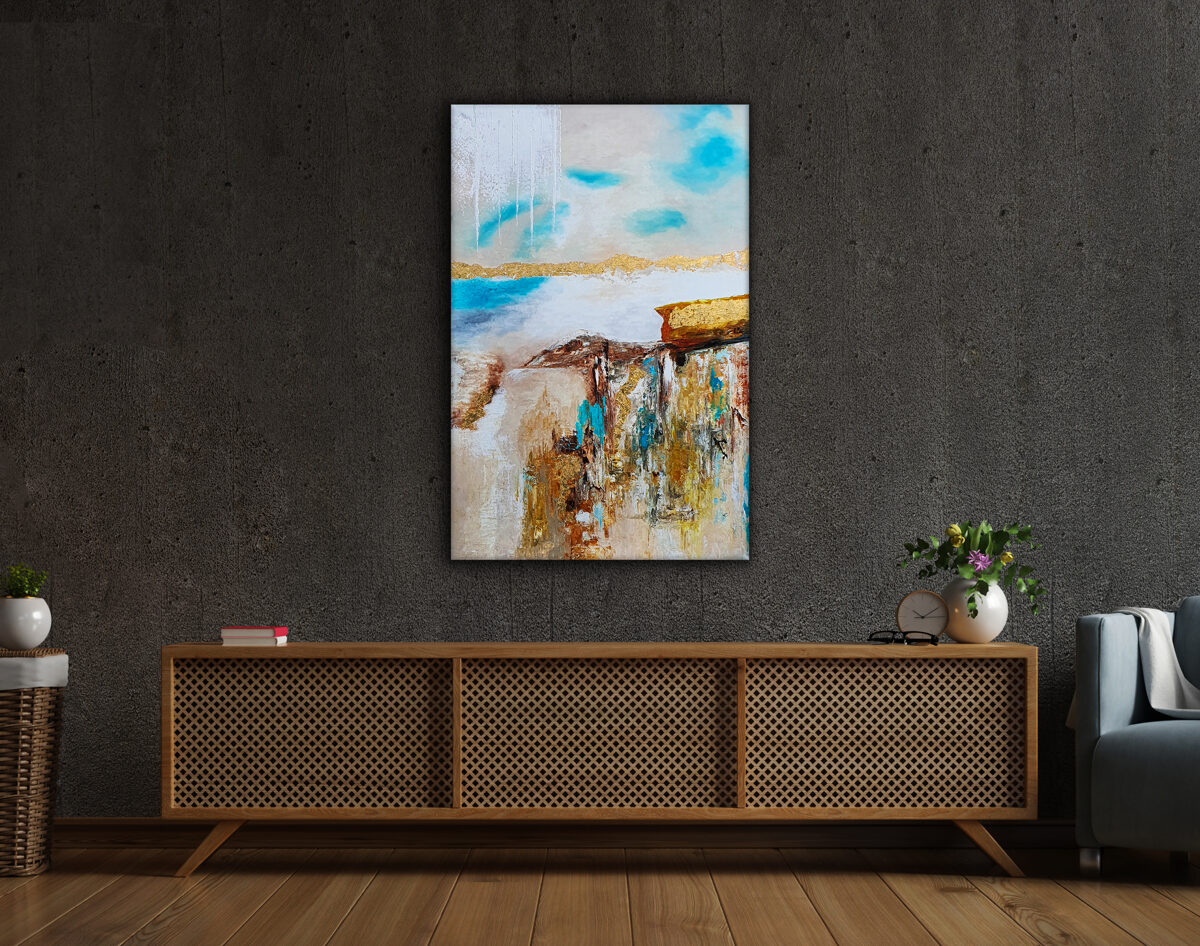

The artist's brush does not depict the historically challenging and somber period, but something quite the opposite: on the canvas, an untouched celestial purity emerges. It portrays an ethereal state, such a pristine condition after creation, which simultaneously embodies the goodness of birth. The opalescent, tranquil sky and the below landscape painted in the hues of minerals and earth evokes the beginning of time when a unified state of the soul levitated on the horizon. The symbolism of the quadrich is easily interpretable: the world, wonderfully and perfectly created by God in its paradoxically diverse uniformity, is shaped and molded by us, the people of each era, into what it ultimately becomes.
Photos of the artwork: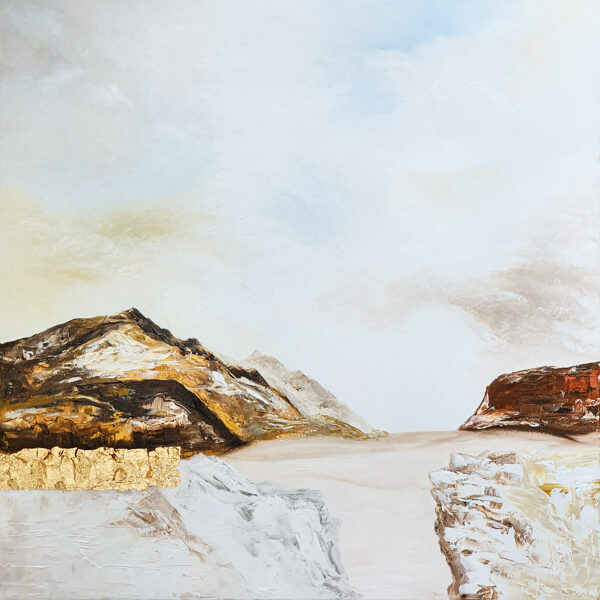
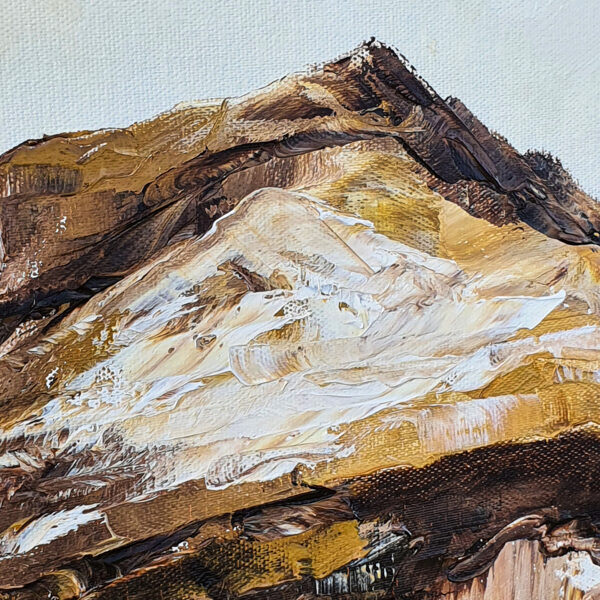
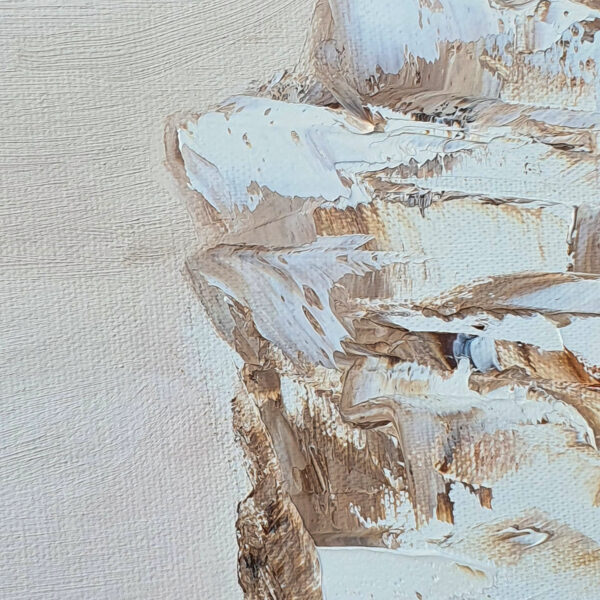
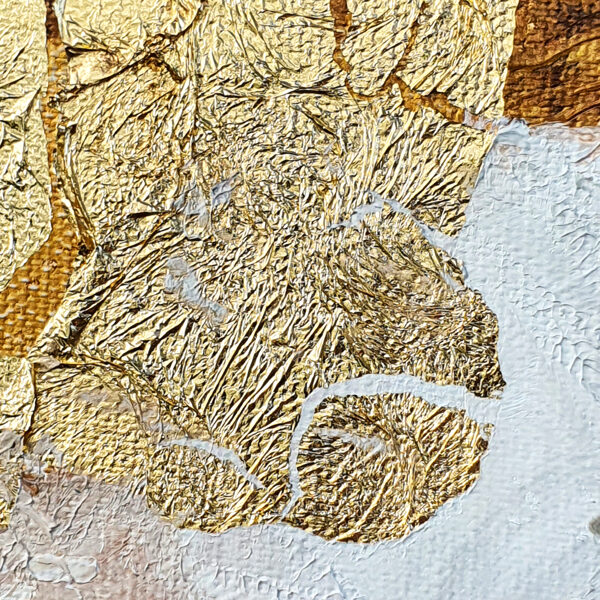
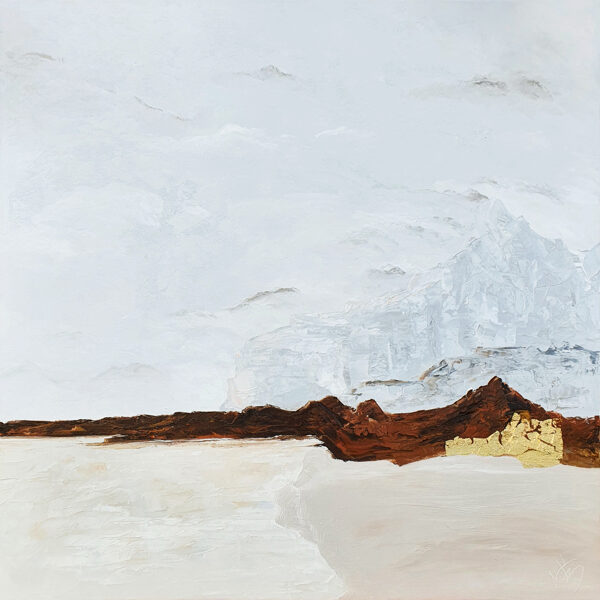
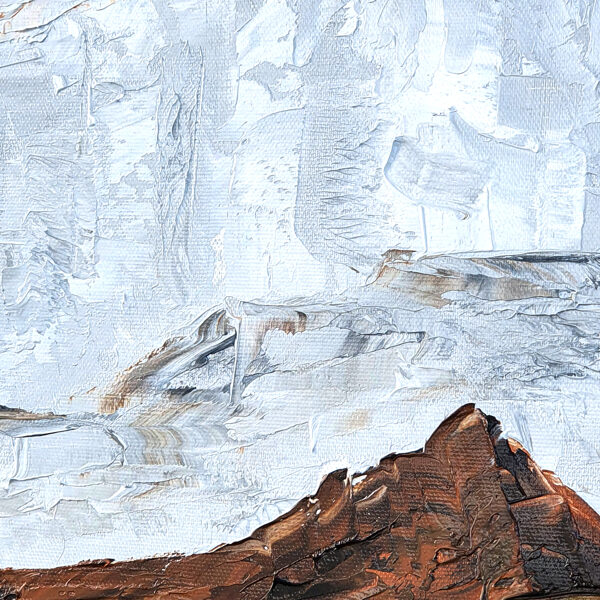
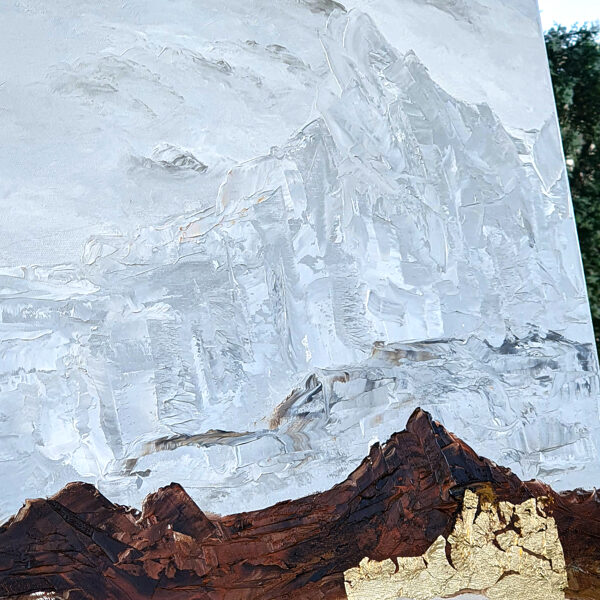
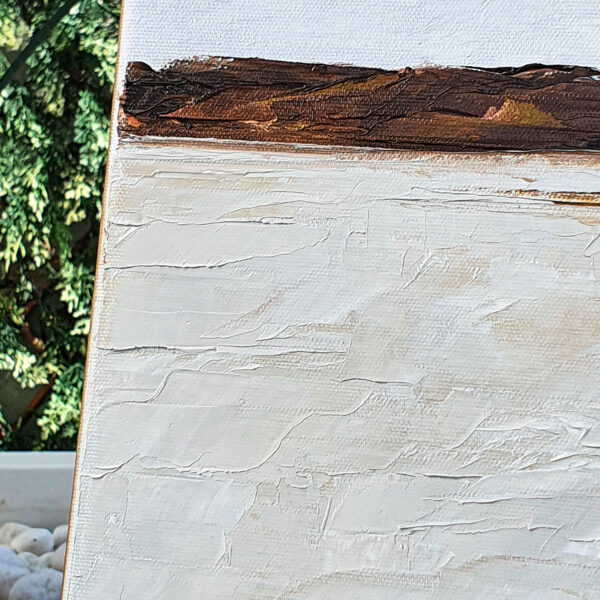
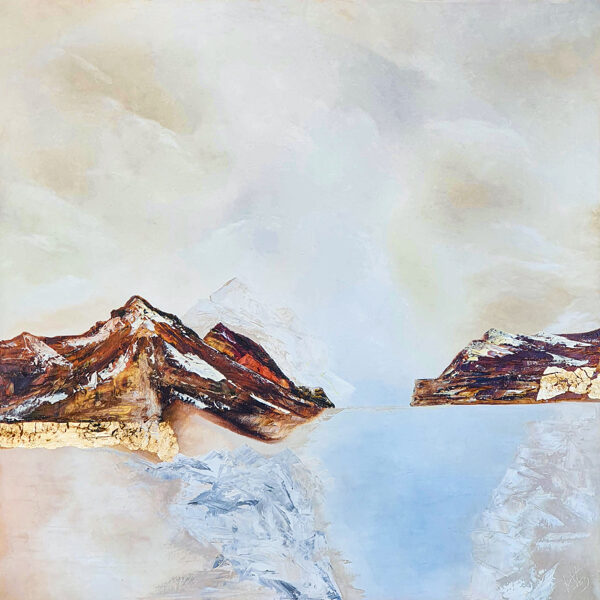

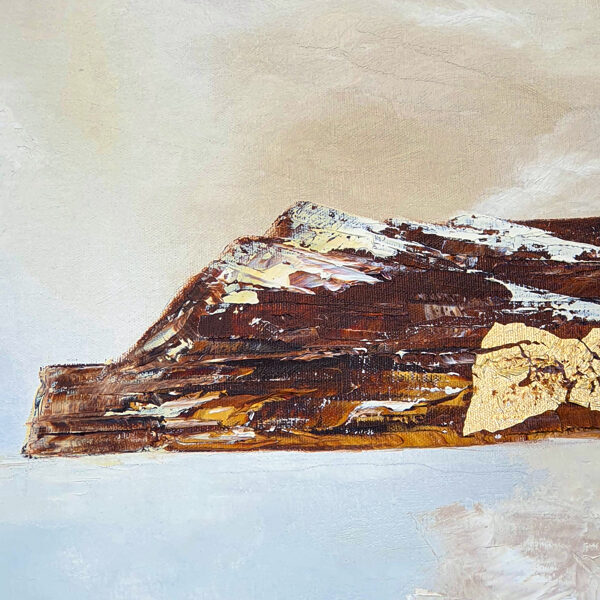
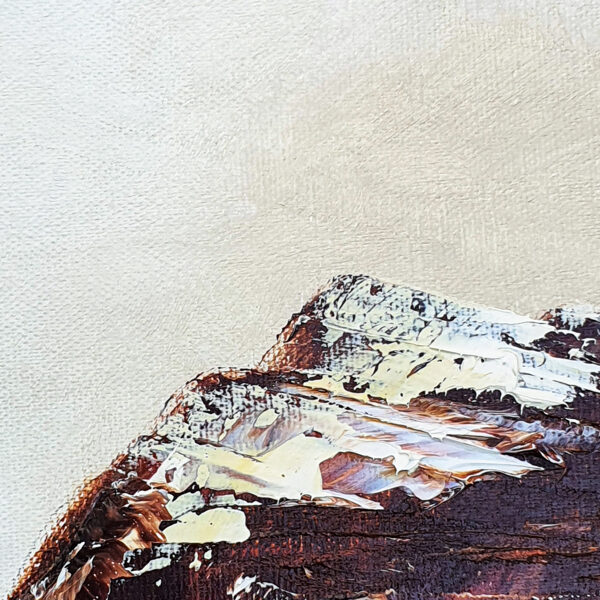
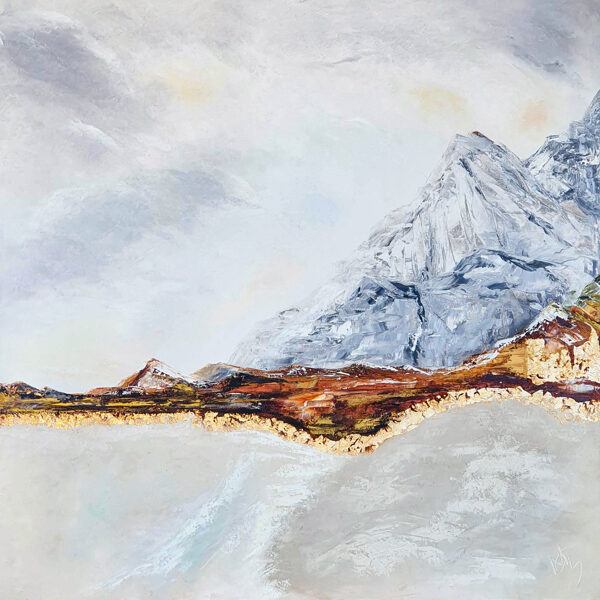
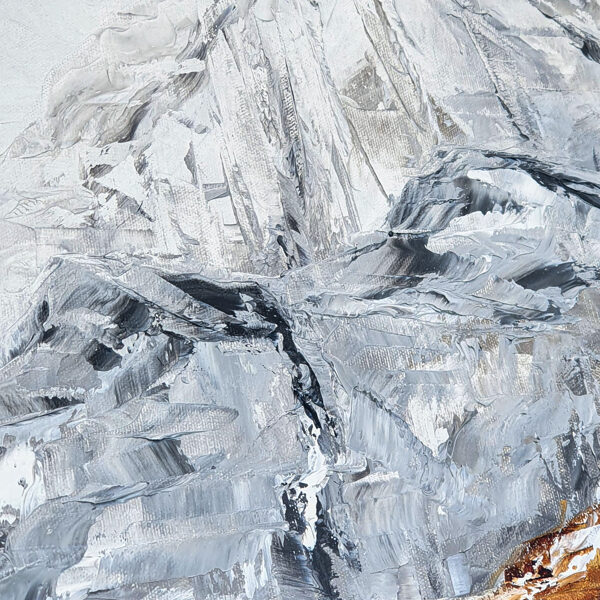
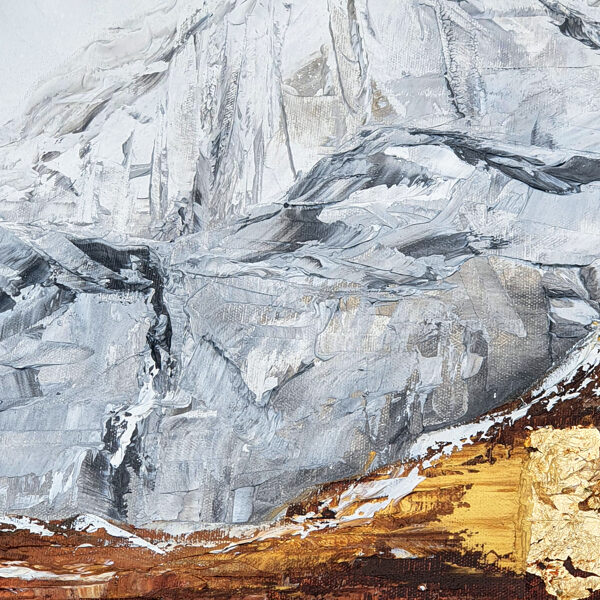
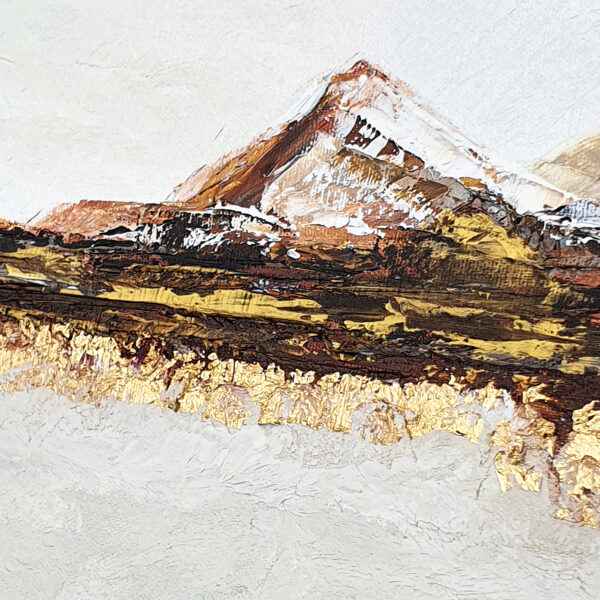

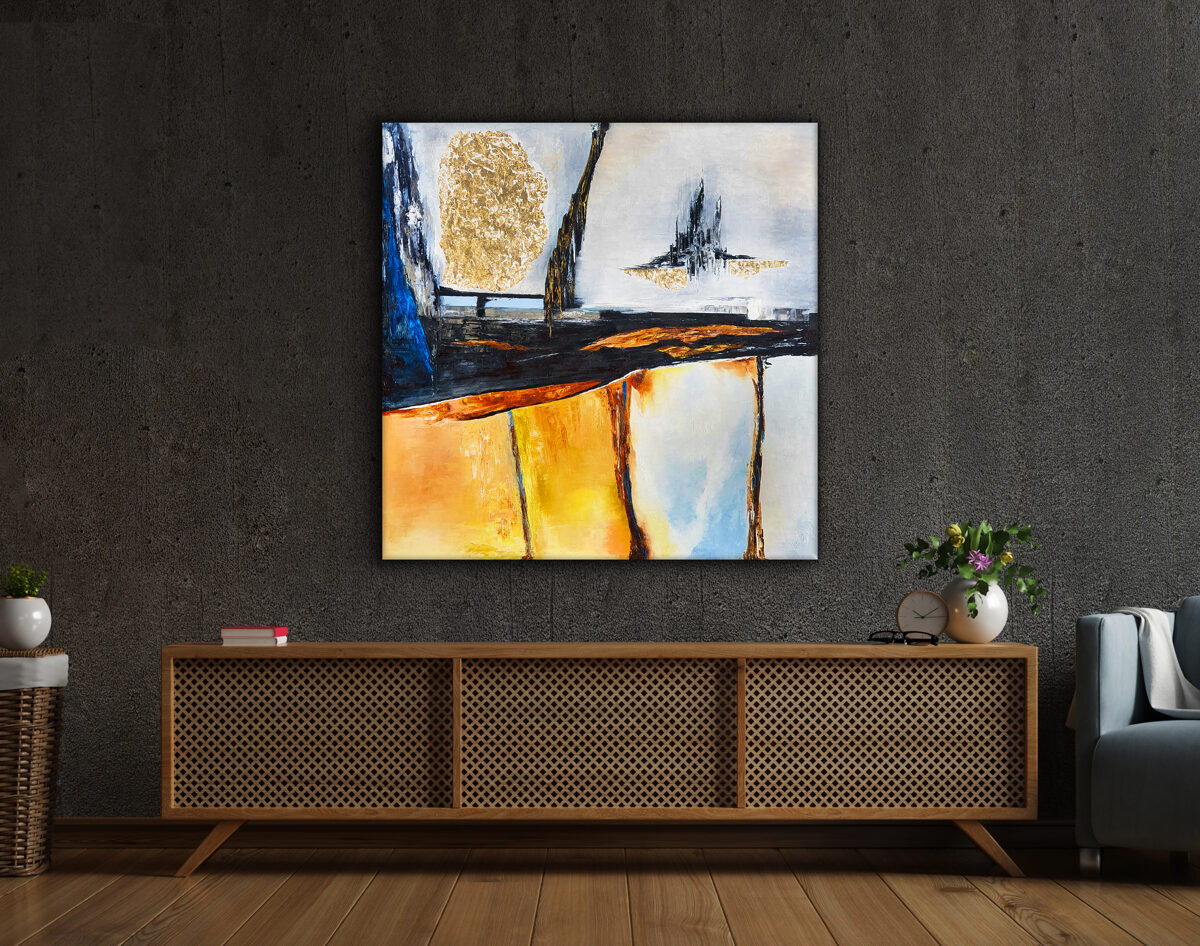
In abstraction, the artist horizontally divides the canvas into two fields: in the center, contrasting with the infinitely delicate mist, a prominent and dark line appears as the eternal and unchangeable plane of time. On the vertical, towering, rocky mountain-like structure, a turquoise waterfall symbolizing creation cascades down repeatedly, penetrating the depth of the plane of time. On the left, above, a massive, golden stone block emerges, its dignified motion is attempted to be blocked by a rising formation.
Photos of the artwork: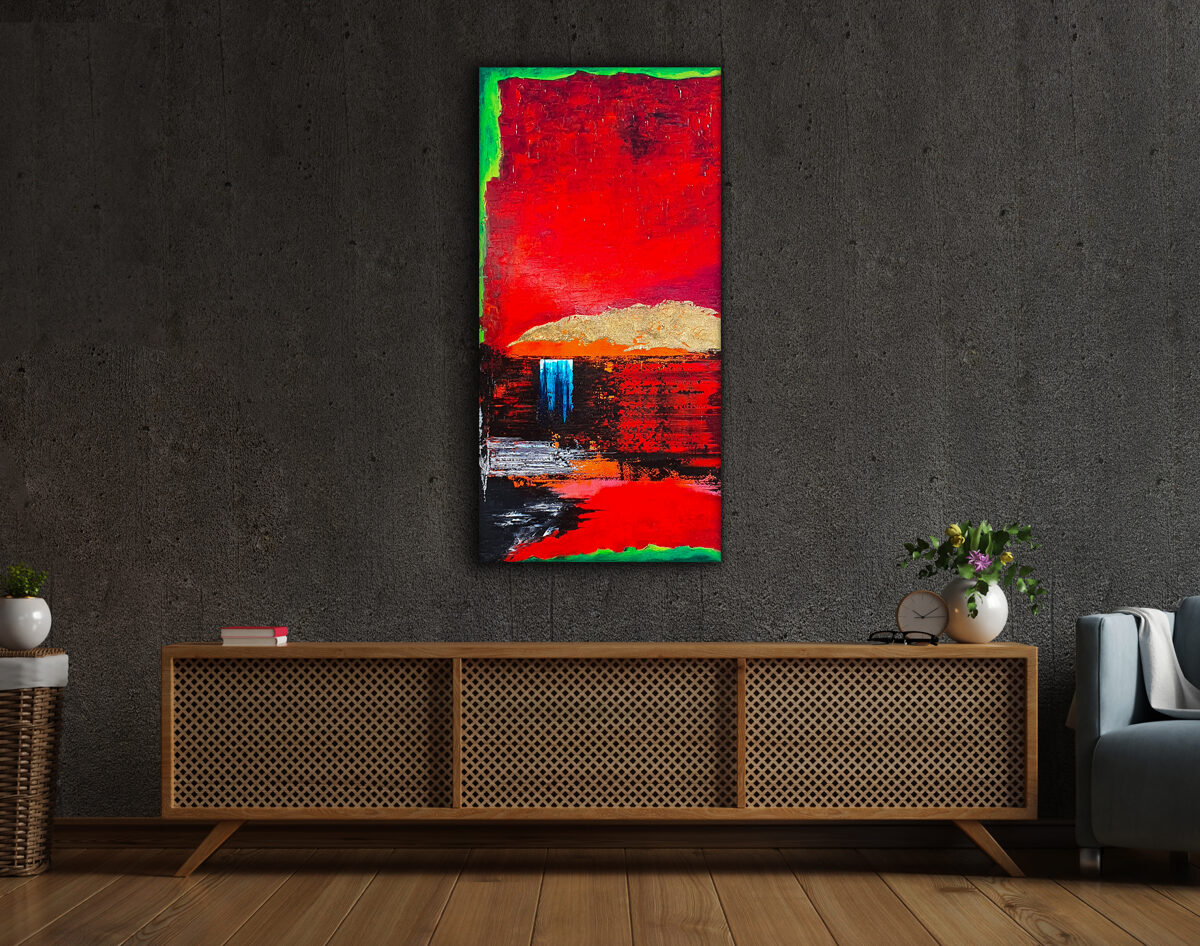
The artwork portrays the struggle of Constantinople with dramatic colors and visual forms. While the sky is engulfed in a fiery red, the Golden Horn shines in a divine glow, protecting the city's territory. However, the Ottoman forces, darkening everything in their path, deploy strong soldiers who drag the naval fleet over land, launching an attack on the city from the water. The emperor also falls in battle. As the vibrant green fields representing life realised in grace are pushed out of the canvas, so too is Christianity expelled from the region... the Muslims conquer and take possession of the territory.
Photos of the artwork:
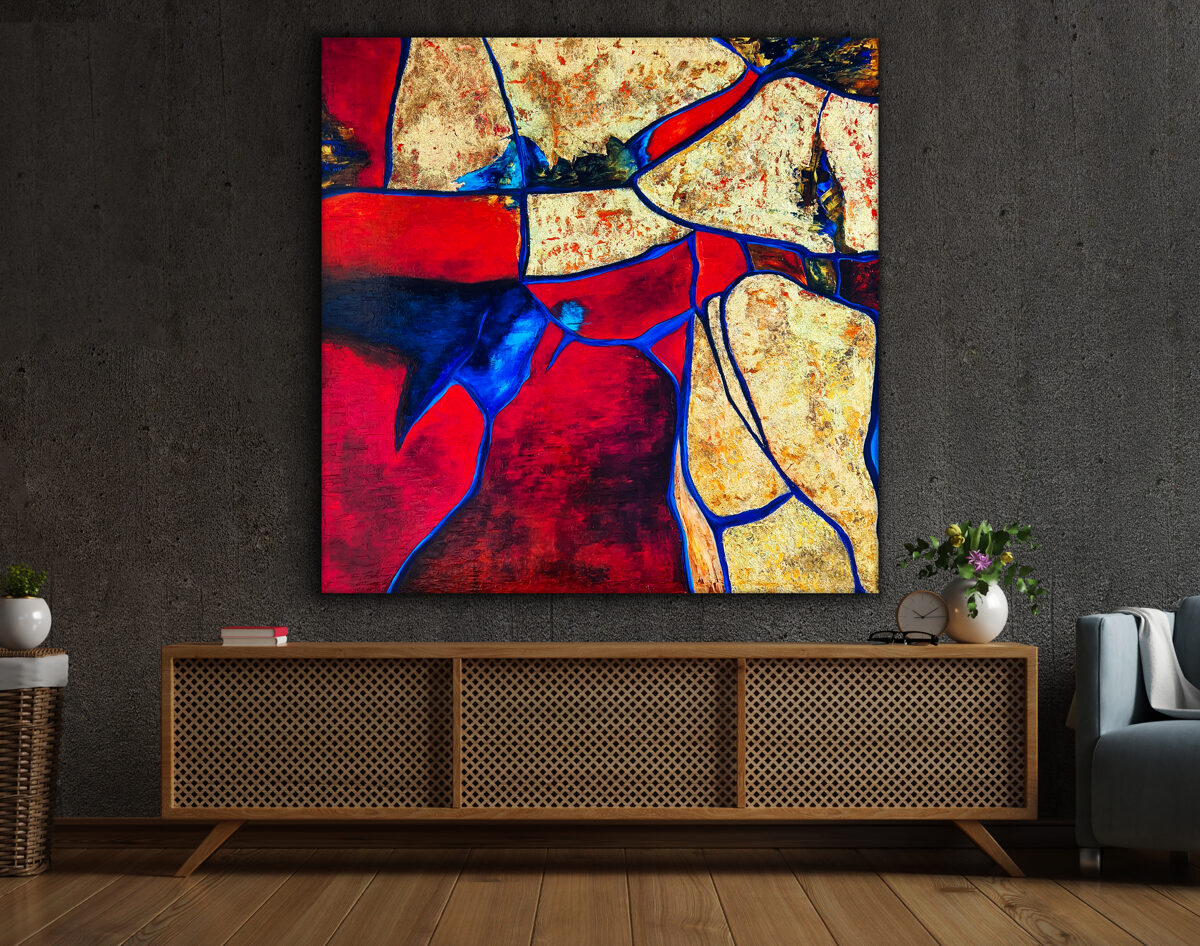
In the colors and visual language of this monumental creation, the ancient Byzantine Empire is projected before us. The various gilding techniques of gold evoke the gilding of monastery walls in different eras, the deep burgundy, blood red, and crimson represent the characteristic colors of imperial power, while lapis lazuli and turquoise, mingling with earth tones that ennobles them, depict different regions, seas, waters, and aqueducts. In the left-central part of the composition the heart of the Empire emerges.
Photos of the artwork:
"...I Will Go Until He Who Leads Stops Me"
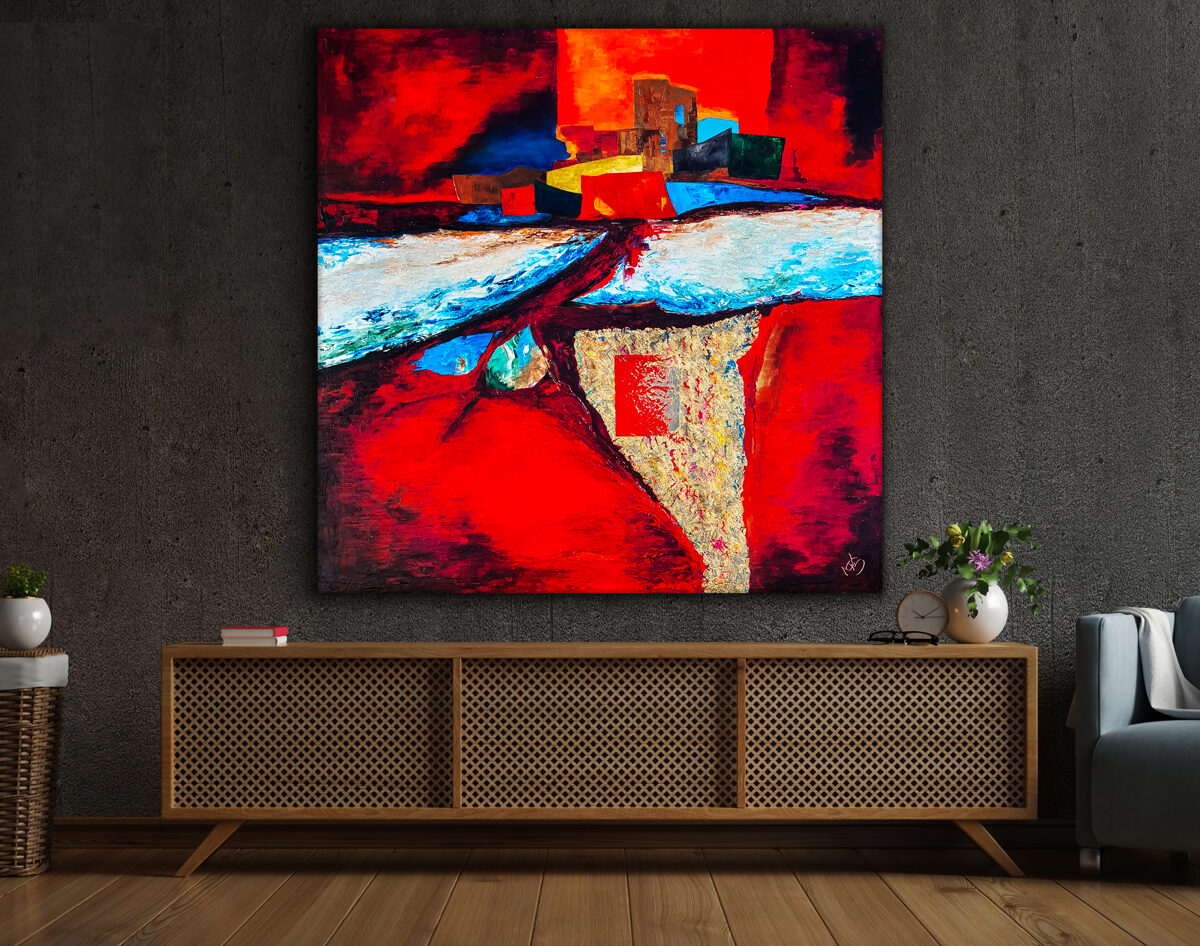
The title of the artwork is the sentence spoken by Constantine the Great when, with a stick, he drew his visions of the city's size and location in the sand for the architects. Astonished by the unabashed megalomania, the architects asked, "How far will you expand? And what should we expect, how far will we go?" Constantine replied that until God, or in other words, until his death stops him, they will march forward.
The composition expresses and reveals the timeless importance of foundations with a so-called elevated horizon: the will protected by faith, deeply embedded in the reddish, velvety river, and the rich waters enveloping the territory. In the upper third of the canvas, the outlines of a marvelous city in the burning fever of ideas unfold, in front of which the gate to eternity leading into the infinite.
Photos of the artwork:
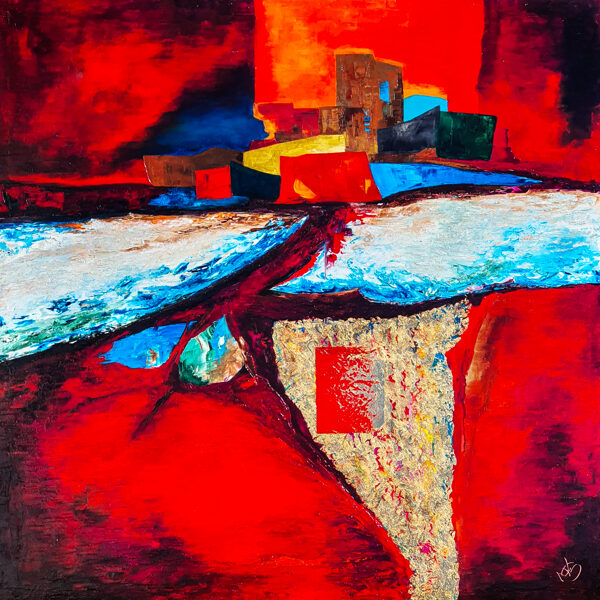
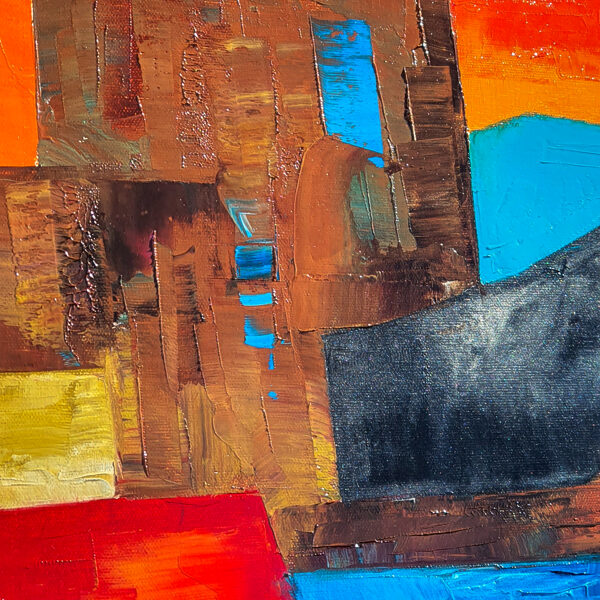

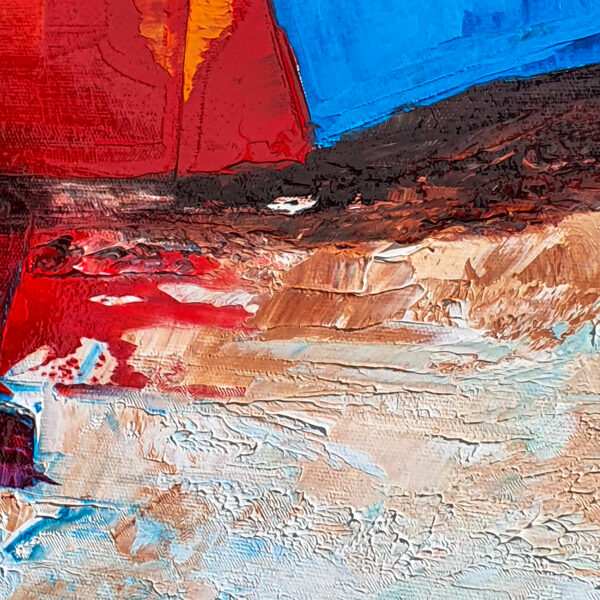
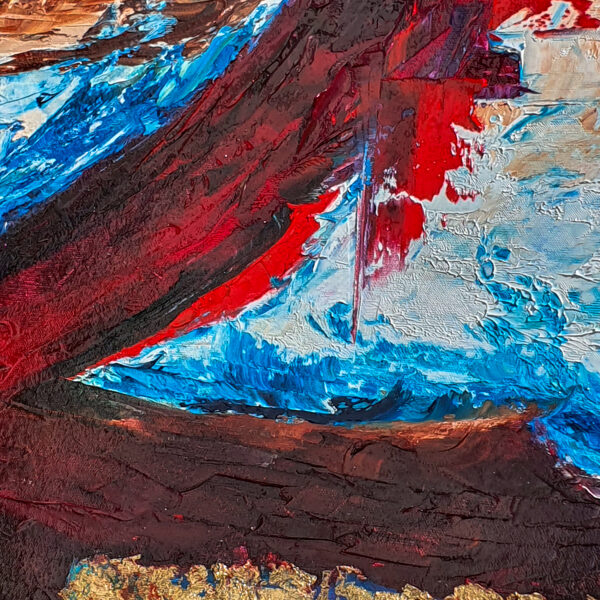
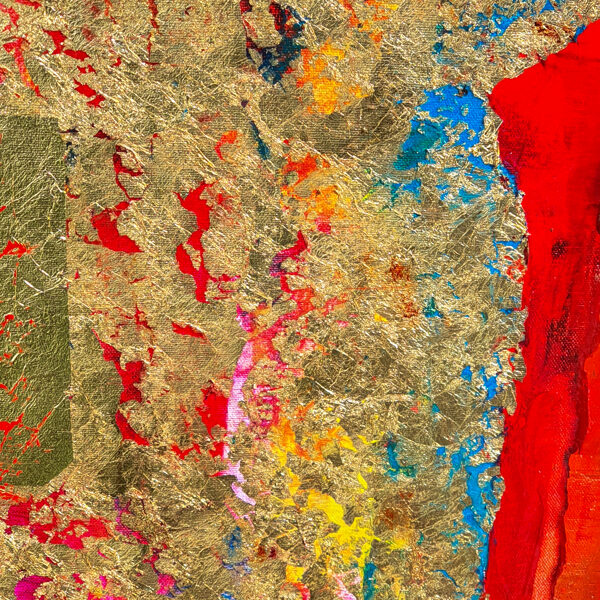
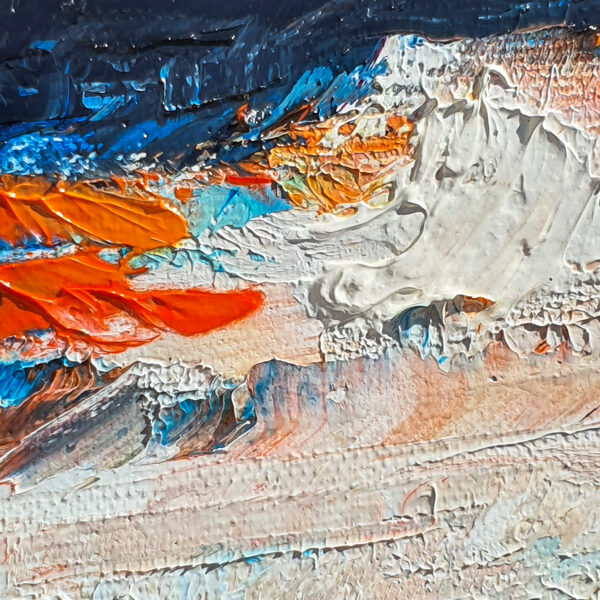
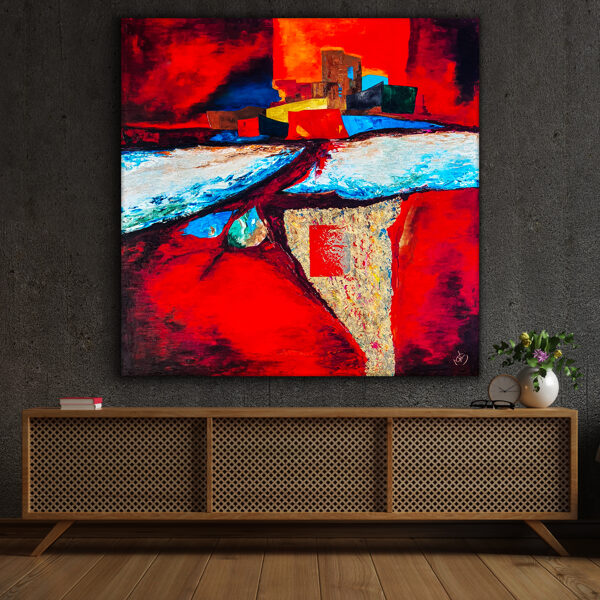
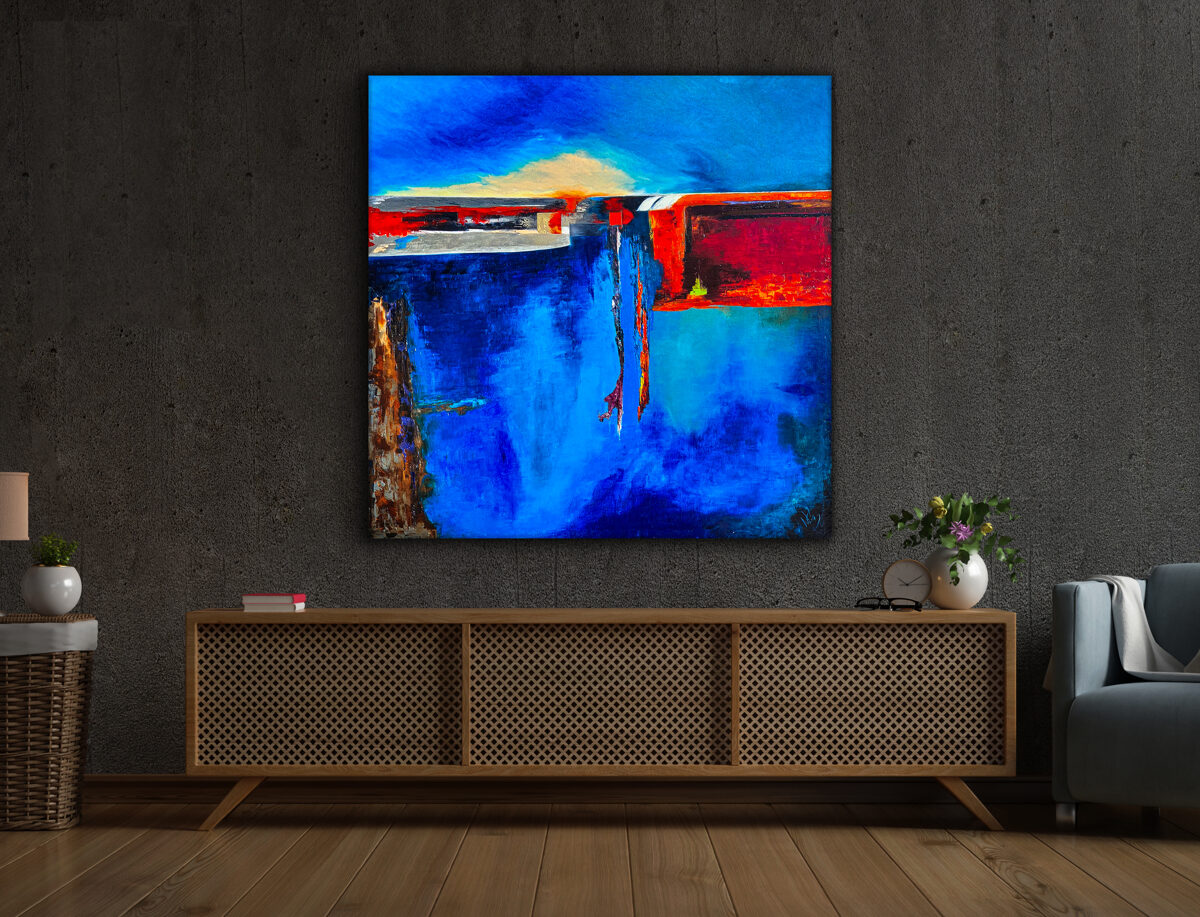
In the canvas divided into four parts, Constantinople unfolds before us from an imaginary viewpoint, presenting the city and its surrounding area in a cross-section-like vision, paying tribute to the genius of ancient architects. The strip below the left horizon showcases a meticulously constructed city with a multi-layered infrastructure, as the use of a material akin to modern concrete was present at that time, and their underground construction was also significant, evidenced by the massive subterranean water reservoir systems supplying the entire population of the capital. On the right side, the space governed by the deeply embedded imperial order is visible and in the center the reddish square symbolizes the altar, connecting the divided parts not unlike a focal point. Constantinople is also the ruler of the seas, reaching and controlling three seas through its straits (Bosphorus, Dardanelles).
Photos of the artwork:
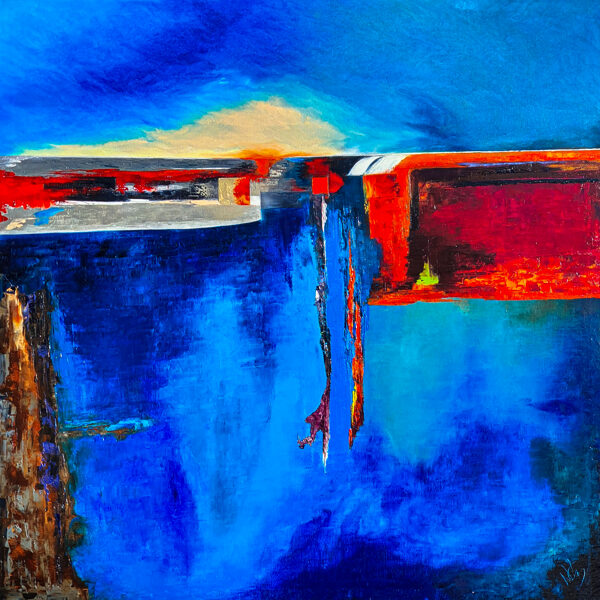
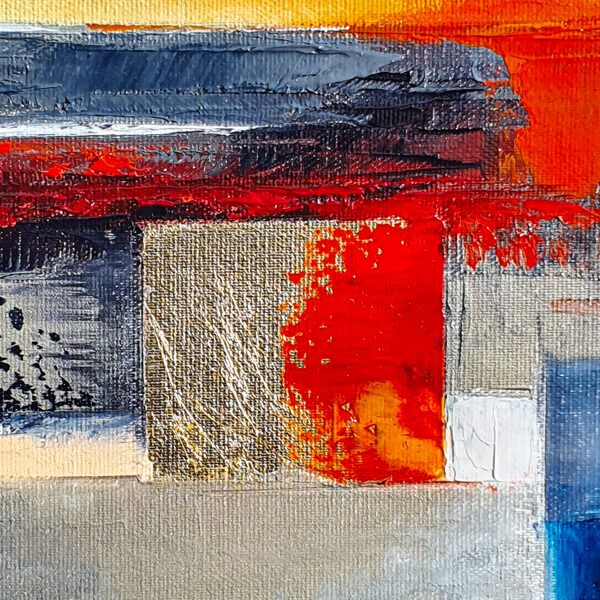
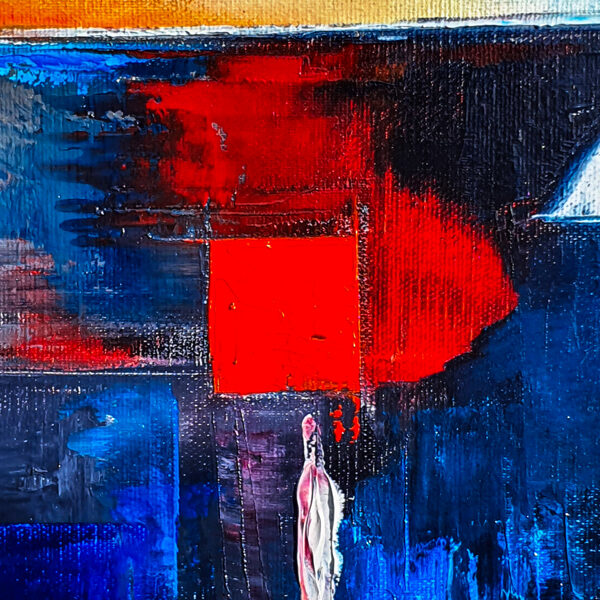
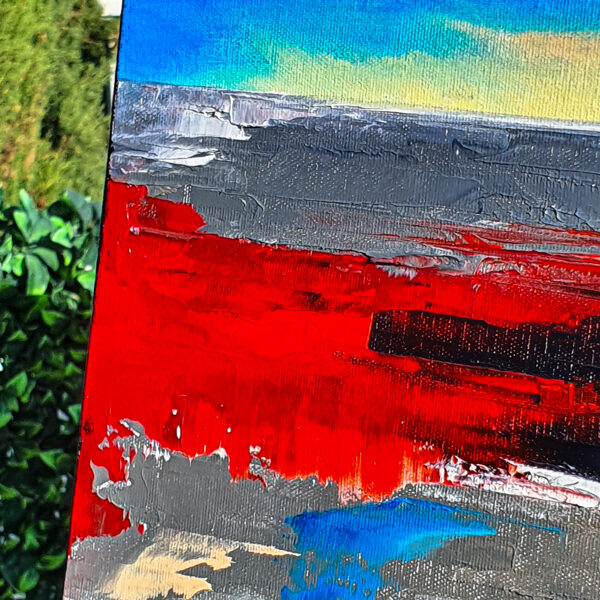

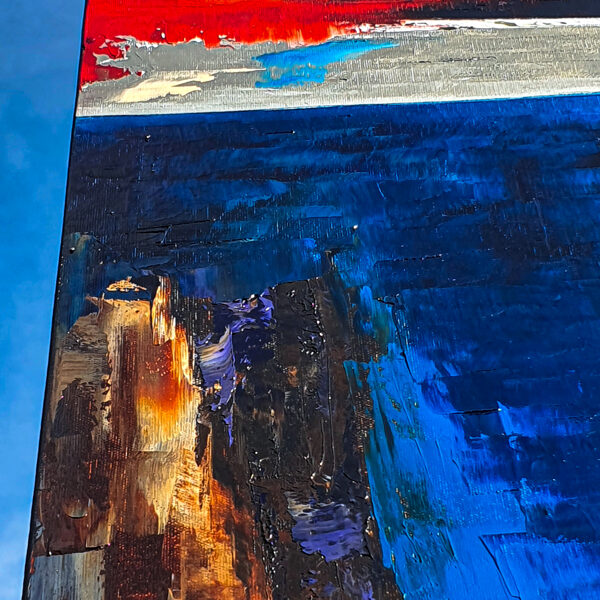
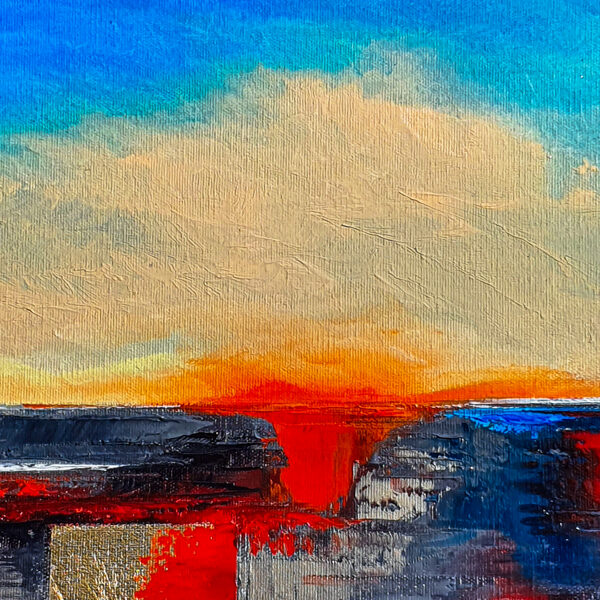

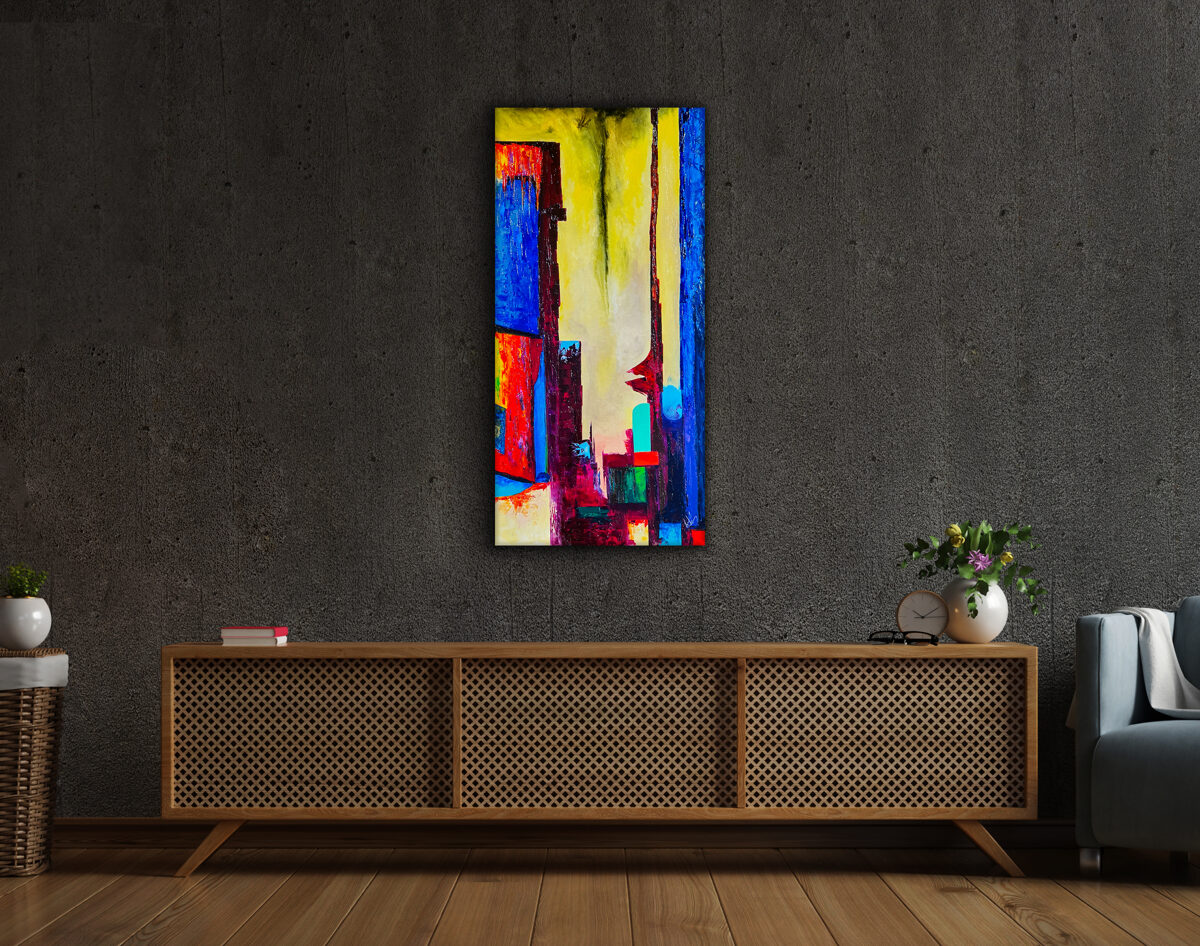
The great Forum known as the Augustaion was famous throughout the Middle Ages. Perhaps it existed even before Constantine, encompassing the former city of Byzantium's agora, its central square, which the emperor later had reconstructed. Colonnades stretched on both sides, adorned with various statues. One was even depicting Constantine and his mother Helena standing at the side of the cross.
The abstraction portrays the city in the distinctive colors of ancient Rome, its certain elements, beyond being easily identified, carry additional meanings. The pale, gold-like sky, with an obelisk extending beyond it, symbolizes infinity, while the blues and turquoises represent dominion over the seas. The swirling, circular form suggests the Basilica, in its depths the symbolism of the altar can be discovered.
Photos of the artwork:
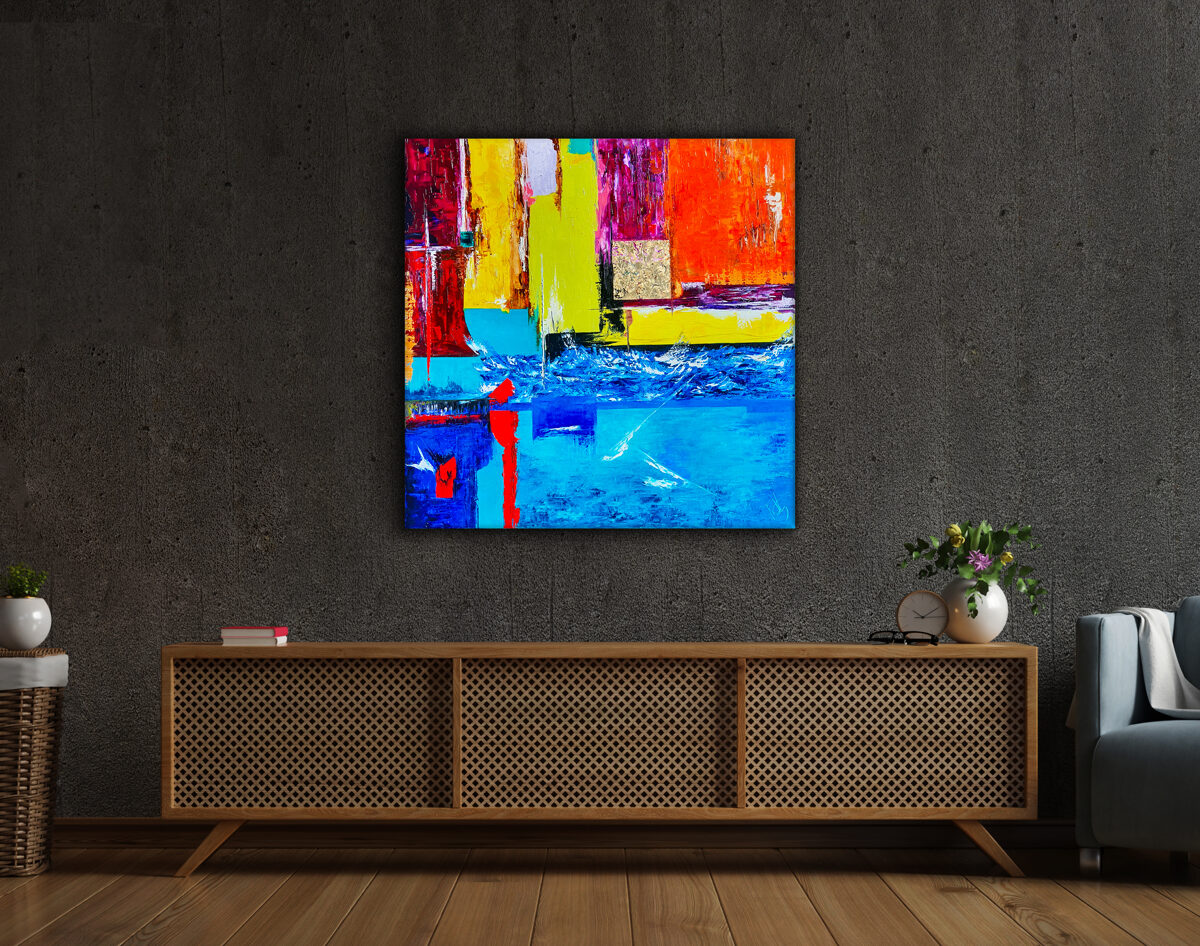
The abstraction enumerates the most significant provinces of the Byzantine Empire, serving all the interests of conquerors in strict order. First, the purple Holy Land appears, connected with the Syrian territories through the famous emerald seal of Pope Urban V, for which he relinquished parts of the borderlands in the Second Crusade. This is followed by Iberia, Thrace, and Mesopotamia.
In the lower region of the artwork, the seas emerge; on the left, the outline of Venice rises from the viewpoint of the sea, being the most significant trade destination, below which the river Strymon is depicted, featuring a Minotaur motif and finally, the journey of Apollo from Phrygian Heliopolis through the seas to the city of Constantine is portrayed.
Photos of the artwork:
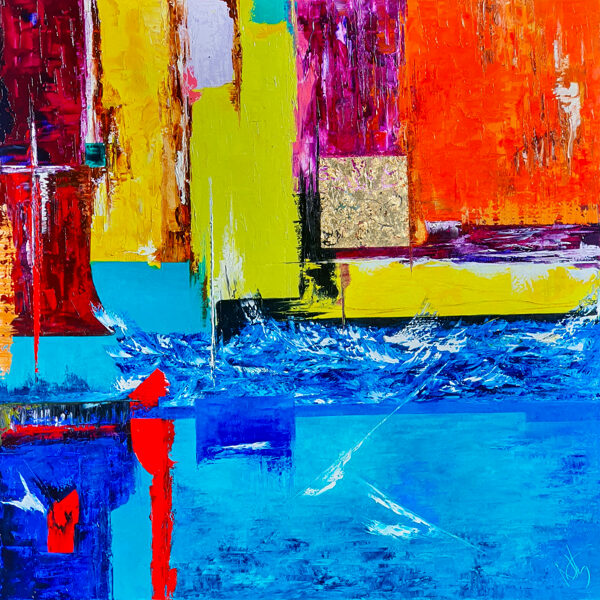
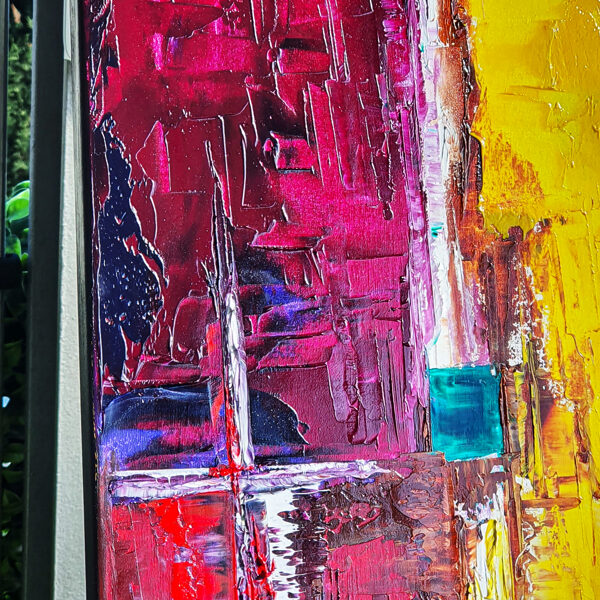
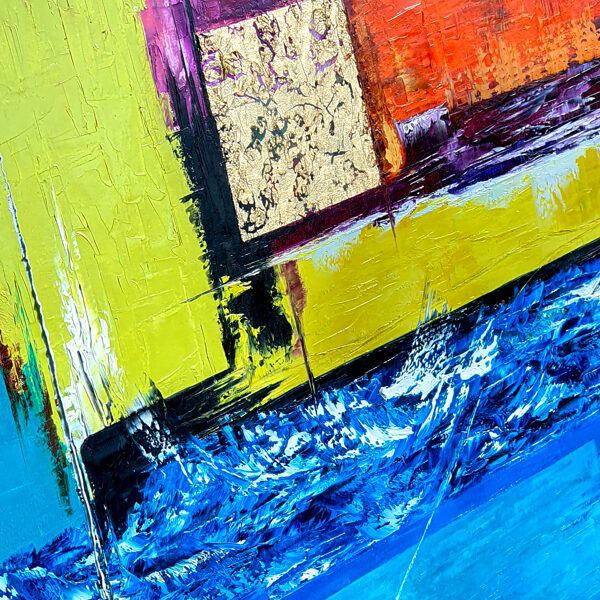
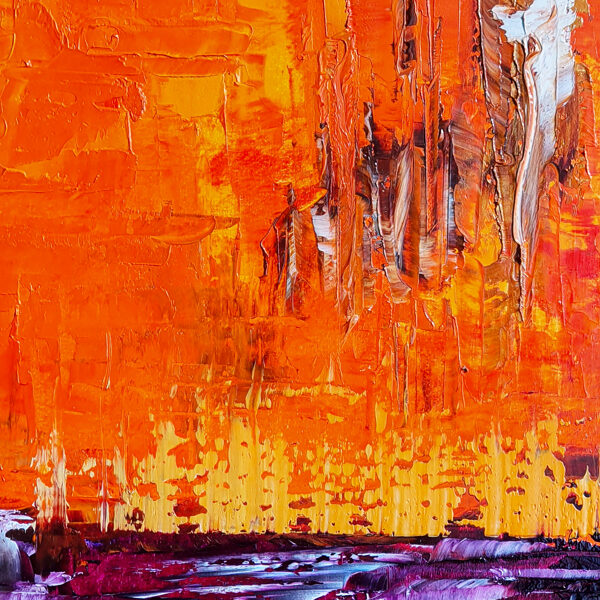
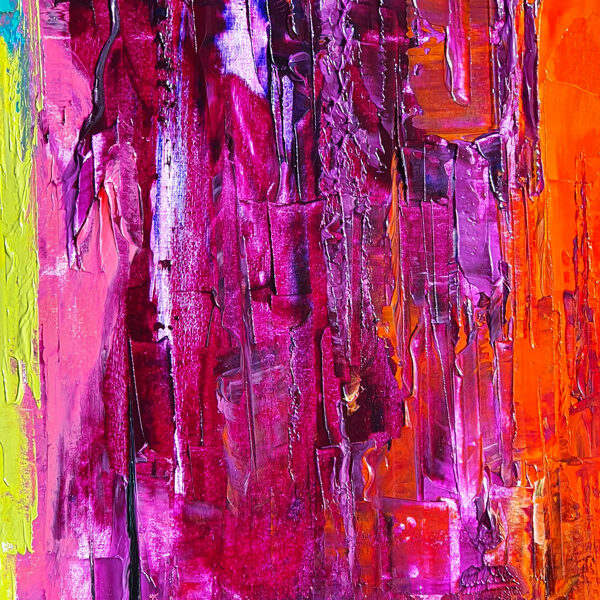

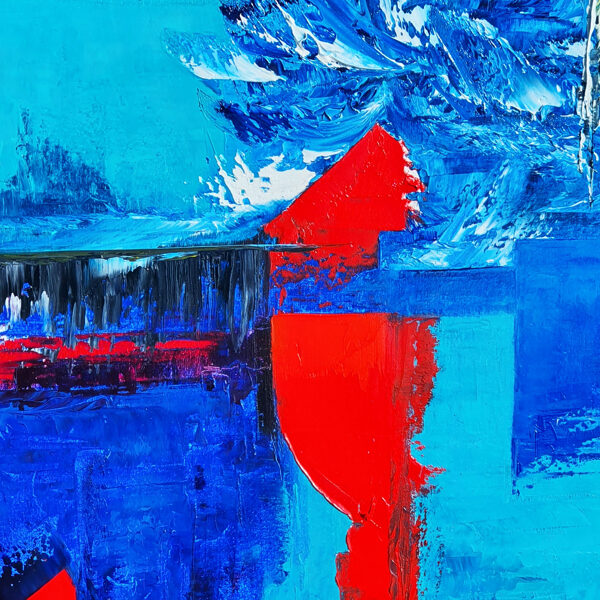
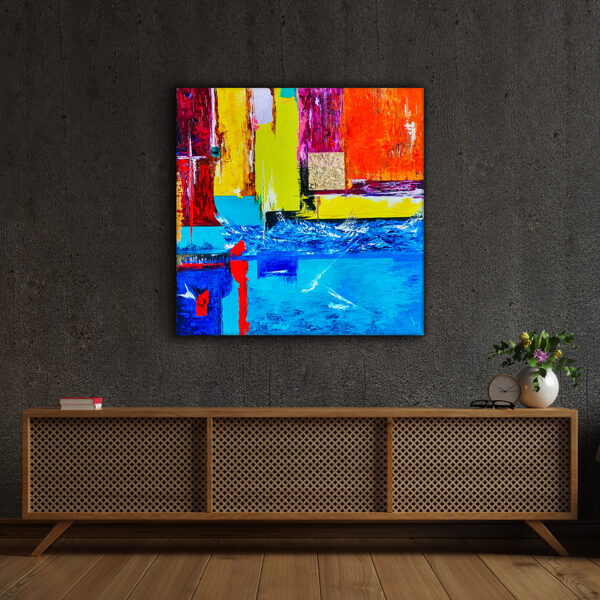
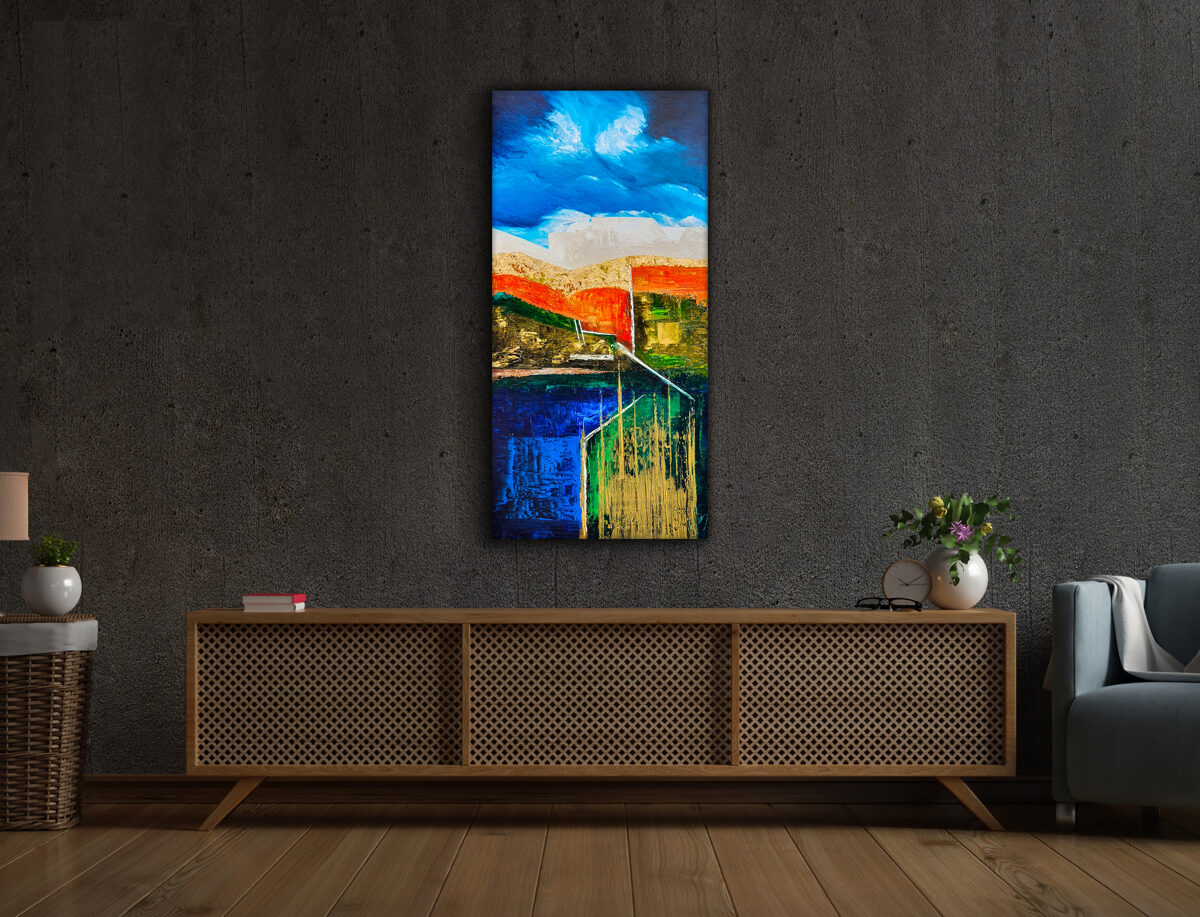
The abstraction once again employs the technique of cross-sectioning to illustrate, rather than alternative methods like a perspective presentation. The artist conveys the message with a diverse set of tools. The depiction of the sky involves classical brushwork with dramatic effects, almost photorealistically, yet this seems to be contradicted by the opening of divine heights, symmetrically accompanied by angelic wings. Directly below, surreal and hyperabstract forms of sandstone and limestone buildings emerge. Beneath the golden Byzantine soil and the orange-red of fertility, the work of engineers becomes visible, unfolding in a massive underground water reservoir. The upward-flowing golden flood, along with the altar, seals the destined unity of heaven and the depths below.
Photos of the artwork:
Cart is empty.